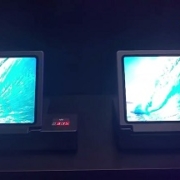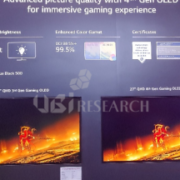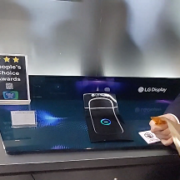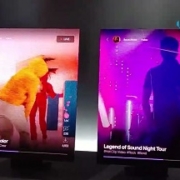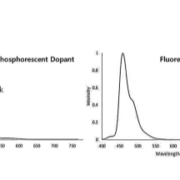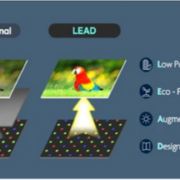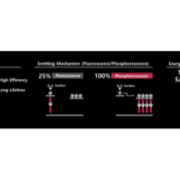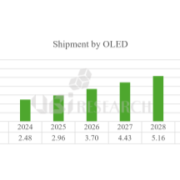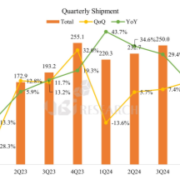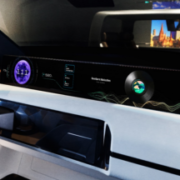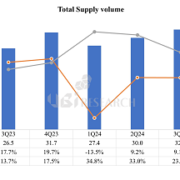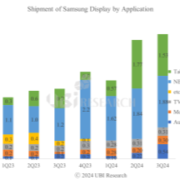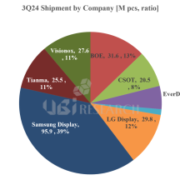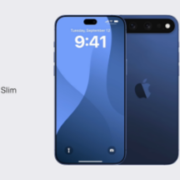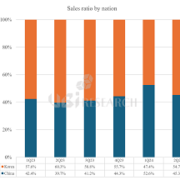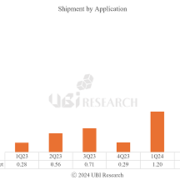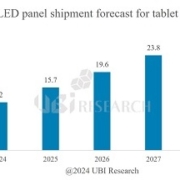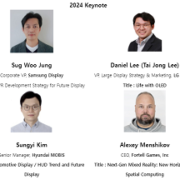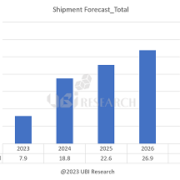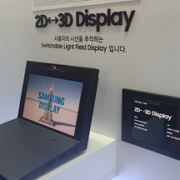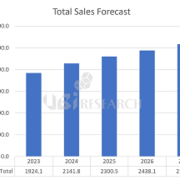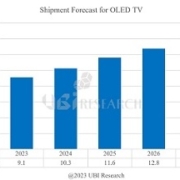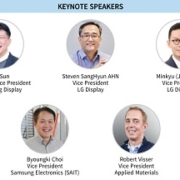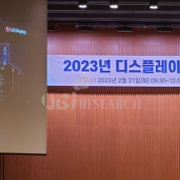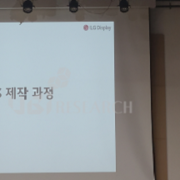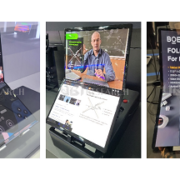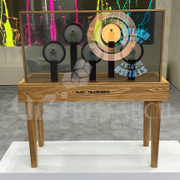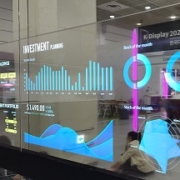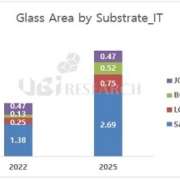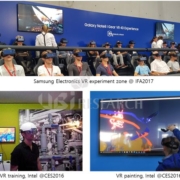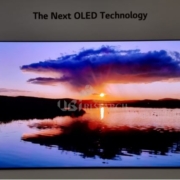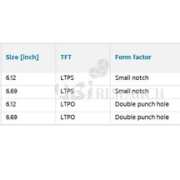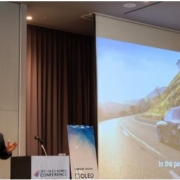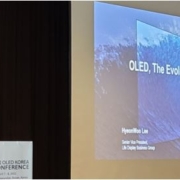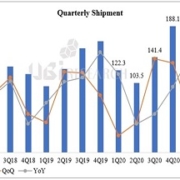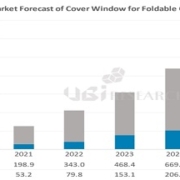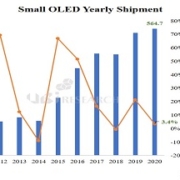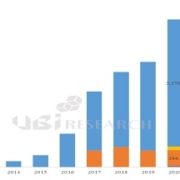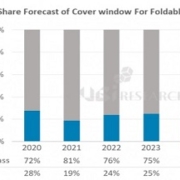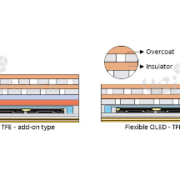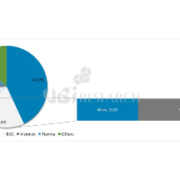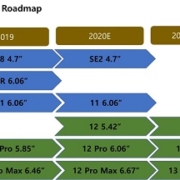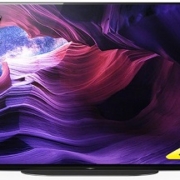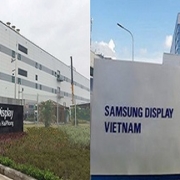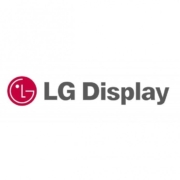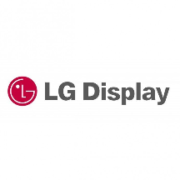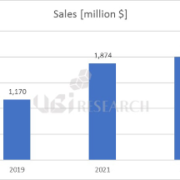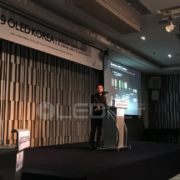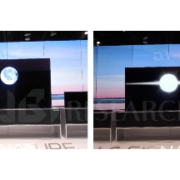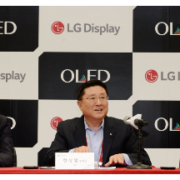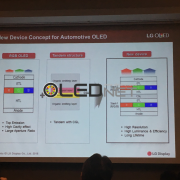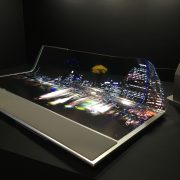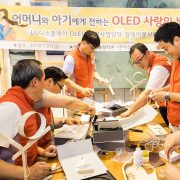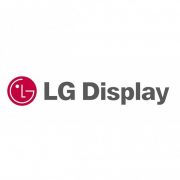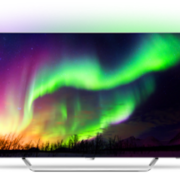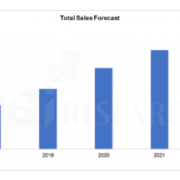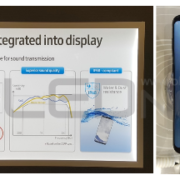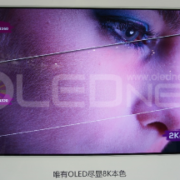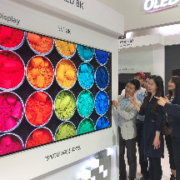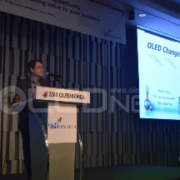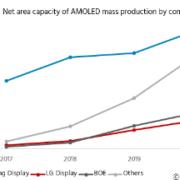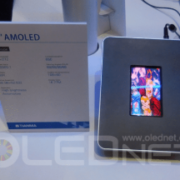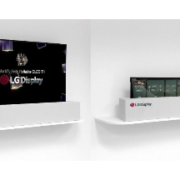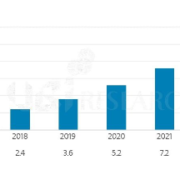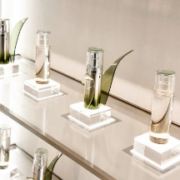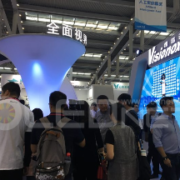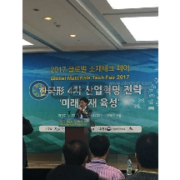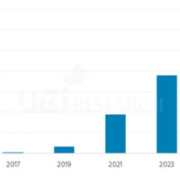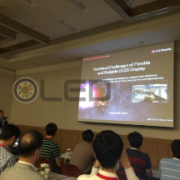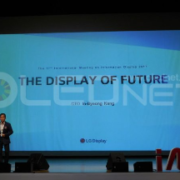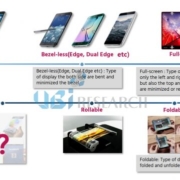Posts
LG Display showcased next-generation OLED under the theme of ‘Display technology that creates the future’ at ‘SID 2025’
/in Analyst column /by UBIResearchNetLG Display divided the SID 2025 exhibition hall into three zones to introduce the evolution of large OLED technology, vehicle display solutions targeting future mobility, and next-generation display technology for a sustainable future.
In the large OLED zone, the excellence of the 4th generation OLED panel and TV and gaming panels that applied it were showcased under the theme of ‘Another evolution for mainstream adoption.’ It achieved a maximum brightness of 4,000 nits by applying the ‘Primary RGB Tandem’ structure, a proprietary technology that independently stacks RGB devices to emit light. The ‘27-inch gaming OLED’ was exhibited to allow visitors to experience LG Display’s evolved gaming OLED, such as improved brightness and color reproducibility, by comparing products that applied the existing 3rd generation OLED with new products that applied the 4th generation OLED.
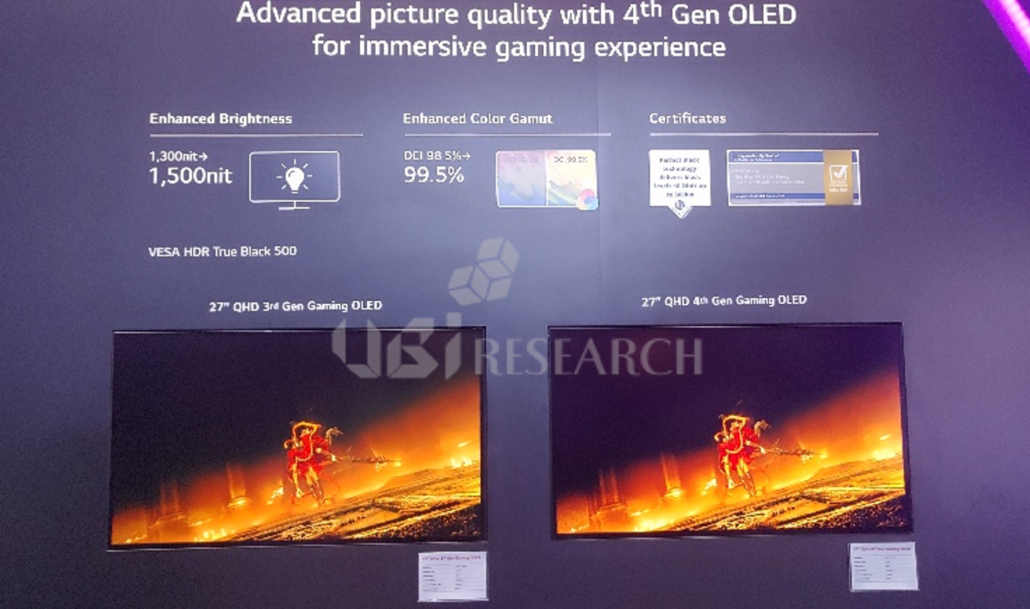
27-inch Gaming OLED: 3rd Gen vs 4th Gen OLED
The ‘45-inch 5K2K gaming OLED’ that provides the best gaming experience with the world’s highest resolution (5120×2160) was also unveiled. Approximately 11 million pixels are densely arranged on the 45-inch large screen to realize excellent picture quality, and it features a 21:9 ratio similar to a movie theater screen to provide a next-level sense of immersion. LG Display’s proprietary technology ‘DFR (Dynamic Frequency & Resolution)’ that can optimize various contents from gaming to watching movies with a single monitor also garnered attention. Depending on the content, you can freely choose between high refresh rate mode and high resolution mode.

45-inch DFR gaming monitor
The ‘stretchable display for vehicles’ offers the possibility of innovation in future mobility design by applying a stretchable display whose screen can be freely stretched to the vehicle’s center fascia area where existing physical buttons were located.
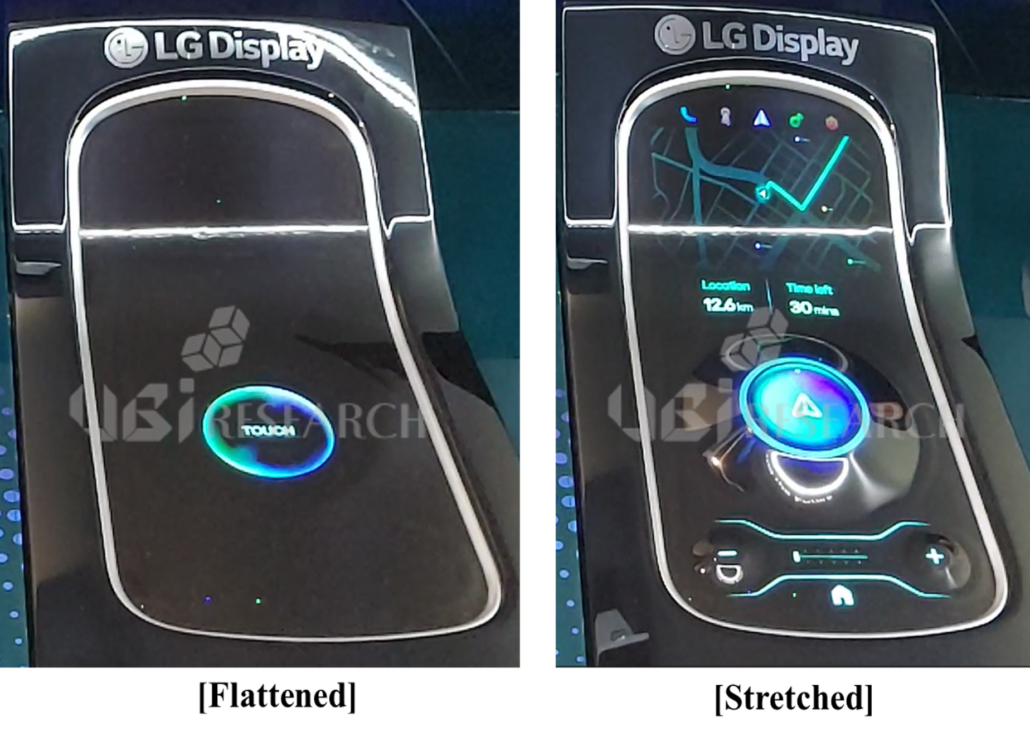
A concept car that applied a vehicle display optimized for SDV was introduced. The front seat dashboard of the concept car was equipped with an ultra-large 57-inch pillar-to-pillar that LG Display commercialized for the first time in the industry, and an ‘18-inch sliderable OLED’ was installed for rear seat entertainment. It secured reliability and durability that can operate normally even in extreme environments from -40 degrees Celsius to 85 degrees Celsius, making it suitable for use in vehicles.
In addition, under the theme of ‘Display for a Sustainable Future,’ a next-generation display that applied low-power technology and eco-friendly components was unveiled. The ‘16-inch Neo:LED panel for laptops’ implemented the best color reproducibility suitable for professionals from photography to video production, while developing and applying new LED technology to reduce power consumption. This significantly improved the battery efficiency of IT devices. In addition, a ‘14-inch laptop panel’ was unveiled that made 41% of the product weight out of eco-friendly materials to preserve the future environment. LG Display plans to increase the use of eco-friendly materials in this product to 50% by 2030. In addition, it introduced tiling technology using micro -LED through a demonstration of operating two 22-inch micro-LED panels as independent screens and seamlessly connecting the two panels to operate them as a single screen.

Chang Wook HAN, VP/Analyst, UBI Research(cwhan@ubiresearch.com)
Summary of LG Display’s Hybrid Phosphorescent Blue Tandem Public Patent
/in Material, Material, Material, Material, Material, Material, Material /by UBIResearchNetIf we look at the contents of the recently published hybrid phosphorescent blue tandem patent, it is evaluated as a patent that can apply phosphorescent blue to product production at an early stage. This is because it uses a luminescent material that has been verified and can be mass-produced by a material company, and the current OLED deposition system optimized for mixed host can be used as is.
The main contents of the patent are that
– The phosphorescent emitting layer must be configured at the top, and in this case, the efficiency index (blue index) increases by 1.7 times compared to the fluorescent blue tandem. (If the phosphorescent emitting layer is located at the bottom, the efficiency index increases by only 1.4 times.)
– The thickness of the fluorescent emitting layer must be 60% or less of the phosphorescent emitting layer thickness.
– As shown in the figure below, the blue phosphorescent dopant spectrum must have a second peak intensity of 50% or less of the first peak intensity.
– The difference between the highest intensity wavelength of the phosphorescent dopant and the highest intensity wavelength of the fluorescent dopant must be 20 nm or less.
We look forward to seeing LG Display’s blue phosphorescent panel, which has completed product verification, at Display Week 2025.
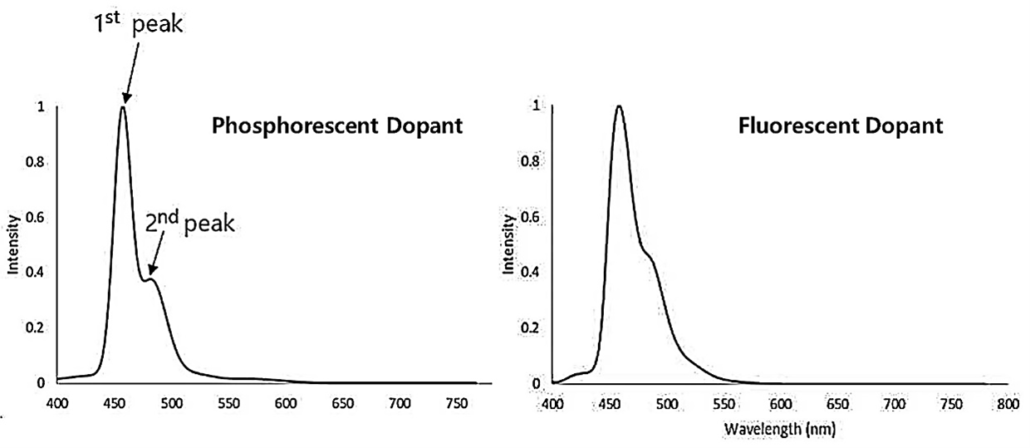
Chang Wook HAN, VP/Analyst, UBI Research(cwhan@ubiresearch.com)
Preview of SID 2025
/in /by UBIResearchNetSamsung Display’s ‘LEAD™’, the world’s first non-polarized OLED technology commercialized, has won the ‘Displays of the Year (DIA)’ award from the Society for Information Display (SID). ‘LEAD™’ is an OCF (On Cell Film) technology that replaces the polarizer, an opaque plastic sheet, and has been praised for improving brightness, enhancing outdoor visibility, and making the panel 20% thinner.
Samsung Display is actively marketing its proprietary technology to the market through the brand name ‘LEAD™’, which includes the four representative characteristics of this technology: ▲Low Power Consumption ▲Eco-Friendly ▲Augmented Brightness ▲Designed to Slim & Light.

SDC LEAD™ Technology
LG Display plans to showcase the world’s best vehicle display optimized for future mobility under the theme of ‘Expanding business through new technology (Driving the future)’.
With ▲Vehicle stretchable display solution that can display all spaces in a vehicle, it proposes design innovation possibilities suitable for future mobility. The stretchable display, which implements high-resolution 100ppi (pixels per inch) and red, green, and blue (RGB) full colors at the same time as a general monitor while the screen can be stretched by up to 50%, has been applied to the center fascia area of the vehicle to maximize aesthetics and convenience.
LG Display, which recently succeeded in commercializing the world’s first ’40-inch pillar-to-pillar’, is exhibiting ▲57-inch vehicle pillar-to-pillar, the world’s largest single panel. ▲18-inch sliderable OLED unfolds from the ceiling down only when needed. It implements entertainment functions with OLED’s unique three-dimensional picture quality and provides a new mobility experience. In the trend of larger vehicle displays, we introduce ▲SPM (Switchable Privacy Mode) mode, a key technology that enhances safety by controlling viewing angles.

LG Display Automotive Stretchable Micro-LED Display
Chang Wook HAN, VP/Analyst, UBI Research(cwhan@ubiresearch.com)

LG Display Hybrid Phosphorescent Blue Tandem Product Verification and Patent Application
/in /by olednetLG Display announced on May 1 that it had successfully verified the performance of a blue phosphorescent OLED panel for mass production for the first time in the world. Following the development of blue phosphorescence in collaboration with UDC last year, this achievement was made in just 8 months, and it is evaluated as one step closer to realizing the ‘dream OLED’.
LG Display solved this problem with a hybrid two-stack tandem structure that stacks blue fluorescent material on the lower layer and blue phosphorescence on the upper layer. By adding the stability of the fluorescent method and the low power of the phosphorescent method, it maintained the stability of the existing OLED panel while reducing power consumption by about 15%.
In particular, LG Display is the first company to have successfully completed the productization stage, which requires performance evaluation, optical characteristics, and fairness on an actual mass production line, and has already completed product verification with UDC.

(Source: LG Display)
LG Display has exclusively applied for a hybrid phosphorescent blue tandem technology patent in both Korea and the United States. According to LG Display’s published patent, the hybrid phosphorescent blue tandem is shown to achieve efficiency that is about 1.7 times higher than the existing fluorescent blue tandem. In order to optimize efficiency, color coordinates, and lifespan, the spectral shape of the blue phosphorescent dopant, the thickness ratio of the fluorescent layer and the phosphorescent layer, and the location of the emitting layer are important, and the patent rights the technology content centered on these factors. It is evaluated as a patent that optimizes the commercialization of the hybrid phosphorescent blue tandem by utilizing high-efficiency phosphorescence and long-life fluorescence.
LG Display’s OLED panel with hybrid two-stack tandem applied can be seen at the world’s largest display event, ‘SID (Society for Information Display) 2025’, held in San Jose, California, USA from the 11th of this month (local time). The products on display this time are small and medium-sized panels that can be applied to IT devices such as smartphones and tablets. As the number of products that require both high image quality and high efficiency, such as AI PCs and AR/VR devices, is increasing, the application of blue phosphorescence technology is expected to expand rapidly.
Yoon Soo-young, CTO (Executive Vice President) of LG Display, said, “The success of the verification of blue phosphorescence productization, which is called the last puzzle for the dream OLED, will be an innovative milestone toward next-generation OLED,” and “We expect to be able to enjoy the effect of preempting the future market with blue phosphorescence technology.”
Chang Wook HAN, VP/Analyst, UBI Research(cwhan@ubiresearch.com)
OLED Automotive Display Shipments to Hit 2.48 Million Units in 2024: Up 126% YoY
/in Focus on /by olednetIn the ‘2025 Automotive Display Technology and Industry Trends Analysis Report’ by UBI Research, various technologies, companies, and market trends of automotive displays were introduced. In 2024, global shipments of automotive display panels reached 236 million units, an 8.3% increase from the previous year. It is expected to reach 241.8 million units in 2025. In 2024, OLED panel shipments reached approximately 2.48 million units, an increase of 126% from the previous year.
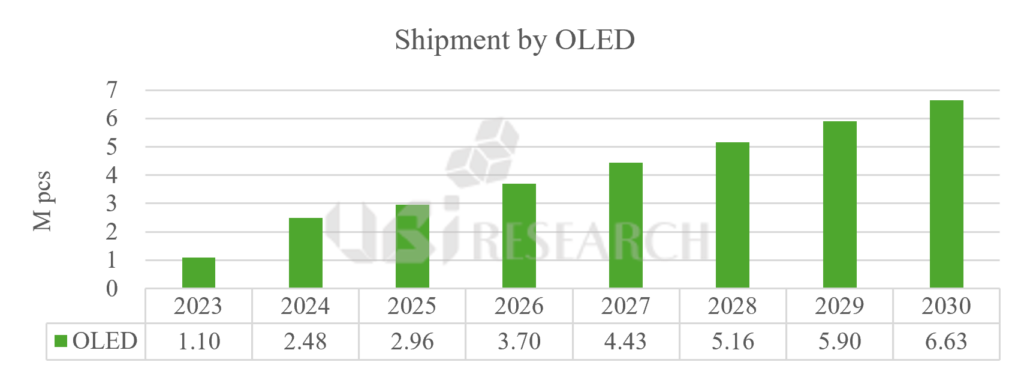
This is because OLED displays can contribute to the sophistication and efficiency of vehicle interior design, so OLEDs are actively adopted, especially in premium cars. Hyundai Motor Company’s Genesis GV80 vehicle, released last year, applied a 27-inch OLED display produced by LG Display. In addition, Nio, a Chinese EV car manufacturer, will adopt a 15.6-inch OLED and a 14.5-inch OLED display for passengers in its 2025 ET9 model.

27-inch OLED mounted on Genesis GV80 (source: Hyundai Motor Company)
As the entertainment use of vehicle displays increases, LCD displays are increasingly adopting Mini-LED with local dimming to provide a contrast ratio similar to OLED. In 2024, Mini-LED panel shipments was more than double to 3.4 million units compared to the previous year. Sony Honda Mobility’s electric vehicle, AFEELA, to be released in 2026, will use a 40-inch Pillar-to-Pillar Mini-LED display provided by LG Display.
“Software-defined vehicles (SDVs) require high resolution, low power, AR, and multi-display performance, and they require real-time data provision and optimized user experience. Accordingly, the adoption of OLED displays suitable for this will continue to expand, and vehicle OLED panel shipments will reach approximately 3 million units in 2025,” said Chang Wook Han, Executive Vice President of UBI Research.
Chang Wook HAN, VP/Analyst, UBI Research(cwhan@ubiresearch.com)

Apple iPhone 18 series, release schedule adjusted by specifications
/in /by olednet
Apple iPhone 16 (Source: Apple)
It is anticipated that Apple will delay the launch of the standard model in the iPhone 18 series, which is expected to be released in 2026.
Until now, Apple has released four models for each iPhone series: the standard model, Max, Pro, and Pro Max. In the 2025 iPhone 17 series, the Max model is expected to be replaced by a new Air model, and the Air model is projected to be the most expensive among the four.
While four smartphone models are expected to be released through 2025, it is now anticipated that the standard model will not be launched in 2026 and will be postponed to 2027.
In 2026, when Apple is expected to release the iPhone 18 series, the company is also likely to introduce its first foldable phone. Since the launch of the foldable phone could disperse sales volume, this strategic move seems to be under consideration.
If the release of the iPhone 18 standard model is delayed to the first half of 2027, it is expected to launch alongside the successor to the iPhone 16e, which is also anticipated to debut around that time. In this scenario, Apple would release higher-end models—such as the Pro, Air, and foldable phone—in the second half of the year, and lower-priced models in the first half of the following year, thereby securing different sales routes throughout the year.
Should Apple adopt this biannual product release strategy, it may affect the performance of panel suppliers such as Samsung Display, LG Display, and BOE. Historically, the release of the iPhone series in Q3 boosted the earnings of Korean panel makers starting in the third quarter, peaking in Q4. However, if new iPhone models are also released in the first half going forward, the earnings gap between the first and second halves of the year may narrow. On the other hand, if BOE continues to fall short in technology and only supplies panels for the standard model, its strong performance in the second half may shift to the first half instead.
Junho Kim, UBI Research analyst(alertriot@ubiresearch.com)
OLED material usage in 2024 will reach a record 130 tons, surpassing 200 tons in 2028
/in /by olednet
1Q25 Quarterly OLED Emitting Material Market Tracker
According to UBI Research’s “1Q25 Quarterly OLED Material Market Tracker,” the amount of emitting material used in 2024 was 130 tons. Shipments from Korean and Chinese panel makers increased simultaneously, up nearly 30% from 2023.
By company, Samsung Display continues to hold the largest share, and its rigid OLED shipments have been rising rapidly, driving material usage higher and higher. Samsung Display accounted for 42% of the total OLED emission materials market by volume, followed by LG Display at 20% and BOE at 13.2%.
While Korean panel makers still dominate in terms of material usage, Chinese panel makers are not far behind. In China, OLED shipments for smartphones from BOE, TCL CSOT, Tianma, Visionox, and EDO grew at a CAGR of 51% from 114 million units in 2021 to 394 million units in 2024. In addition, as Chinese panel makers such as BOE and EDO have recently begun supplying OLED panels for IT, the consumption of luminescent materials by Chinese panel makers is expected to increase even more steeply.
“In 2025, Samsung Display and LG Display are expected to ship more panels for iPhones than in 2024, and the overall shipments of IT devices such as tablet PCs, notebooks, and monitors are expected to increase significantly compared to 2024, so the growth of the luminescent material market is expected to continue for a while,” said Dr. Changho Noh of Ubi Research. “Additionally, with the expansion of mass production of OLEDs for IT by Chinese panel companies, the luminescent material market is expected to exceed 200 tons by 2028.”
Chang Ho NOH, UBI Research Analyst(chnoh@ubiresearch.com)
Small OLED display shipments in 2024 are expected to increase by 200 million units compared to 2023 and exceed 1 billion units in 2025
/in /by olednet
‘1Q25 Small OLED Display Market Track’
According to UBI Research’s ‘1Q25 Small OLED Display Market Track’, which includes application performance and outlook for smartphones, foldable phones, smartwatches, etc., small OLED shipments in 2024 are expected to reach 980 million units, an increase of approximately 200 million units from 773 million units in 2023. The small OLED market is expected to exceed 1 billion units in 2025.
Looking at the 2024 performance, most panel manufacturers in Korea and China saw an increase in shipments of 40 to 50 million units, and in particular, Chinese panel manufacturers TCL CSOT, Tianma, Visionox, and Everdisplay saw shipments increase by more than 50% compared to 2023. BOE, China’s largest panel manufacturer, saw its panel shipments increase by only about 8% due to temporary production suspensions caused by disruptions in iPhone supplies throughout the year.
Not only Chinese panel makers, but also Korean panel makers have seen a significant increase in shipments. As rigid OLED panels began to be applied to Samsung Electronics’ Galaxy A series, Samsung Display’s shipments are expected to surge from 320 million units in 2023 to 380 million units in 2024. LG Display’s smartphone OLED shipments also increased from 52 million units in 2023 to 68 million units in 2024 as its supply of panels for iPhones expanded.
With Chinese panel makers’ shipments steadily increasing, and Samsung Display’s rigid OLED shipments and LG Display’s iPhone panel shipments also increasing, small OLED shipments in 2025 are expected to easily exceed 1 billion units.
“OLEDs are being widely applied to lower-end models of Samsung Electronics’ Galaxy A series and low-cost models from Chinese set manufacturers, and BOE and Visionox’s new 8.6G lines are also designed to produce panels for smartphones, so small-sized OLED shipments are expected to continue to rise for the time being,” said Han Chang-wook, Vice President of UBI Research.
Chang Wook HAN, VP/Analyst, UBI Research(cwhan@ubiresearch.com)
Moving forward with ultra-large vehicle displays
/in Focus on, Focus on, Focus on, Focus on, Focus on, Focus on, Focus on, Focus on, Focus on, Focus on, Focus on, Focus on, Focus on, Focus on, Focus on, Focus on, Focus on, Focus on, Focus on, Focus on, Focus on, Focus on, Focus on, Focus on, Focus on, Focus on, Focus on, Focus on, Focus on, Focus on, Focus on, Focus on, Focus on, Focus on, Focus on, Focus on, Focus on, Focus on, Focus on, Focus on, Focus on, Focus on, Focus on, Focus on, Focus on, Focus on, Focus on, Focus on, Focus on, Focus on, Focus on, Focus on, Focus on, Focus on, Focus on, Focus on, Focus on, Focus on, Focus on, Focus on, Focus on, Focus on, Focus on, Focus on, Focus on, Focus on, Focus on, Focus on, Focus on, Focus on, Focus on, Focus on, Focus on, Focus on, Focus on, Focus on, Focus on, Focus on, Focus on, Focus on, Focus on, Focus on, Focus on, Focus on, Focus on, Focus on, Focus on, Focus on /by olednetNot only are vehicle displays increasing in size and number, but pillar-to-pillar displays, which integrate multiple displays on the dashboard into a single screen, have recently been applied to automobiles. Pillar-to-pillar displays have the advantage of enhancing the competitiveness of premium automobile brands through simple and stylish interiors, and allowing users to enjoy movies and games in the car through large screens. The Geely Galaxy E8 EV, launched last year, is equipped with a 45-inch pillar-to-pillar display. The display is a panel with amorphous silicon TFTs and Mini-LEDs and was supplied by BOE.
Sony Honda Mobility’s upcoming 2026 electric vehicle, AFEELA, will feature a 40-inch pillar-to-pillar display. The 40-inch pillar-to-pillar display panel with LTPS TFT and Mini-LEDs is provided by LG Display.

(Source: LG Display)
TPS TFTs have the advantage of faster mobility than amorphous silicon TFTs, making it easier to create high-resolution, high-brightness panels and reducing the black border, known as the bezel. And Mini-LEDs that utilize localized dimming are more expensive as the number of chips increases, but they offer OLED-like image quality with higher contrast and reduced thickness, which is important for external viewability.
“The share of LTPS TFTs in automotive displays was 34.7% in 2024 by revenue and will grow to 52.3% by 2030,” said Chang Wook Han, principal analyst at UBI Research. “The share of Mini-LEDs in automotive displays was 6.4% in 2024 and will increase to 29.1% by 2030,” said Han.
Chang Wook HAN, UBI Research Analyst(cwhan@ubiresearch.com)

The purchase volume of OLED emitting materials in the third quarter of 2024 is expected to reach 32.7 tons, the highest ever purchase volume of emitting materials in 2024
/in /by olednet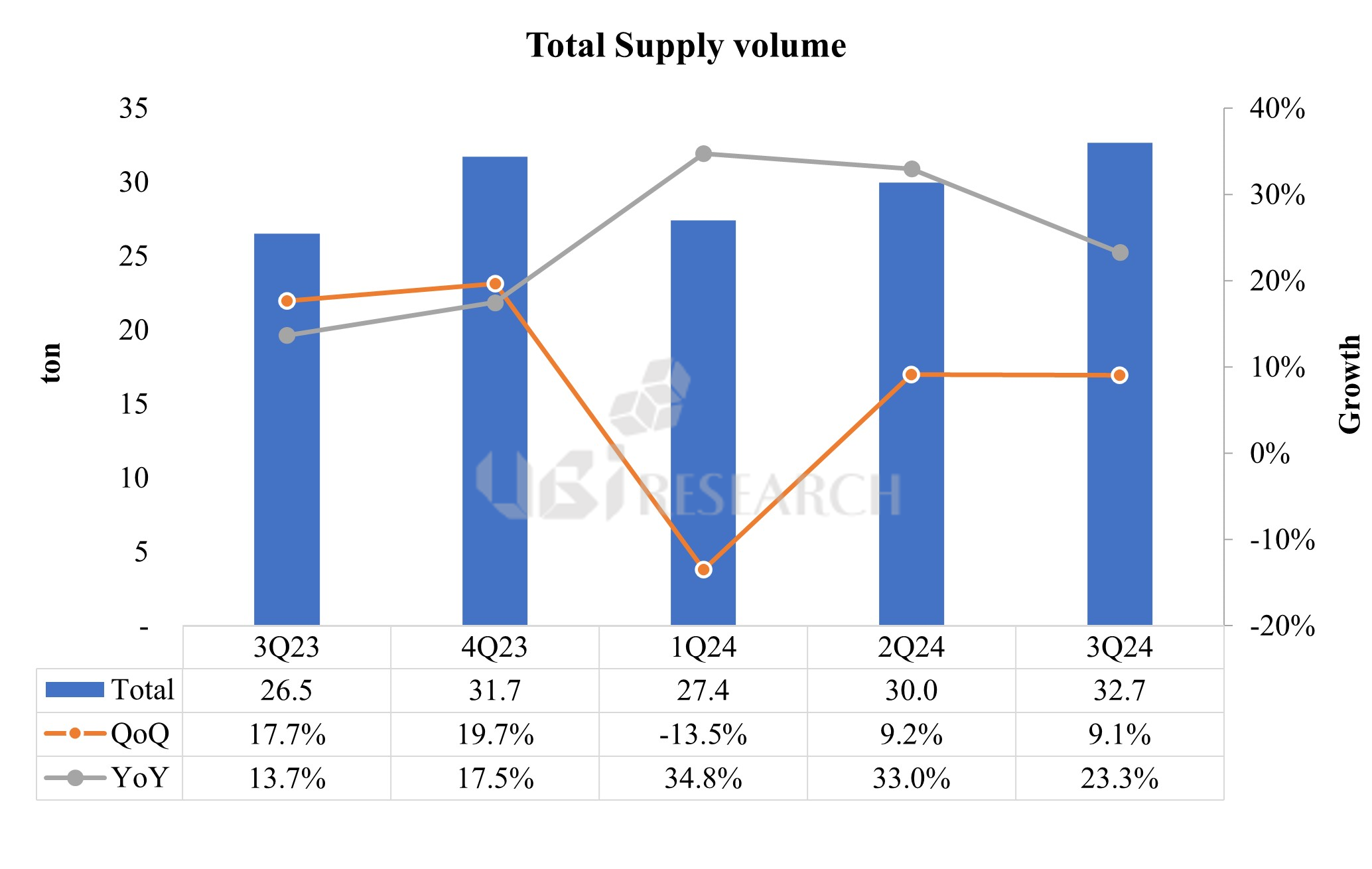
According to UBI Research’s ‘4Q24_Quarterly OLED Emitting Material Market Tracker’, the purchase volume of emitting materials in the third quarter of 2024 was calculated to be 32.7 tons. Previously, material purchases were highest in 2021, when the market expanded due to COVID-19, but the all-time high was renewed in the third quarter of 2024. Considering the characteristics of OLED emitting materials, which show the highest usage in the fourth quarter of every year, it is expected that 2024 will see the highest usage ever.
Looking at each company, Samsung Display consistently holds the highest market share. Samsung Display had a 41.4% share in the entire OLED emitting material market based on purchase volume, followed by LG Display with 20.5%, BOE with 11.6%, and Visionox with 8.3%.
By substrate, RGB OLED still maintains the 80% level with a market share of 83.7% based on purchase volume, and as 8.6G lines begin to operate in earnest, RGB OLED’s market share is expected to gradually decline. WRGB-OLED’s market share was 11.3%, similar to the second quarter, and QD-OLED’s market share was 2.8%.
The market share of RGB 2 stack tandem OLED once rose to 6.4% in the second quarter due to a surge in iPad Pro OLED shipments but fell to the 2.2% range in the third quarter due to low demand. Compared to panel shipments, IT devices that use 2-stack tandem OLED for smartphone OLED, which uses single stack OLED, have large panel areas and have two light-emitting layers, so material purchase volume accounted for a higher share than shipment volume.
However, as BOE’s 8.6G line was confirmed to supply OLED for smartphones first, the growth of the 2 stack tandem OLED market was in the hands of Samsung Display. Starting in 2026, when OLED is expected to be applied to MacBook Pro, the purchase amount of light emitting materials applied to 2 stack tandem OLED is expected to more than double compared to 2024. The 2-stack tandem OLED panel supplied to MacBook Pro is expected to be supplied first by Samsung Display.
Junho Kim, UBI Research analyst(alertriot@ubiresearch.com)
Samsung Display’s Auto OLED shipments surge, sales remain strong even as tablet PC panel shipments decrease
/in /by olednet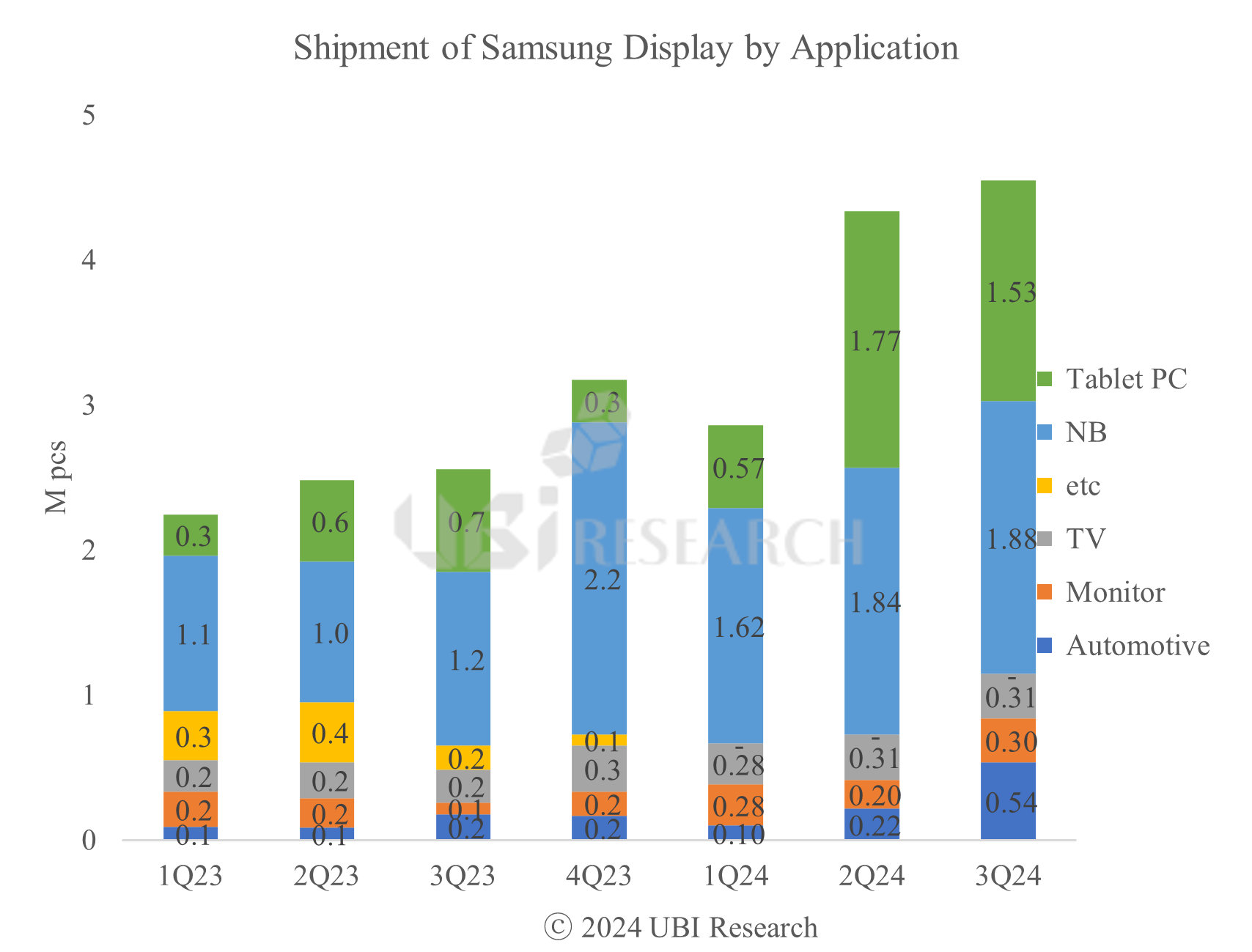
UBI Research ‘4Q24 Medium & Large OLED Display Market Track’
Samsung Display’s mid- to large-sized OLED shipments and sales in the third quarter were similar to those in the second quarter. Due to low sales of iPad Pro OLED, OLED shipments for tablet PCs decreased, but shipments increased in other applications and sales remained at a similar level. Samsung Display supplies mid- to large-sized OLED products for a variety of applications, including not only tablet PCs but also notebooks, monitors, and automotive OLEDs.
According to UBI Research’s recently published ‘4Q24 Medium & Large OLED Display Market Track’, as iPad Pro OLED panels began to be mass-produced in earnest in the second quarter, the shipments and sales of mid-to-large-size OLED panels from Samsung Display and LG Display surged. However, in the third quarter, panel shipments plummeted due to low sales of iPad Pro OLED, leading to a sharp decline in tablet PC OLED shipments and sales for both panel companies.
OLED shipments for TVs and OLEDs for tablet PCs increased rapidly at the same time, and LG Display’s shipments, which achieved its highest quarterly performance since the fourth quarter of 2021, decreased by 34% compared to the previous quarter, and sales decreased by 23%. However, because OLED shipments for TV recovered compared to the previous year, mid- to large-sized OLED shipments increased by 124% and sales increased by 111% compared to the same period last year.
In the case of Samsung Display, tablet PC shipments and sales also decreased. Samsung Display supplies OLED for tablet PCs to Samsung Electronics and Apple. Although OLED shipments for tablet PCs to Samsung Electronics did not change significantly, panel supply to Apple decreased. Accordingly, sales for tablet PCs also decreased by 38% compared to the previous quarter, but sales were able to be maintained similar to the previous quarter due to increased sales of other applications. Among Samsung Display’s applications, the one that has grown the most is automotive OLED. Automotive OLED shipments are rapidly increasing to 100,000 units in the first quarter, approximately 200,000 units in the second quarter, and approximately 500,000 units in the third quarter.
Samsung Display’s mid- to large-sized OLED shipments, which are investing in 8.6G, are expected to increase further from the end of 2025. As Samsung Display advances the mass production of its 8.6G line to the end of 2025, market expansion is expected to accelerate further. The notebook and monitor markets, as well as tablet PC and auto OLED, are expected to grow rapidly upon Apple’s entry into the market.
Junho Kim, UBI Research analyst(alertriot@ubiresearch.com)
Small OLED shipments in the third quarter increased by 7.8% compared to the previous quarter, and LG Display’s shipments surged
/in /by olednet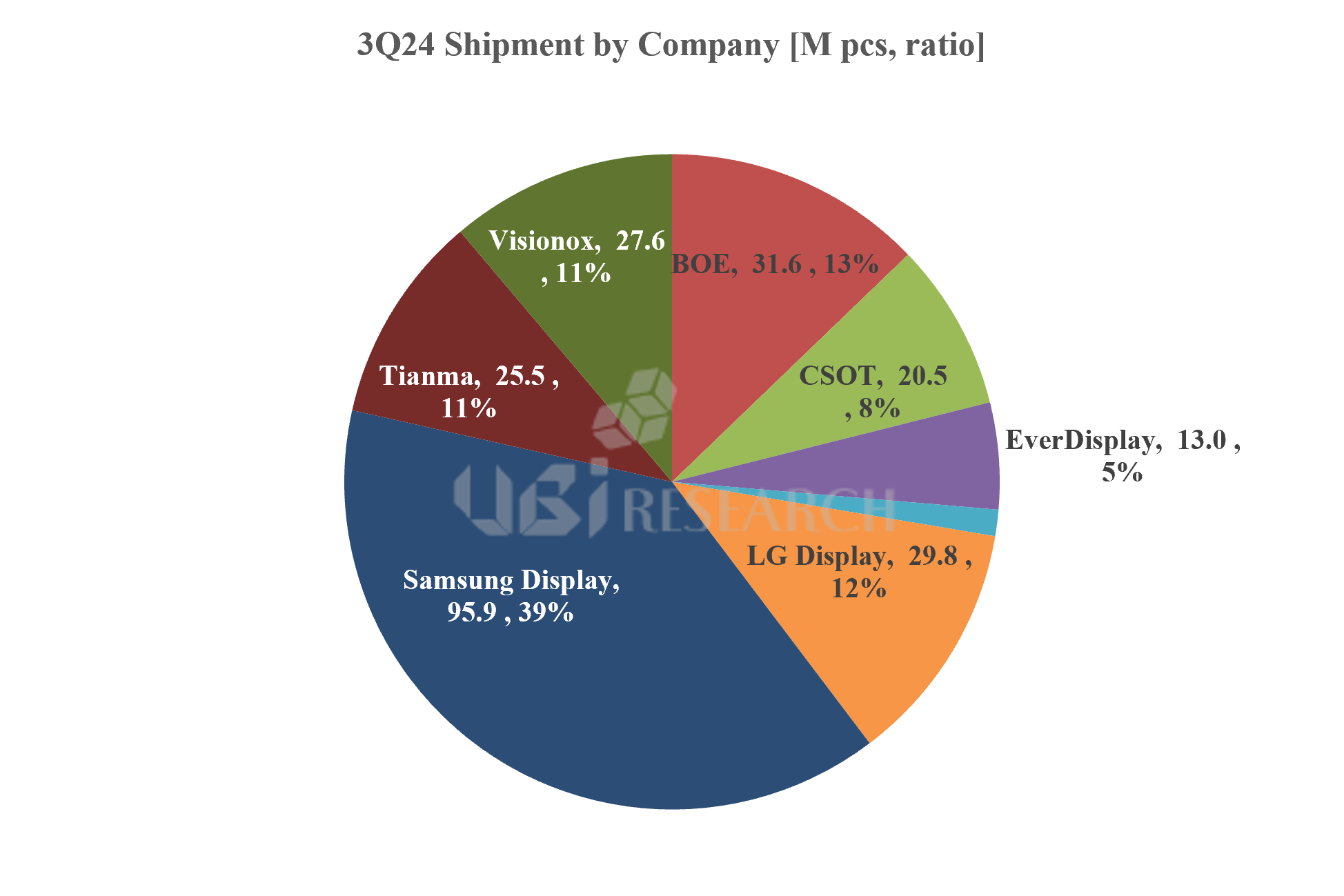
‘4Q24 Small OLED Display Market Track’
The small OLED market in the third quarter rose 7.8% compared to the previous quarter. Most panel companies recorded panel shipments at a similar level to the second quarter, but overall shipments increased as shipments from LG Display and China’s Everdisplay surged.
According to the ‘4Q24 Small OLED Display Market Track’ recently published by UBI Research, small OLED shipments in the third quarter of 2024 were 247 million units, up 7.8% compared to the previous quarter and 32.6% compared to the same quarter of the previous year. The shipments of Chinese panel companies, including Samsung Display and BOE, were similar to or slightly lower than the previous quarter, but as the shipments of LG Display and China’s Everdisplay surged, overall shipments increased.
Based on the iPhone 16 series, which began full-scale production, LG Display shipped 17.6 million iPhone panels, a 64% increase from the previous quarter, and smartwatch shipments increased 147% to 12.2 million units. Due to the impact of increased shipments, LG Display’s sales increased by 74% compared to the previous quarter and by 115% compared to the same quarter of the previous year.
LG Display’s shipments are expected to continue to increase next year following the fourth quarter. As LTPO TFT begins to be applied to the iPhone 17 series scheduled to be released in 2025, there are predictions that BOE’s initial panel supply will actually be difficult, and as BOE is unable to supply panels, the supply may be transferred to LG Display. However, since LG Display is currently producing panels close to full capacity, line expansion is necessary to produce more panels. There is an analysis that it is realistic to expand 6G lines because it is realistically difficult to quickly start investing in 8.6G.
Among Chinese panel companies, shipments of Everdisplay and Tianma increased. Tianma’s shipments increased, but only slightly, and Everdisplay’s shipments more than doubled to 13 million units compared to the previous quarter.
Samsung Display’s shipments decreased somewhat, but sales were similar to the second quarter, and BOE’s shipments were similar to the second quarter, but sales increased by 15%. In the fourth quarter, shipments from not only LG Display but also Samsung Display and BOE are expected to increase, and considering the characteristics of the OLED market with the highest shipment volume in the fourth quarter, global OLED shipments for smartphones are expected to exceed 800 million units in 2024.
Junho Kim, UBI Research analyst(alertriot@ubiresearch.com)
iPhone 17 series to be released in 2025, panels supplied by Samsung and LG Display, BOE still unknown
/in /by olednet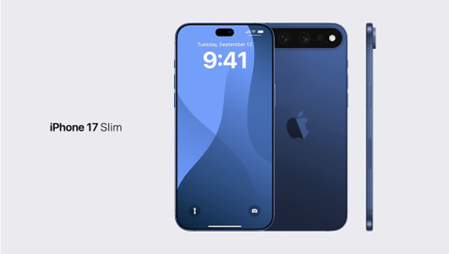
iPhone 17 Slim expected image (screen capture from @Apple Explained on YouTube)
It is expected that only two companies, Samsung Display and LG Display, will supply panels for the iPhone 17 series to be released next year. It is unclear whether BOE will be able to supply the new model, but it is expected that it will be difficult to obtain panel approval within 2025.
BOE was previously supplying the normal model iPhone 13~16 series. Although panel production for the iPhone 15 was temporarily halted in the middle of this year due to panel quality issues, it has resumed, and panels for the iPhone 16 have also been approved and are being mass-produced. However, unlike existing models where LTPO TFT was applied only to the Pro model, LTPO TFT is expected to start being supplied to all models starting from the iPhone 17 series. Accordingly, BOE, which lacks technology, will not be able to produce the normal model iPhone 17 in the early stages. It is expected to be difficult. In addition, it is expected that low-dielectric TFE will begin to be applied starting with the iPhone 17 series, but BOE is expected to have setbacks in the development of this technology.
As BOE’s volume decreases, Samsung Display and LG Display’s volume is expected to increase. Samsung Display is expected to produce all models of the iPhone 17 series, and LG Display is expected to produce the 17, 17 Slim (tentative name), and 17 Pro Max models. In 2025, Samsung Display is expected to produce 130 million panels for Apple, and LG Display is expected to produce 72 million panels. BOE plans to supply 65 million panels to Apple in 2025, but in reality, it is expected to supply 40 to 50 million panels, which is less than this.
Junho Kim, UBI Research analyst(alertriot@ubiresearch.com)
Korean OLED Panel Makers’ Emitting Material Purchases Reach 51.2% in H1, with a Modest Recovery Expected in H2
/in Material /by olednet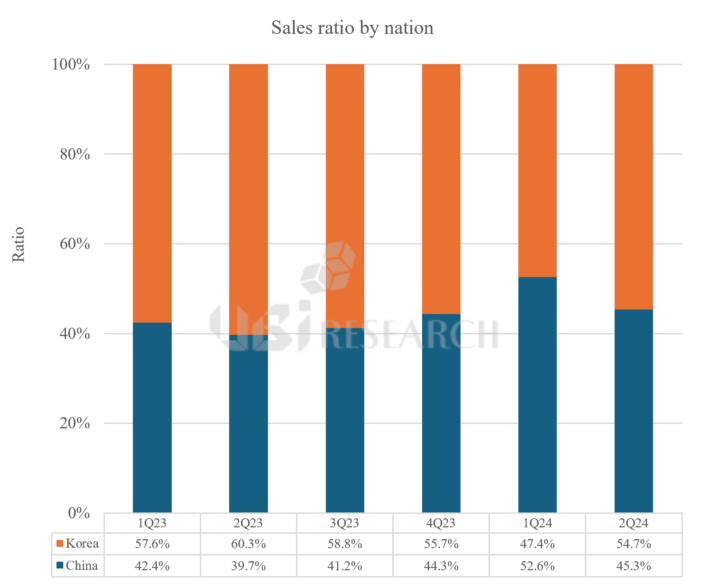
According to UBI Research’s recently published “3Q24 OLED Emitting Materials Market Track,” the purchase of emitting materials by Korean OLED panel manufacturers in the first half of 2024 totaled $495 million, representing 51.2% of the market share—a 7.8% decrease compared to the same period last year. This is a notable shift. Meanwhile, Chinese companies held 48.8% of the market share, up 7.8% year-on-year, with purchases amounting to $471 million.
As Chinese panel manufacturers ramp up shipments, the gap in the purchase of emitting materials between Korean and Chinese companies is steadily narrowing. In the first quarter of 2024, for the first time, Korean OLED panel companies’ share of emitting material purchases fell to 47.4%, lower than that of Chinese companies.
However, from the second quarter onward, with the increase in OLED panel shipments for IT devices and the production of panels for the iPhone 16 by Korean manufacturers, their share rebounded to 54.7%. While BOE passed the sample certification for the iPhone 16, the delay in mass production is expected to result in smaller shipments this year. Additionally, certification for the iPhone 16 Max, which was expected to be produced at BOE’s B12 factory, was not approved.
With the reduction in BOE’s iPhone shipments, Korean panel makers are likely to see an increase in panel shipments. Thanks to growing OLED panel orders from Apple for products like the iPhone and iPad Pro, Korean purchases of emitting materials are expected to rise to a 55.6% market share by the end of 2024, a notable increase compared to the first half of the year.
Due to the OLED iPad Pro for Tablet PC, shipments are rapidly increasing, and shipments are expected to increase by more than 6 times in 2024 compared to the previous year.
/in /by olednet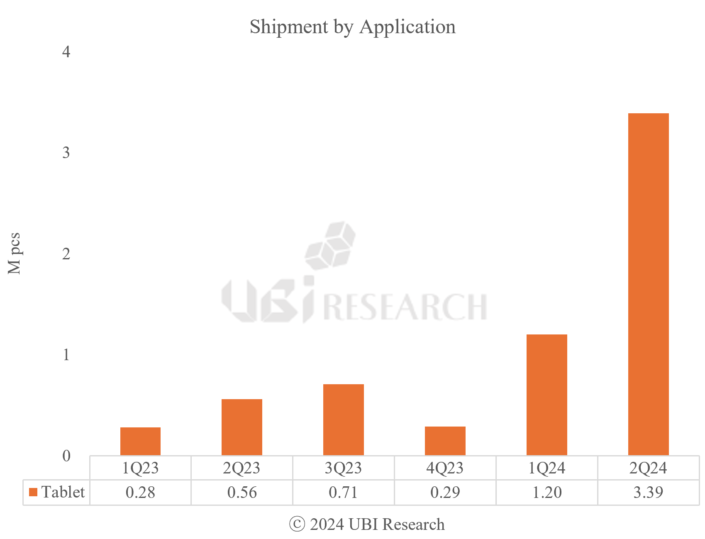
According to the “3Q24 Medium-Large OLED Display Market Track” published by UBI Research, more than 12 million OLEDs for tablet PCs are expected to be shipped in 2024 thanks to Apple’s entry into the OLED market for tablet PCs.
As mass production of iPad Pro OLEDs began in the first quarter of 2024, shipments of OLEDs for tablet PCs surged to 1.2 million units in the first quarter and 3.4 million units in the second quarter.
As not only Samsung Display and LG Display, but also Chinese panel manufacturers have begun mass production of OLEDs for tablet PCs, the OLED market for tablet PCs is expected to expand further. Among Chinese panel manufacturers, BOE is expected to ship about 1.5 million OLED panels for tablet PCs in 2024, and Visionox is expected to ship about 800,000 OLED panels for tablet PCs.
Due to the increase in panel shipments by Apple and Chinese companies, OLED shipments for tablet PCs are expected to exceed 30 million units in 2028.
OLED market for Tablet PCs to grow 6-7 times by 2024 due to Apple’s entry
/in /by olednet
OLED panel shipment forecast for tablet PC
According to the ‘2024 Mid-Large OLED Display Annual Report’ recently published by UBI Research, shipments of OLED panels for tablet PCs are expected to grow from 12 million units in 2024 to 28.4 million units in 2028, with an average annual growth rate of 24.1%.
OLED panel shipments for tablet PCs were 1.3 million units in 2022 and 1.8 million units in 2023, forming a small market. However, with the decision to install OLED in the Apple’s iPad scheduled to be released in 2024, Samsung Display and LG Display are producing OLED panels for iPad-oriented table PCs.
Samsung Display produces panels for the 11-inch model and LG Display produces panels for the 12.9-inch model. Due to Apple’s entry, the OLED market for tablet PCs is expected to grow 6 to 7 times in 2024 compared to 2023.
In addition, panel companies are actively investing to apply OLED not only to tablet PCs but also to various IT products. Following Samsung Display’s recent investment in the 8.6G IT line, BOE also invested in the 8.6G IT line, and LG Display is also conducting a paid-in capital increase to secure funds for IT line investment and is planning to sell the Guangzhou LCD line. The OLED market for IT is expected to expand further due to the aggressive investment of panel companies.
International Business Conference: 2024 OLED Korea & 2024 eXtended Reality Korea will be held in parallel!
/in /by olednet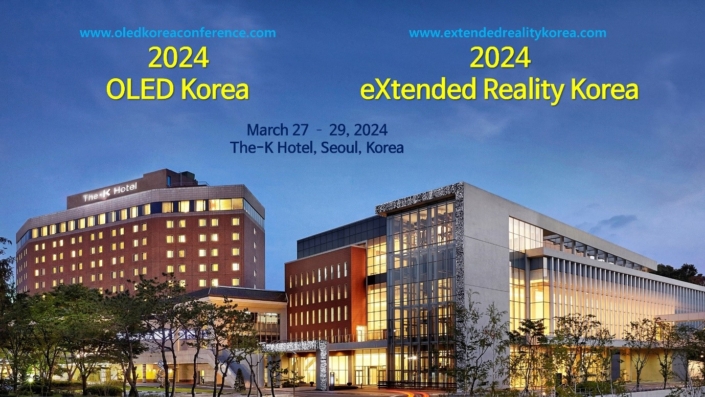
UBI Research, a display specialist research company, will hold the international business conferences OLED Korea and eXtended Reality Korea in parallel at The-K Hotel in Yangjae, Seoul from March 27 to 29, 2024. This event is expected to be an opportunity for people from companies, academia, and research institutes related to the display industry around the world to attend, exchange the best information, and form a global network.
eXtended Reality Korea is the first XR industry-related business conference held by UBI Research and will cover trends and outlook on micro display, XR Hardware/Software, materials, equipment, etc.
This event aims to provide attendees with the opportunity to deeply explore the display and XR areas through a comprehensive program including tutorials, keynote presentations, and panel discussions.
The tutorial on March 27th will feature presentations on the future of XR, micro LED display technology, and key technologies to realize the next generation OLED display.
In addition, keynote presentations by ▲UBI Research, ▲Samsung Display, ▲LG Display, ▲Hyundai Mobis, and ▲Fortell Games are scheduled for the conference to be held on March 28th and 29th. Choong-Hoon Yi, CEO of UBI Research, will give a presentation on “OLED and XR industry outlook.” We will present the overall OLED industry, including OLED for IT, and the micro OLED industry that will be applied to MR equipment.
Samsung Display plans to introduce SDC’s roadmap for expanding the AR/VR market based on SDC’s plan to overcome technical obstacles in ultra-high-resolution displays under the title “AR/VR Development Strategy for Future Display.”
Under the theme of “Life with OLED,” LG Display will examine the field of OLED displays applied in daily life and present the continuous evolution and benefits of OLED technology.
Under the theme of “Automotive Display / HUD Trend and Future Display,” Hyundai Mobis presents trends and requirements for automotive displays, from Pillar To Pillar displays to Rollable displays, predicts future automotive displays, and announces development strategies.
Lastly, Fortell Games will discuss the topic of “Next-Gen Mixed Reality: New Horizons for Spatial Computing”, analyzing the latest developments in mixed reality technology and their impact on the future of the gaming industry.
In addition, it will be run by a total of 34 domestic and foreign speakers and programs, including AR/VR development and technology, automotive displays, OLED industry, backplane technology, and MicroLED display development.
Because it is a parallel event, attendees can attend both events even if they register for one event, and registration is possible at a special discount price during the early bird period until February 29th.
Detailed information can be found on the website (https://oledkoreaconference.com/, https://extendedrealitykorea.com/).
In 2028, the OLED emitting material market is expected to reach $2.43 billion with an average annual growth rate of 5.8%
/in /by olednetAccording to the ‘4Q23_Quarterly OLED Emitting Material Market Tracker’ recently published by UBI Research, the market for emitting materials used in OLED is forecasted to grow from $1.84 billion in 2023 to $2.43 billion in 2028, with an average annual growth rate of 5.8%.
By country, Korean panel companies’ material purchases are expected to grow at an average annual growth rate of 4.2% from $1.11 billion in 2023 to $1.36 billion in 2028, and Chinese’ material purchases are expected to increase from $730 million in 2023 to $1.07 billion in 2028.
As forecasted, the material purchase ratio by country in 2028 will be 56% in Korea and 44% in China. However, Chinese panel companies are mainly mass producing panels for Chinese domestic use and white boxes, so even if panel shipments increase in the future, low-priced materials will be used. So, there is a possibility that the expansion of China’s emitting material market will be reduced further than currently expected.
Lastly, UBI Research predicted that Samsung Display’s purchase of emitting materials in 2028 will reach $810 million, LG Display’s will reach $550 million, and BOE will reach $440 million.
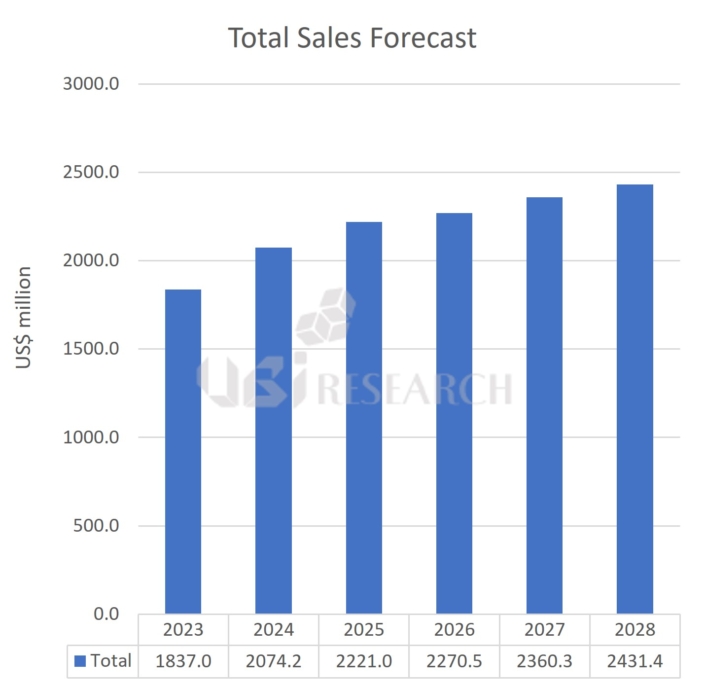
OLED emitting material market
OLED shipments for IT are expected to reach 31 million units in 2027, with an average annual growth rate of 41%
/in /by olednetAccording to the ‘IT OLED Technology and Industry Trend Analysis Report’ recently published by UBI Research, OLED shipments for tablet PCs, notebooks, and monitors are expected to reach 31 million units in 2027 with an average annual growth rate of 41%.
This forecast is based on Samsung Display’s 5.5G OLED line, 6G OLED line, 8.5G QD-OLED line, 8.6G (2290 x 2620 mm2) IT line, and LG Display, BOE, and Visionox’s 6G OLED line.
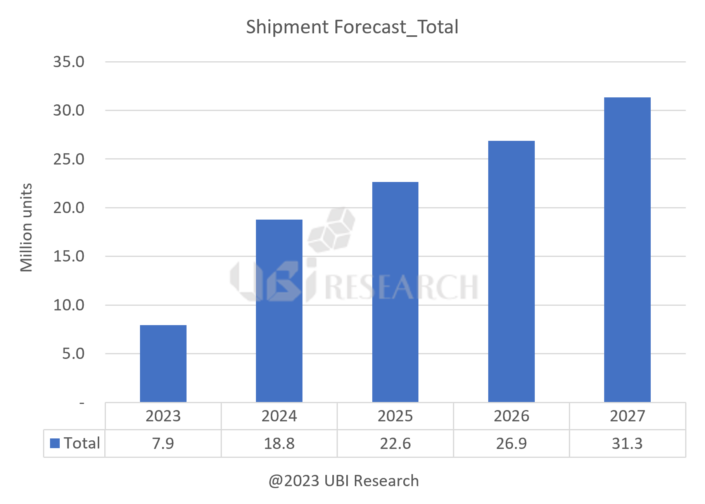
Shipment forecast for IT OLED
For IT products, OLED had been a market that received less attention than smartphones or TVs, but has began to receive significant attention due to the increase in demand for IT products in COVID-19 and the prospect of Apple using OLED for IT products.
Previously, Samsung Display was mass producing a small amount of OLED for IT from some of A2 as the 5.5G rigid OLED line and the 8.5G QD-OLED line, and some Chinese companies such as EDO were producing IT OLEDs in small quantities, but in 2024, Samsung Display and LG Display plan to mass produce OLED for Apple’s iPad in earnest from the 6G line, and BOE also plans to mass produce OLED for IT from the B12 line.
In addition, Samsung Display decided to invest in the 8.6G OLED line for IT early this year, and is expected to mass produce various IT products, including notebooks, from the first half of 2026.
Moreover, LG Display and BOE are planning to invest in the 8.6G line as soon as they secure investment funds and customers, and Visionox is also reportedly holding meetings with major equipment companies to invest in the 8.6G line.
If demand for OLED from set companies for IT increases in the future and panel companies invest in 8.6G lines, the IT market is expected to become a new high value-added market for OLED, following the smartphone market.

[IMID 2023 Keynote] LG Display’s automotive tandem OLED, applied to Hyundai Genesis
/in /by olednet
LG Display ‘Discovering the Best Automotive Display Solution for Tomorrow
At the ‘IMID 2023’ held in BEXCO, Busan on the 23rd, Kim Byeong-gu, head of LG Display’s Auto Business Group, gave a keynote speech on the theme of ‘Discovering the Best Automotive Display Solution for Tomorrow’.
“The electric vehicle market is expected to grow 18% annually from the current 15 million units, reaching 50 million units annually by 2030,” said Kim, head of the group. He also predicted, “The automotive display market is expected to grow by 10% annually and reach a market of 12 billion dollars by 2030, and in particular, the automotive OLED market will show a high annual growth rate of 28%.”
The number of displays mounted on vehicles is increasing every year, and the size is increasing every year. Kim said, “The number of displays installed in vehicles increases every year, and by 2030, an average of 2.3 displays will be installed, and the average size will be over 15 inches.”. And He also mentioned, “We will manufacture large-size OLEDs for vehicles larger than 50 inches within a few years.”

LG Display ‘Discovering the Best Automotive Display Solution for Tomorrow
Currently, LG Display is supplying luxury flagship P-OLED, premium OLED ATO (Advanced Thin OLED), and low-end LTPS LCD as automotive displays.
Group leader Kim said, “LG Display, after mass-producing the world’s first automotive tandem OLED in 2019, has developed and mass-produced ‘Tandem OLED 2.0,’ which improves brightness by 30% and reduces power consumption by 40% in 2023. And LG Display is developing ‘Tandem OLED 3.0’, which improves luminance by 20% and power consumption by 20% from the second generation.”
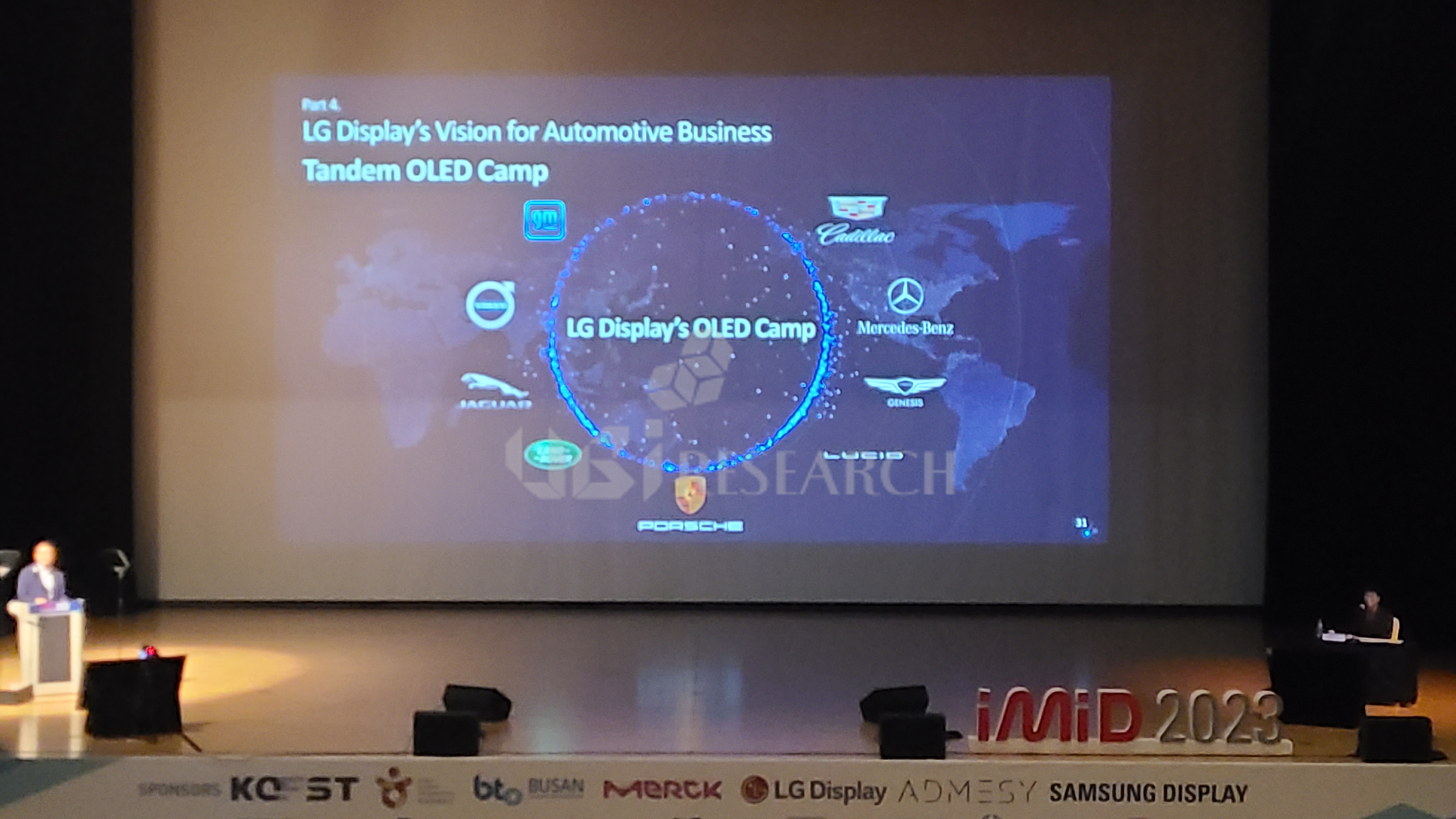
LG Display ‘Discovering the Best Automotive Display Solution for Tomorrow
Following this, Group Head Kim disclosed LG Display’s tandem OLED customers, such as Genesis, Mercedes-Benz, GM, Volvo, and Jaguar. Group leader Kim emphasized the Genesis of Hyundai Motor Company and emphasized, “We have been developing cooperation with Hyundai Motor Group for two years, and sooner or later, Genesis with LG Display’s tandem OLED will appear.”
Lastly, Group Head Kim said, “Based on continuous customer value realization and high-quality orders based on future technologies, LG Display will have a share of more than 50% in the automotive display market in 2026, excluding a-si LCD, and 60% in the automotive OLED display market.”
[IMID 2023] OLED exhibited by Samsung Display and LG Display
/in /by olednetAt ‘IMID 2023’ held in BEXCO, Busan on August 22, Samsung Display and LG Display exhibited a number of OLED products.
First, in ‘IMID 2023’, Samsung Display introduced 77-inch QD-OLED and light field display ‘2D↔3D Display’, ‘Slidable Flex Solo’ and ‘Slidable Flex Duet’, ‘Rollable Flex’, ‘Flex G’, ‘Flex It exhibited foldable and sliderable products such as ‘S’ and ‘Flex Note’. Products other than ‘2D↔3D Display’ were exhibited at ‘K-Display 2023’ held last week, and the exhibition scale was smaller than ‘K-Display 2023’.
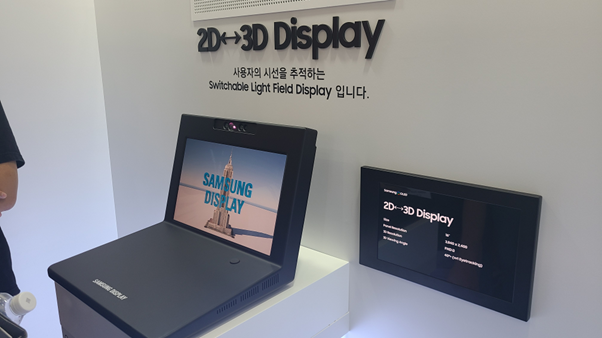
Samsung Display 2D↔3D Display
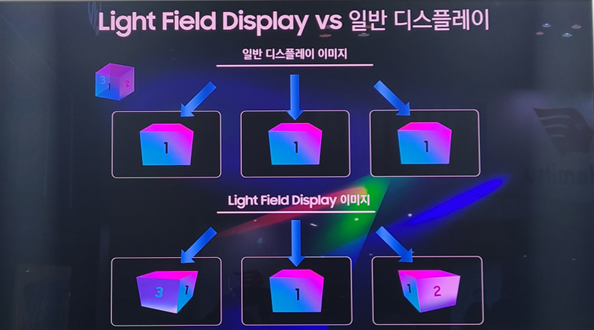
Samsung DIsplay Light Field Display
The size of the ‘2D↔3D Display’ exhibited by Samsung Display was 16 inches, the panel resolution was 3840×2400, and eyetracking technology was inserted to support a 3D viewing angle of more than 40°.
LG Display’s 77-inch 8K OLED with ‘META Technology’ applied, 45-inch and 27-inch gaming OLED, ‘34” Full Dashboard OLED’, ‘18” Rollable OLED’, ‘15.6” Light Field Display’, ‘0.42” OLEDoS’ exhibited.
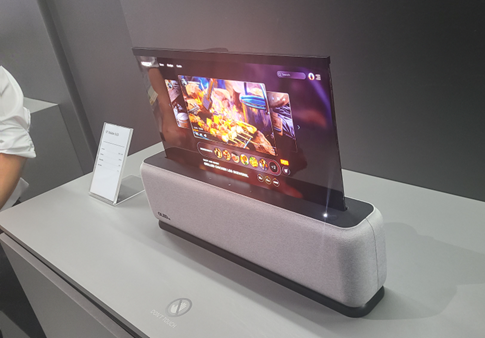
LG Display Rollable OLED
The 18-inch rollable OLED, which LG Display unveiled for the first time in Korea, realized a brighter screen by applying a tandem element structure, and passed more than 100,000 rolling tests. The resolution of the ‘18” Rollable OLED’ is 2560×1440, the brightness is 1,000nits, the rolling radius is 20R, and the cover window material is TPU (Thermoplastic Poly Urethane). An official from LG Display said, “There is no plan to mass-produce 18-inch rollable OLED yet, and the rolling radius will be between 5 and 10R when mass-producing actual products.”
‘0.42” OLEDoS (OLED on silicon)’, an ultra-high resolution product with 3500ppi, was the same as the product exhibited at ‘K-Display 2023’. It is a product that combines the optical system of LetinAR, a domestic optical module developer, with the panel of LG Display.
LG Display “A significant portion of the panel inventory adjustment that has been ongoing since last year is expected to turn profitable in the 4th quarter”
/in /by olednet
LG Display’s 2Q 2023 Performance Summary
In a conference call on LG Display’s Q2 2023 earnings announcement held on the 26th, LG Display CFO Seong-Hyeon Kim announced, “As a significant portion of panel inventory adjustments have been made, a turnaround is expected in the fourth quarter of this year.”
Since last year, intensive inventory adjustments in downstream industries have continued, centering on TV and IT products, and panel inventory levels across the industry ecosystem have been declining. In the second quarter, demand for mid- to large-sized panels, including OLED TVs, increased and shipments expanded. Compared to the previous quarter, shipment area increased by 11% and sales increased by 7%.
Sales by product (based on sales) in the second quarter were 24% for TV panels, 42% for IT panels (monitors, laptops, tablet PCs, etc.), 23% for mobile panels and other products, and 11% for automobile panels.
LG Display plans to continue to promote ‘advanced business structure’ centered on ‘order-based business’ and expand the proportion of OLED business. It plans to further increase the proportion of OLED and business competitiveness in all large- and small- and medium-sized products. This year, OLED sales are expected to exceed 50%.
In the small and medium-sized OLED sector, it plans to make efforts to expand mobile product shipments based on the expanded production capacity, while further solidifying its leadership in IT OLED technology and preparing for mass production and supply systems in 2024 without a hitch. The automotive display business plans to focus on increasing sales and order receipts based on various and differentiated technological competitiveness that encompasses tandem OLED and high-end LCD.
Kim Seong-hyun, CFO of LG Display, said, “It is judged that the inventory adjustment of downstream industries, which has been ongoing since last year, has progressed considerably since the first half of the year.” Thanks to the expansion of order-based business performance, such as increased shipments, we expect a turnaround in the fourth quarter.”
LG Display announced that it recorded sales of KRW 4,738.6 billion and operating loss of KRW 881.5 billion in the second quarter of 2023.

OLED panel makers’ 8.6G IT line investment trends, LG Display and BOE’s investment delays
/in /by olednet
Apple iPad Pro
Samsung Display and LG Display are investing in the 8.6th generation IT line with high added value to compensate for the decrease in sales due to the Chinese panel makers’ flexible OLED low-cost offensive and LCD withdrawal.
At the LG Display 2Q earnings announcement conference call held on the 26th, an official from LG Display said, “The announced 6th generation IT-related investments are proceeding as scheduled, and the investments will be made until the first half of next year.”
However, regarding the possibility of investing in the 8.6th generation IT OLED, it stated that “nothing has been confirmed yet”. LG Display emphasized, “We will carefully look at the possibility and progress of technology development and whether market demand is developing to a level that can contribute to the company’s profits before making an investment decision.”
LG Display’s 8.6th generation IT line investment is expected to be delayed compared to Samsung Display due to difficulties in securing new line investment funds due to operating losses, but it is expected to be able to supply panels to Apple from 2026.
Not only LG Display, but also Chinese panel maker BOE’s investment is being delayed. Samsung Display can secure Samsung Electronics and Apple, and LG Display can secure LG Electronics and Apple as customers, but BOE is expected to take at least two years to invest in the 8.6G line for IT because of uncertainty in securing customers.
Another Chinese panel maker, Visionox, is also preparing to invest in the 8.6G line for IT. Visionox plans to announce its investment in the 8.6th generation line with a total capacity of 30K in September.
On the other hand, Samsung Display’s investment in the 8.6th generation IT line has already been decided. Samsung Display plans to apply Oxide to the TFT of the 8.6th generation IT line and build it with 2 stack RGB OLED. Samsung Display had previously developed 8.6th generation vertical deposition 2 stack RGB OLED as an IT line, but the investment was decided for 8.6th generation horizontal deposition. Canon’s exposure machine is planned to be brought into Samsung Display’s IT line in April 2024, and negotiations on the price of the deposition machine with Canon Tokki have already been completed.

Choong Hoon YI, CEO of UBI Research “Samsung Display will strengthen profitability by producing OLED for high value-added IT”
/in /by olednetIt is expected that Samsung Display will focus on producing panels for tablet PCs and notebooks to compensate for the reduced utilization rate of the A2 line due to the low-cost flexible OLED offensive of Chinese panel makers.
At the ‘2023 OLED & Micro Display Analyst Seminar’ held at the Federation of Korean Industries in Yeouido on the 5th, Choong Hoon YI, CEO of UBI Research, gave a presentation on ‘IT OLED industry trends and market prospects’.

Choong Hoon YI, CEO of UBI Research
CEO YI said, “Samsung Display is expected to focus on rigid OLED production for tablet PCs and notebooks to compensate for the reduced utilization rate of the A2 line due to the low-priced offensive of Chinese companies. As much as it focuses on IT OLED production, the shipment of rigid OLED for smartphones will drop sharply, but it is possible to maintain sales by producing rigid OLED for IT with high added value.” And he also said, “LG Display will start mass production one year later than Samsung Display, and BOE will start mass production at least two years later than Samsung Display.”
According to CEO Choong Hoon YI, LG Display’s decision is being delayed because it is difficult to secure funds for investment in new lines due to the deficit caused by the delay in switching from LCD lines to OLED lines. Nevertheless, LG Display is expected to be able to supply IT panels to Apple from 2026. However, there are still problems to be solved, such as stabilizing the process and securing yield of Sunic system equipment whose production capacity has not yet been verified.
BOE has invested in three OLED line factories for smartphones, but the operation rate is at a level of only one factory, and the Beijing city government is very dissatisfied with over-investment due to insufficient securing of Apple supplies. For the reasons mentioned above and because securing customers for IT OLED has not been decided, BOE’s IT OLED line investment is expected to take at least two years.
CEO YI said, “Chinese panel makers are trying to increase their market share with low-priced attacks, but domestic companies that have secured large customers such as Samsung Electronics and Apple have a significant advantage in competition. In the future, the OLED industry for TV and IT will be developed mainly by Korean companies.”

OLED emitting materials market in 2027 expected to reach US$ 2.59 billion with an average annual growth rate of 7.7%
/in /by olednetAccording to the ‘2023 OLED Emitting Material Report’ recently published by UBI Research, the total emitting material market is expected to reach US$ 2.59 billion in 2027 with an average annual growth rate of 7.7% from US$ 1.92 billion in 2023.
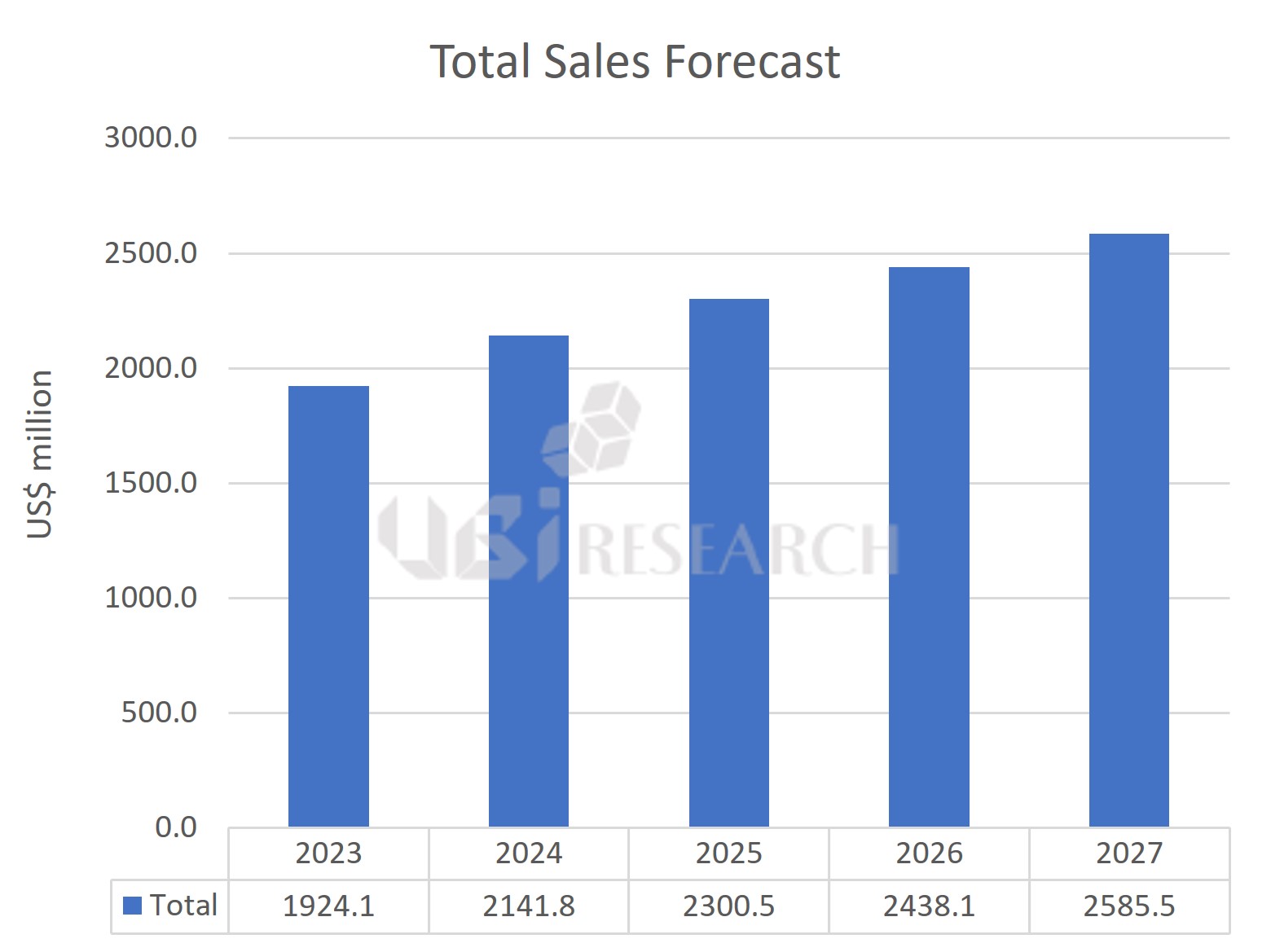
total emitting material market
Analyst Yoon Daejeong of UBI Research said, “The small OLED material market is expected to grow at an average annual growth rate of 2.5% from 2023 to US$ 1.61 billion in 2027. And in 2027, Samsung Display’s purchase of small OLED materials is expected to be US$ 560 million, BOE US$ 430 million, and LG Display US$ 200 million.” and “the small OLED material market will change depending on how much the foldable OLED market replaces the sharp decline in rigid OLED shipments for smartphones.
Analyst Yoon continued, “As the shipments of LG Display’s WOLED and Samsung Display’s QD-OLED are expected to be 12 million units and 3 million units, respectively, in the large OLED material market in 2027, the purchase amount of emitting materials is also expected to be US$ 430 million and US$ 140 million, respectively”
Meanwhile, the report predicted that by OLED method in 2027, RGB OLED would occupy the largest share at 66.6%, followed by WOLED at 16.5%, RGB 2stack OLED at 11.4%, and QD-OLED at 5.5%.
OLED panel shipments for TVs are expected to reach 14.1 million units in 2027 with an average annual growth rate of 11.6% from 9.1 million units in 2023
/in /by olednetAccording to the ‘2023 Medium and Large OLED Annual Report’ recently published by UBI Research, OLED panel shipments for TVs are expected to grow from 9.1 million units in 2023 to 14.1 million units in 2027 with an average annual growth rate of 11.6%.
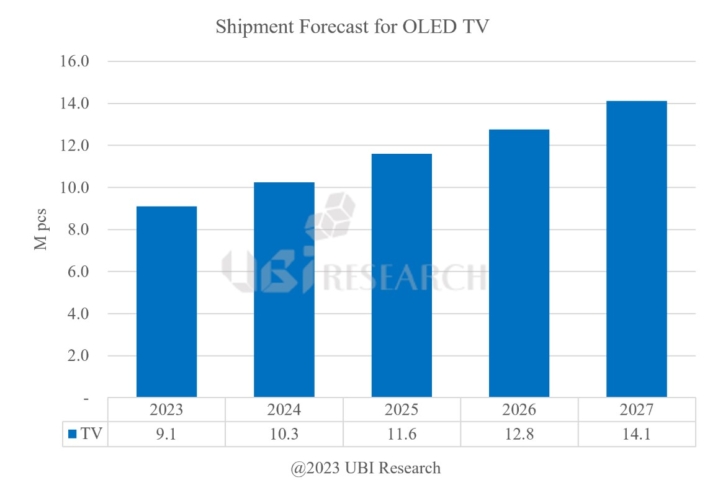
Shipment Forecast for OLED TV
In 2022, it is analyzed that TV demand will decline due to the global economic deterioration, and global TV shipments will also stop at the early 200 million units. In the case of LG Display, it set a goal to ship more than 10 million WOLEDs in early 2022, including those for monitors, but released a total of 6.96 million units, recording a decrease of 880,000 units from 7.84 million units in 2021. Samsung Display’s QD-OLED shipments for TVs are also analyzed to have recorded 950,000 units.
As the economic situation is expected to gradually recover in 2023, LG Display’s TV WOLED shipments are expected to be 7.6 million units and Samsung Display’s QD-OLED shipments to be 1.5 million units.
Meanwhile, UBI Research predicted that LG Display’s micro lens array (MLA) applied ‘OLED.EX’ panel would be partially mass-produced from 2023, and Samsung Display’s QD-OLED monthly capacity of 36K is expected to be 41K per month by the second half of 2023 and 45K per month by the first half of 2024.

2023 OLED KOREA Conference “OLED, a premium electronic product lineup and micro display, a promising future industry”
/in /by olednetOLED KOREA, hosted by UBI Research, a market research company, will be held at the Central Park Hotel in Songdo, Incheon from April 12 to 14. OLED KOREA, which marks its 7th anniversary, is a business conference where top authorities in display from Korea, Japan, Asia, the United States, and Europe gather.
This conference will deal with the topics of OLED, which has become a premium electronic product, and micro-display for AR and VR, which are rapidly emerging as future industries.
In order for OLED to replace LCD, the emergence of phosphorescent blue materials is the most important. At this conference, Samsung Advanced Institute of Technology and UDC will introduce the direction of phosphorescent material development. Commercialization of phosphorescent blue materials will be an inflection point that can overturn the display industry.
There are two types of micro displays: micro OLED and micro LED. While micro OLED is leading the way for VR, micro LED is gradually taking its place in AR. In OLED KOREA, programs are composed of AR companies, micro display manufacturers, and related technology companies. It will be an important place to guess who will be the winner of the future micro display.
The pre-registration period for this conference is until April 7, 2023, and you can check program and speaker information and register for the event through the website (https://oledkoreaconference.com/).
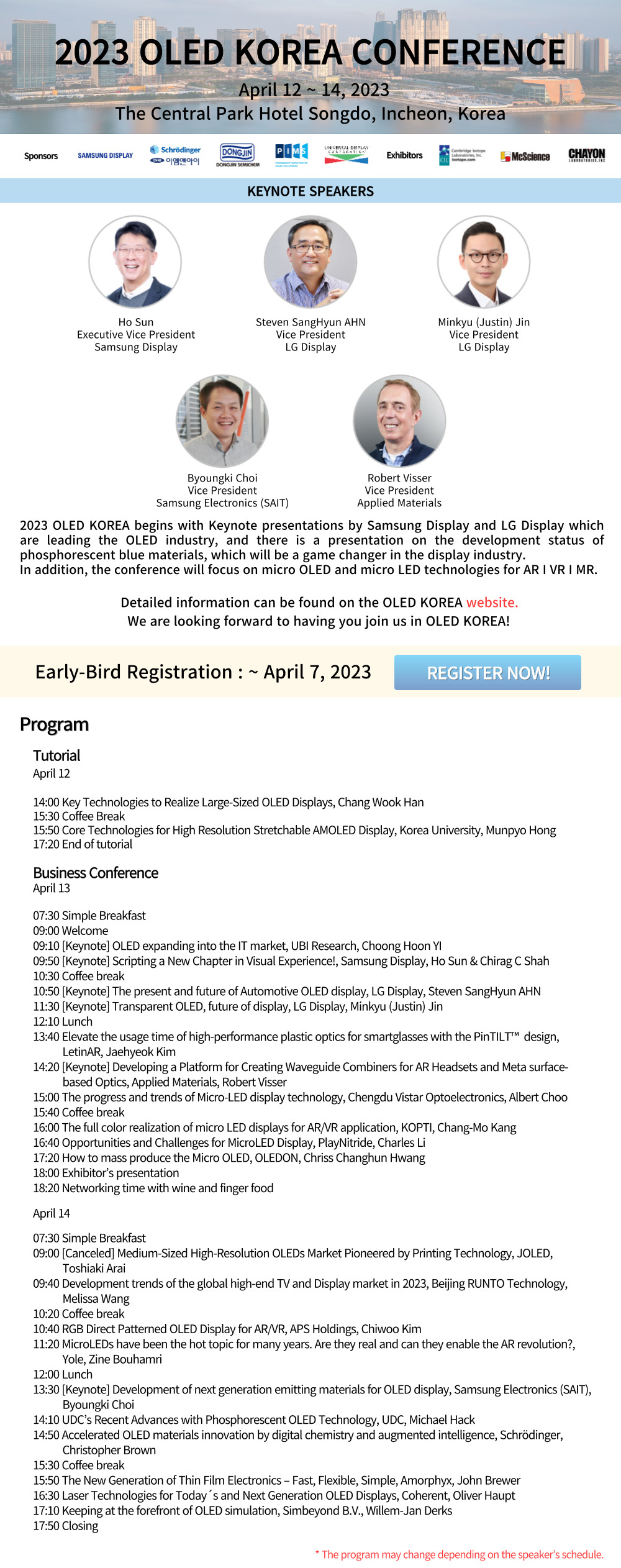
LG Display strengthens its transparent OLED lineup by launching 77-inch transparent OLED this year
/in /by olednet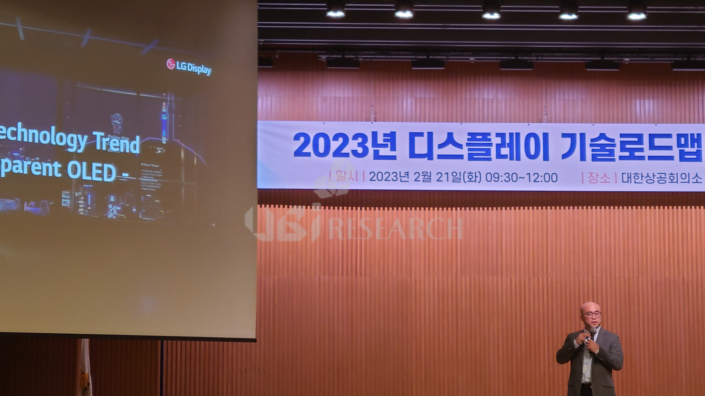
LG Display at 2023 display technology roadmap
LG Display announced that it will release 77-inch transparent OLED products by the end of this year. LG Display plans to continuously strengthen its transparent OLED product lineup, which is a next-generation technology.
At the presentation of the 2023 display technology roadmap held at the Korea Chamber of Commerce and Industry on the 21st, Yeo Joon-ho, group manager of LG Display, said, “In addition to the 55-inch size that is currently being released as transparent OLED, we plan to release 77-inch transparent OLED products by the end of 2023.”
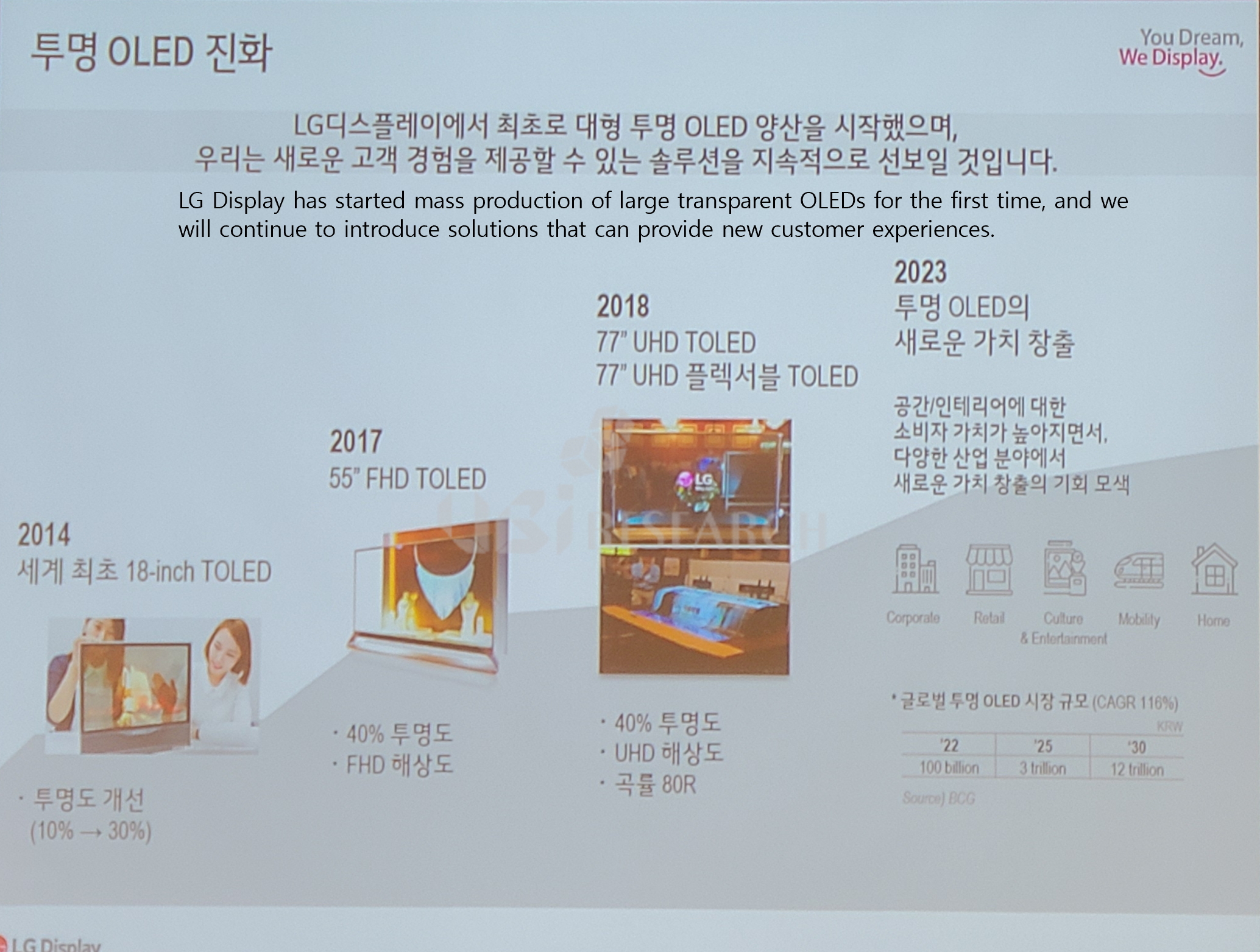
LG Display Transparent OLED
Emphasized that “transparent OLED can create a sense of openness that can connect spaces and create new spaces and advertising areas,” adding, “Recently, interior-friendly designs are in the limelight. We have tried many ways to realize the needs of consumers, and if we meet them, we will be able to open consumers’ wallets even at high prices.”
Finally, “LG Display is currently a B2B company, and transparent OLED products are being sold to B2B customers rather than B2C. In the future, we plan to expand the scope to B2C customers.” Group leader Yeo said, “The reaction to transparent OLED in Europe and the US was not bad. However, since the transparent OLED market is centered on B2B, there has not yet been a case where a large unit of volume explodes at once. We are thinking about how to effectively continue our fragmented business.”
LG Display, Already completed development of OLEDoS-applied prototype for VR
/in /by olednet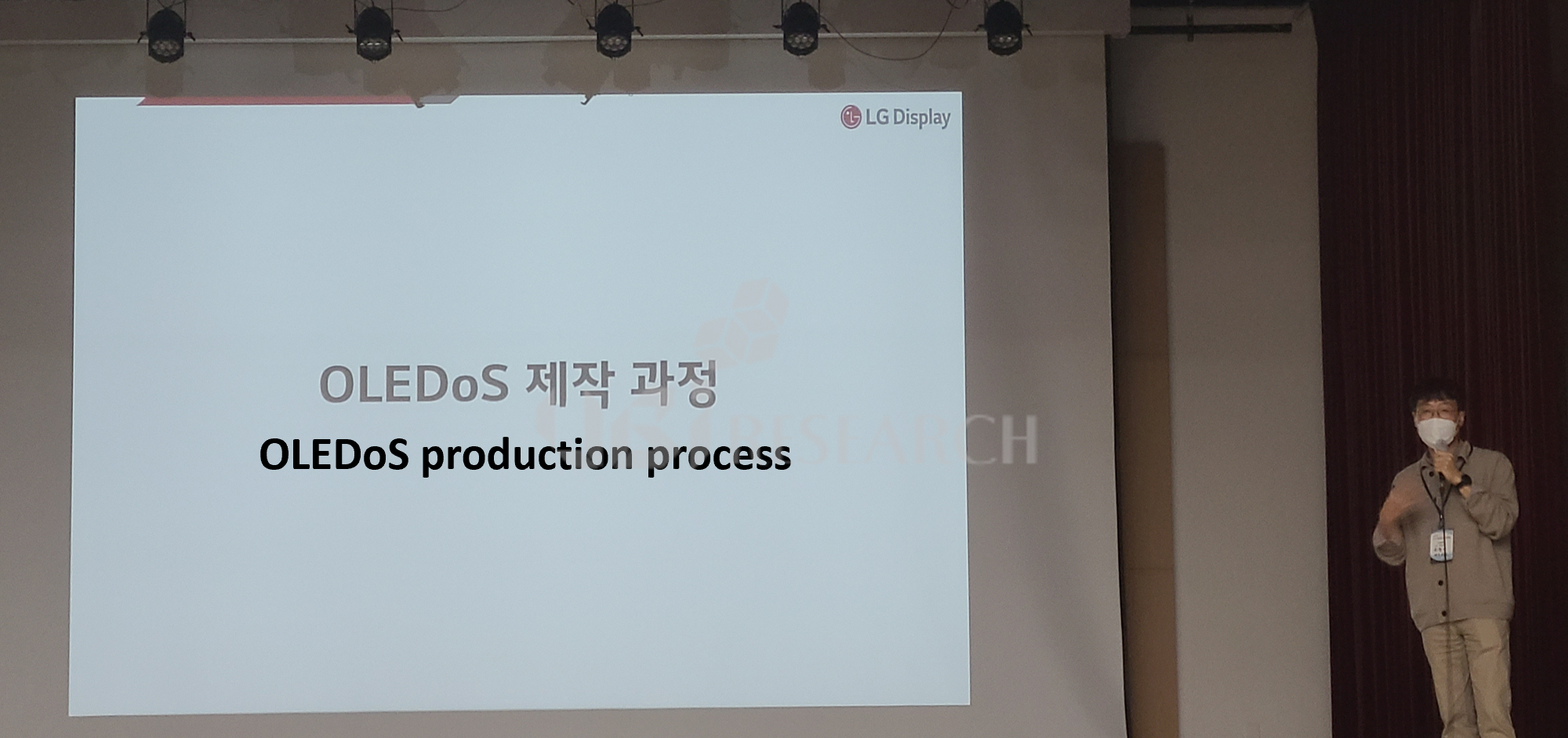
LG Display presenting OLEDoS at OLED School
At the 19th OLED School held at Sookmyung Women’s University from February 9th to 10th, Senior Research Fellow Yoo Chung-geun of LG Display announced, “We are developing a set for VR using OLEDoS, and some of the prototypes have already been developed.”
On this day, Research Fellow Choong-Keun Yoo gave a presentation on ‘The Future of OLED Display, Metaverse and Display’. Researcher Yu explained the specifications and technologies required for micro displays such as metaverse and VR/AR, and said, “In general VR devices, luminance of 10,000 nits or more and AR devices require luminance of 100,000 nits or more, but it is difficult to apply this to OLEDoS. Currently, the display for AR developed by LG Display has achieved a brightness of over 7,000 nits and a resolution of 3,500 ppi.”
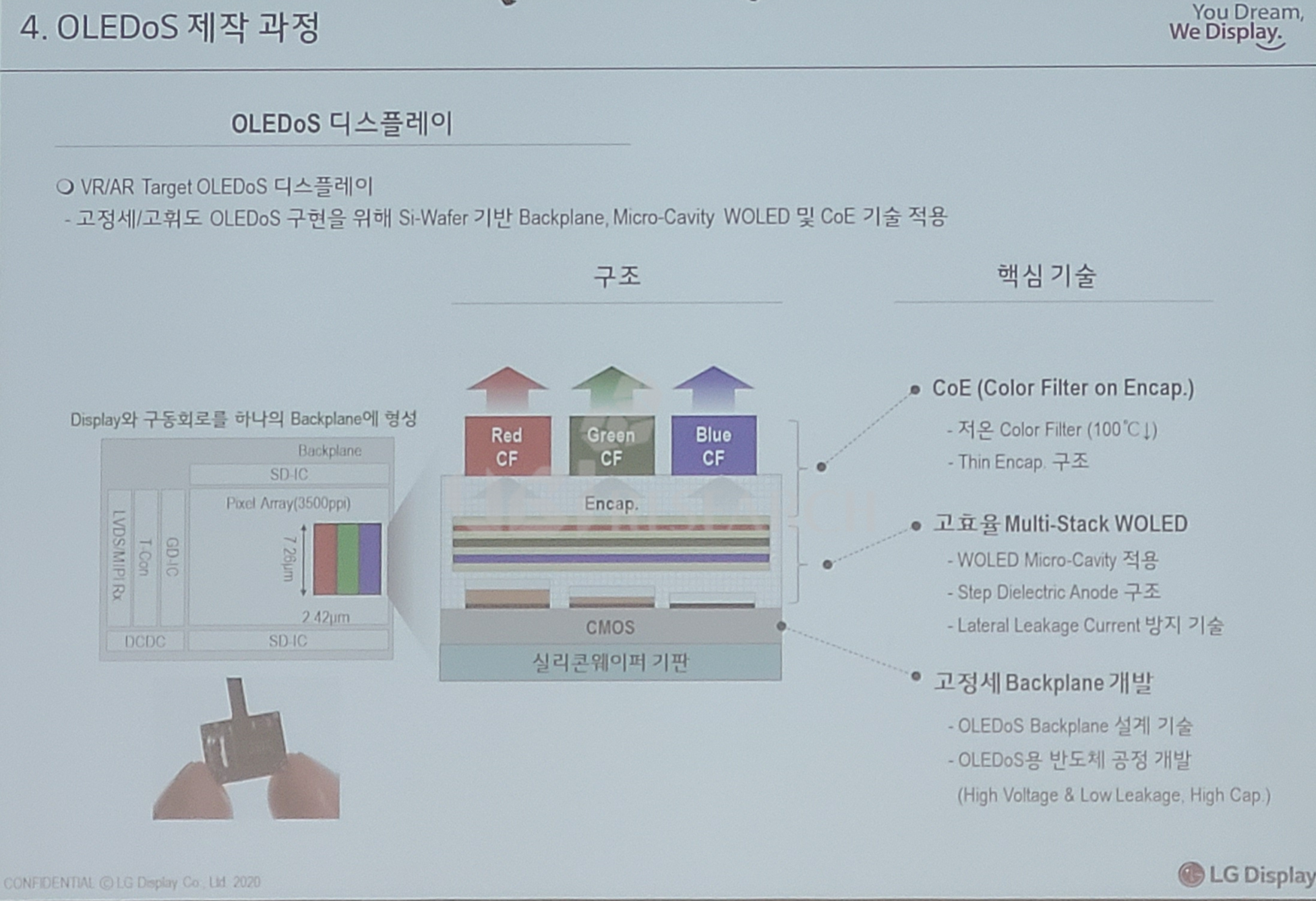
LG Display OLEDoS Manufacturing Process
3500ppi or higher OLEDoS being developed by LG Display requires ultra-high-definition patterns, so Si-wafer backplane and WOLED + CoE technology must be applied, so cooperation with semiconductor foundries is essential. Research Fellow Yu explained, “For high-resolution OLEDoS, semiconductor foundries have no choice but to make display backplanes through wafers.”
Finally, researcher Yoo said, “We are developing a set for VR using OLEDoS, and it is planned to be released soon. We are developing products for major IT companies such as Apple, Google, and Meta, and some prototypes have already been developed.” He continued, “It takes more time to supply products that meet consumer needs, such as brightness of 10,000 nits or more, but it is possible to produce better VR devices even with 3500ppi class OLEDoS, which has now been developed.” When asked if the next actual product supply time was right before September, he replied, “There is nothing planned yet.”
Fold, extend… Foldable IT device trends seen through exhibition trends
/in /by olednetAs panel makers have recently accelerated the development of foldable OLEDs, a variety of products, including foldable phones, foldable tablet PCs, and foldable laptops, are being exhibited. We look at the development trend based on the exhibited products of panel makers.
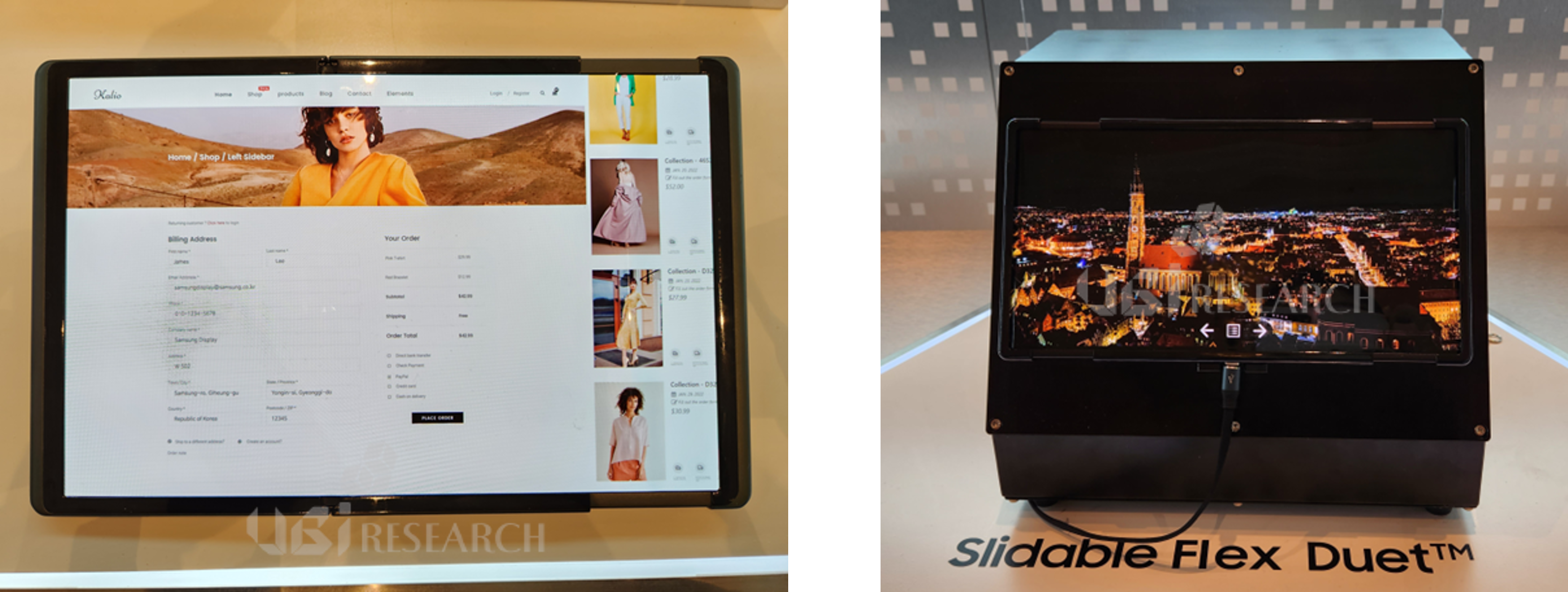
‘Flex Hybrid’ and ‘Slidable Flex Duet’ exhibited by Samsung Display
At CES 2023, which was held in January, Samsung Display, a leader in foldable displays, exhibited the ‘Flex Hybrid’, a combination of foldable and slider, and the ‘Slidable Flex Solo’, which extends on one side and, the ‘Slidable Flex Duo’, which extends on both sides. In the ‘Flex Hybrid’, the screen expands from the default 8 inches to 10.5 inches when the folded screen is unfolded, and to 12.4 inches when the right side is extended. Sliderable products can expand the screen from the basic 13 to 14 inches to 17 inches.
Prior to this, Samsung Display had exhibited S-type and G-type, double-folding ‘Flex S’ and ‘Flex G’, and ‘Slidable Wide’ that extends outward in 2022, and all three products had a maximum size of 12.4 inches. The size of the prototypes is 12.4 inches, which is the same as Samsung Electronics’ Galaxy Tab S8+. When mass-producing actual products, it is expected that mass-production will be carried out according to the needs of set makers.

Foldable OLED for laptops from Samsung Display, LG Display, and BOE
In addition to tablet PCs, foldable laptops are also being developed. Samsung Display exhibited the 17.3-inch foldable OLED ‘Flex Note’ for laptops at IMID 2022 and SID 2022. Originally, Samsung Display was expected to supply this 17.3-inch foldable OLED to Samsung Electronics last year, but the schedule was delayed to this year.
LG Display is also developing a foldable OLED for 17.3-inch laptops. LG Display exhibited a 17.3-inch ‘Foldable OLED Laptop’ with an improved folding radius of 1.5R at IMID 2022. LG Display is currently developing foldable OLED for laptops with the goal of supplying HP.
BOE of China is also developing foldable OLED for IT. BOE exhibited a 12.3-inch foldable OLED for tablet PCs that double-folds into an S-type at SID 2022 in May of last year. It also unveiled a foldable OLED for 17.3-inch laptops, and this panel was mounted on Asus’s ‘ZenBook 17 Fold’ released in 2022.
Samsung Display, LG Display, and BOE are all developing foldable OLEDs for notebooks in the same size and resolution. When full-scale mass production begins, competition for panel supply between the three companies is expected to be fierce.
LG Display Expected to Supply only LTPO Panels for iPhone 15 to be Released in 2023
/in /by olednet
iPhone 15 expected lineup
It is forecasted that LG Display will supply only two panels of the LTPO model among the iPhone 15 series to be released in 2023. It is unlikely that panels will be supplied to 6.1 inch LTPS models that have previously supplied panels. LG Display first started supplying OLED panels for the iPhone11 Pro max released in 2019 and supplied LTPO TFT-applied panels for the first time for the iPhone14 Pro max released this year.
According to the prospect that LG Display will supply LTPO panels for iPhone 15 to be released next year, Samsung Display and LG Display will jointly supply LTPO models. Samsung Display is expected to supply panels for all 4 types of iPhone15, LG Display for 2 pro models, and BOE for 6.1-inch LTPS models. It is still unknown whether BOE will supply panels for the 6.7-inch LTPS model.
It was in 2017 that Apple began to apply OLED to iPhone. LTPO TFT was applied from the iPhone13 pro series released last year and LTPO TFT applied panel was supplied to Apple for the first time by Samsung Display.
[IFA 2022] LG Display Booth
/in /by olednet#ifa2022 #lgdisplay #oledtv

https://ubiresearch.com/en/

https://en.olednet.com/

marketing@ubiresearch.com
+82-2-577-4391
[K-Display 2022] LG Display creates new value with transparent OLED
/in /by olednetAt ‘K-Display 2022’ held from August 10 to 12, LG Display exhibited various transparent OLED products such as wall type and TV type. The transparent OLED exhibited this time had a transmittance of 45% and a resolution of FHD level.

LG Display’s transparent OLED exhibited at K-Display 2022
At the ‘Display BUSINESS Forum 2022’ held on the 11th, Kang Won-seok, managing director of LG Display, said that the use of transparent OLEDs is increasing due to improved transmittance and reduced weight.
Director Kang mentioned that LG Display has been developing transparent OLED since 2014, and announced that he would increase the value of transparent OLED in line with internal activities that have been increasing since COVID-19.
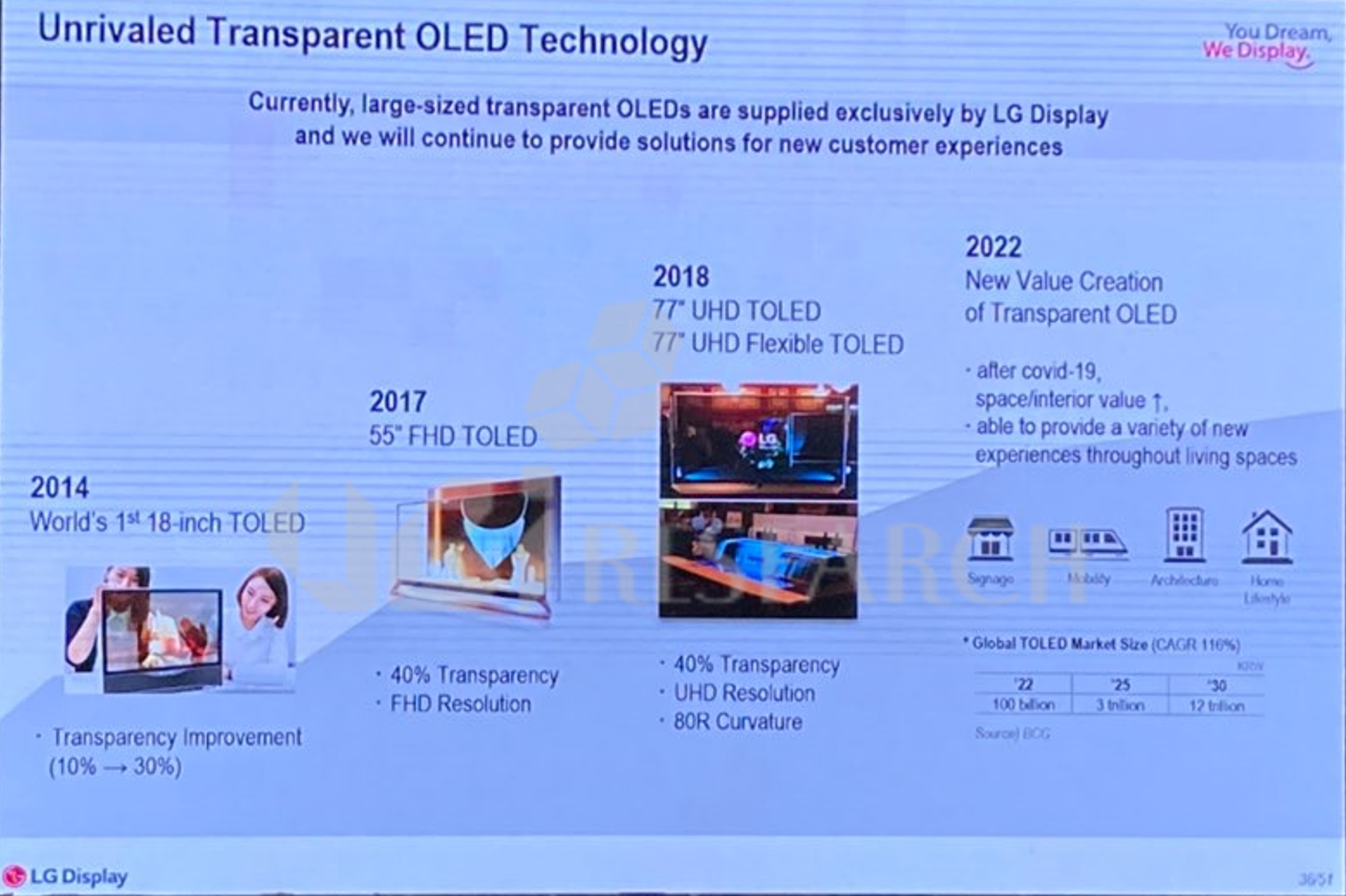
LG Display Transparent OLED Roadmap
Currently, LG Display is mass-producing transparent OLED on a limited basis in its E3 line. Currently, only 55-inch transparent OLEDs are being mass-produced, but from the second half of this year, they plan to expand the lineup to 77 inches.
LG Display’s transparent OLED is mainly used for museums and signage in China. As demand is expected to increase in the future, LG Display is expected to respond to the market by lowering panel prices and introducing production lines other than E3.
[K-Display 2022] LG Display Online Booth Tour
/in Oled Video, Oled Video, Oled Video /by olednetThis is the LG Display booth exhibited at K-Display 2022.
LG Display exhibited OLED.EX, transparent OLED, and various concept OLED products.
I hope it will be of some help to those who could not attend K-Display 2022.
▶ UBI Research official website
https://ubiresearch.com/en/
▶Business, display report inquiry
marketing@ubiresearch.com
+82-2-577-4391
▶If you are curious about the latest news related to OLED?
https://en.olednet.com/
[K-Display 2022] LG Display’s Transparent OLED
/in /by olednetThis is LG Display’s new transparent OLED display.
It was amazing to actually see the technology we saw in sci-fi movies when we were young.
How can LG Display’s transparent OLED be applied to our lives?
▶ UBI Research official website
https://ubiresearch.com/en/
▶Business, display report inquiry
marketing@ubiresearch.com
+82-2-577-4391
▶If you are curious about the latest news related to OLED?
https://en.olednet.com/
This Year’s OLED Mass Production Capacity Substrate Area is Expected to be 47.3 million ㎡
/in /by olednetAccording to the ‘2022 OLED Components and Materials Report’ recently published by UBI Research (www.ubiresearch.com), a company specialized in OLED market research, the substrate area of the total OLED mass production capacity in 2022 is expected to be 47.3milion ㎡. In 2022, the LTPO TFT line and EDO’s 6th-generation rigid OLED line, which Samsung Display invested in to supplement the idle capacity of the A3 line, are scheduled to be operated. In 2023, LG Display’s E6-4 line and BOE’s B12-3 line Line, Samsung Display’s 8.5G IT line are expected to be put into operation in 2024.
As for the substrate area of small OLED for smart watch and smartphone, the line capacity for rigid OLED in 2022 is 5.29 million ㎡, accounting for 24.8% of the market share. Rigid OLED investment is not expected in the future. In 2022, the capacity for flexible OLED is 15.3 million ㎡, accounting for 71.5% of the total. From 2024, part of Samsung Display’s A3 line will be converted to an IT line, and the mass production capacity is expected to decrease. The line capacity for foldable OLED is expected to reach 0.79 million ㎡ in 2022 and 1.52 million ㎡ from 2023.

Samsung Display’s IT line capacity is expected to expand to 2.69 million ㎡ by 2025 as part of the A3 line is converted to an IT line in the first half of 2024. A new 8.5G line is expected to be operated in 2024. From the second half of 2023, LG Display’s capacity is expected to be 0.75 and 0.52 million ㎡, respectively, with the E6-4 line operating and BOE’s B12-3 line operating.
OLED line capacity for TV is not expected to change until 2026 unless additional investment is made. From 2022, LG Display’s mass production capacity is 20.3 million ㎡, accounting for 85.5% of the total. Capacity is expected to increase further depending on whether additional customers are secured in the future. Samsung Display’s capacity is 3.3 million ㎡ and BOE’s is 0.13 million ㎡, accounting for 13.9% and 0.6% of market share, respectively.
Meanwhile, the ‘2022 OLED Components and Materials Report’ published this time dealt with the latest OLED industry issues analysis, development of components and materials for foldable devices, industry status, analysis of mass production capacity of OLED panel companies, and major component and material market forecasts. It is expected to help parts and materials companies to understand related technologies and predict future technology directions and markets.
Can VR replace TVs and Monitors?
/in /by olednetVR devices have been on the rise since 2016 and were expected to be an important factor in IT business, but have not yet made a big impact. At CES 2016, Intel exhibited applications that enable creative activities such as education and art. In 2017, Samsung presented games and movies that can be felt with the body in 4D form at the IFA VR experiment zone.
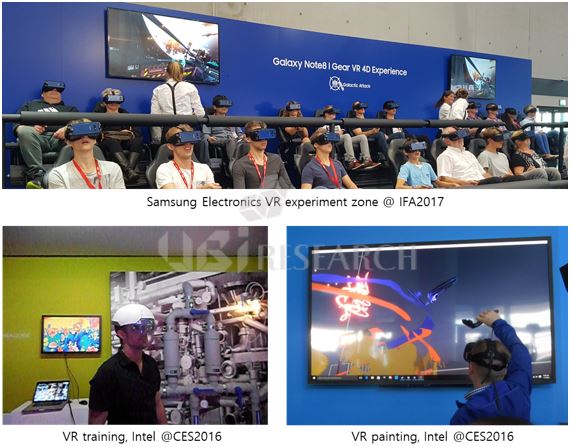
VR features excellent immersion and presence. A 1-inch display can look like a 60-inch display. The display that provides information uses micro-display, but LCoS (liquid crystal on silicon) has a slow response speed, poor color, and low contrast ratio. So the trend is changing to OLEDoS (OLED on silicon). Sony is making its own micro OLED and Panasonic is working with US Kopin to make VR.
Recently, VR devices are preparing to replace monitors. If it is made in high resolution, about 10 screens can be displayed on each VR monitor screen. In the future, the monitor market will change to the VR market. VR can emerge as the best dark horse in the IT market. VR may possibly also replace TVs. A head speaker with a much better three-dimensional effect is essential. There may also be changes in the movie theaters as a VR device might provide a 60-inch screen and provide a high sense of immersion into the film for movie-goers.
Micro OLED composition consists of TFT designed on a silicon wafer and OLED is formed on it. LGD’s WOLED method is used for OLED. The RGB method requires a fine metal mask, but the AP system is preparing a mask capable of 2000ppi or more using a laser. Because WOLED uses a color filter, there is a loss of about 10%. RGB may be more advantageous in terms of luminance, but for commercialization, WOLED resolution can be much higher. Since it has been developed for a long time, WOLED is expected to be applied. Applications include military, medical, industrial, viewfinder, smart glasses, and the like.
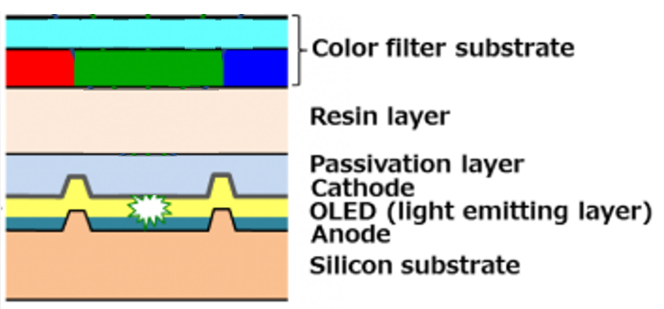
Recently, Apple requested LG Display and Samsung Display to prepare Micro OLED. LG Display placed an order for the Sunic System evaporator in June and is moving quickly.
Samsung Electronics also has a request for VR. In 2025, it can be seen that LG Display and Samsung Display can produce many types of Micro OLED. We expect to see Apple’s VR devices around 2024.
Related Report : 2022 Micro-display REPORT
What is the future change of WRGB OLED to respond to QD-OLED?
/in /by olednet
2As Samsung Display’s QD-OLED begins to be applied to TVs and monitors in earnest in 2022, technological changes are being detected for LG Display’s WRGB OLED, which has been leading the large OLED market.
LG Display’s WRGB OLED has produced a WBC structure consisting of two blue layers and one red+yellow green layer in Paju by the end of 2021, and a WBE structure consisting of two blue layers and one red+green+yellow green layer in Guangzhou. Deuterium substitution technology was applied to the blue of the WBE structure.
Since 2022, LG Display has stopped producing WBC panels from its Paju line and has been producing ‘OLED.EX’ panels with deuterium substitution technology applied additionally to green of WBE produced in Guangzhou.

<Photo of OLED.EX presented by LG Display at the 2022 OLED Korea Conference>
At SID 2022, LG Display also exhibited a large OLED panel with micro lens array technology. Micro lens array technology was applied to Samsung Electronics’ ‘Galaxy S Ultra’ series, and it is the first technology applied to large OLEDs. LG Display is known to expect a 20% improvement in luminance compared to the previous one by applying micro lens array technology. Panels which micro lens array technology is applied are expected to be produced in Paju from the second half of this year.
Lastly, it is known that LG Display is developing a structure in which yellow green is removed from WRGB OLED. By eliminating yellow green, material and processing costs can be saved, and color gamut is expected to be improved.
Attention is paid to how LG Display’s WRGB OLED will evolve to compete against QD-OLED.

<OLED panel with micro lens array technology exhibited by LG Display at SID 2022>
Introducing iPhone 14 Display Specifications and Panel Vendors
/in Display, Display, Display, Display, Display, Display, Display, Display, Display, Display, Display, Display, Display, Display, Display, Display, Display, Display, Display, Display, Display, Display, Display, Display, Display, Display, Display, Display, Display, Display, Display, Display, Display, Display, Display, Display, Display, Display, Display, Display, Display, Display, Display, Display, Display, Display, Display, Display, Display, Display, Display /by olednet
<Apple iPhone 14 Series Specifications>
Samsung Display, LG Display, and BOE are expected to supply panels to Apple’s new iPhone 14 series in 2022. It is expected that Samsung Display will supply panels to all models in addition to iPhone 13 series. LG Display will supply 6.12-inch LTPS models and 6.69-inch LTPO models. BOE will supply panels only to 6.12-inch LTPS models.
The existing 5.4-inch mini model has been removed from the iPhone 14 series and a 6.69-inch Max model has been added. The size and resolution of iPhone 14 Max are the same as iPhone 14 Pro Max and LTPS TFT is applied instead of LTPO TFT.
In terms of design, the iPhone14 Pro and 14 Pro Max will have a punch hole design instead of the conventional notch. Apple’s punch hole design is expected to be applied as a double punch hole design due to various sensors and cameras.
Meanwhile, the total OLED panel supply to Apple in 2022 is expected to be about 215 million units, with Samsung Display expected to supply 135 million units, LG Display 55 million units, and BOE 25 million units. However, shipments are expected to be organically controlled due to market conditions and Apple’s policies.
[2022 OLED KOREA CONFERENCE] LG Display’s OLED 3.0 Captures Brightness and Lifespan Simultaneously
/in /by olednetAt the keynote session of UBI Research’s ‘2022 OLED Korea Conference’ held from April 6th to 8th, Sang-Hyun Ahn, Managing Director of LG Display, announced, ‘The Present and Future of Automotive OLED Display: LG Display’s Future Outlook’.

Director Ahn announced, “The future will transform people and vehicles, and vehicles and vehicles to be connected, autonomous, shareable, and electrically driven. In order to respond to these changes, vehicle displays are getting bigger and more diverse in design, and displays are being applied to various locations to provide sights and information”.
Director Ahn continued, “The automotive display industry was led by LCD, but the OLED market is also gradually expanding its area.” He predicted, “The automotive OLED market will be worth $1.2 billion in 2025, It is also possible to grow to $6 billion.”

In addition, Director Ahn said, “LG Display has already introduced an OLED 1.0 structure that satisfies the minimum requirements for automotive display: brightness of 800 nits and lifespan of 10,000 hours. Unlike OLED for smartphones, OLED for automobiles requires brightness of 800 nits or more to grasp accurate information even during the day, and lifespan of 10,000 hours or more is essential because the use cycle is more than 10 years. Although there is a trade-off between brightness and lifetime, we plan to develop OLED 3.0 with a brightness of 1,000 nits or more and a lifetime of 10,000 hours or more by overcoming this through development of materials and structures.”

Lastly, Director Ahn mentioned about future displays such as extra-large and transparent, slidable, and rollable that are applied to vehicles and said, “Many companies want large and many screens, but they want to hide those screens inside the vehicle. Slidable panels, which can be a solution to this, are already technologically stable and can become common around 2025. On the other hand, rollable panels, such as those that come down from a vehicle sunroof, still have a long way to go, but we will continue to develop them.”
[2022 OLED KOREA CONFERENCE] LG Display Executive Vice President Hyun-Woo Lee, Advancements in the Display Market with Technological Innovation that Suits Changing Lifestyles
/in /by olednet
Executive Vice President Lee explained OLED technology innovation, future application fields, and market changes. He mentioned that COVID-19 has increased everyone’s time at home and changes in life display is necessary to match it.
Executive Vice President Lee first explained LG Display’s OLED.EX, and said, “LG Display’s OLED.EX is the most advanced OLED panel to which EX technology is applied. OLED.EX applies deuterium to increase brightness (an important element in OLED panels) by 30%. Through personalize algorithm based on AI and big data, reliability will be increased.” He also emphasized that “LG Display’s OLED.EX will be applied to all OLED TVs in the second quarter of 2022 and LG Display will lead the display market with innovative technologies including OLED.EX.”

Next, Executive Vice President Lee announced about life displays applied to everyday life, and said, “OLED is applied to life displays such as gaming, transparent, and portable displays. OLED realizes 100% original color to increase the sense of reality and enables excellent interaction with eye care, making it suitable as a gaming display.” Also “Transparent OLED maximizes the advantages of OLED, enabling the highest level of transparency and picture quality. By applying it to signage, it provides an effective experience to customers, and by applying it to mobility, it can use the dead space to indicate the current operation status or use it for advertisements. In addition, it is possible to create a space of new value and change a creative lifestyle by applying it to life”.
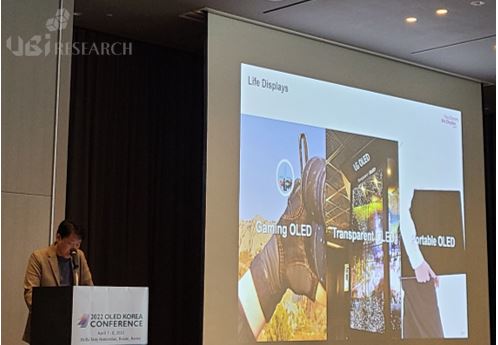
‘2022 OLED Korea Conference’ was a conference for exchange of ideas, business relationships, and partnerships with renowned speakers from major companies in the display industry from all over the world. ‘2022 OLED Korea Conference’ held a business conference on the 7th and 8th, beginning with a tutorial on April 6th.
[2022 OLED KOREA CONFERENCE] Samsung Electronics Joins the OLED TV Market, and the TV Panel Market is Expected to Exceed 20 million Units in 2025
/in /by olednetAt UBI Research’s ‘2022 OLED Korea Conference’ held on April 6th-8th, UBI Research CEO Choong-Hoon Lee gave a presentation on, ‘OLED Market Review’.

CEO Lee presented the status of the entire OLED industry, market, and outlook with a focus on issues in 2022.
CEO Lee first announced the OLED TV business, a major issue in the recent OLED industry. CEO Lee said, “The biggest issue that has been heating up the OLED industry since the end of last year is OLED TV. There are topics such as Samsung Display’s re-entry into the large OLED business, sales of QD-OLED TVs between Samsung Electronics and Sony, and visualization of collaboration between Samsung Electronics and LG Display.”
In the TV OLED panel demand and supply forecast, CEO Lee said, “If Samsung Electronics purchases OLED panels from LG Display and conducts OLED TV business, LG Display and Samsung Display can supply a total of 12 million TV OLED panels this year. Among them, demand is 11.7 million units, and oversupply accounts for only 3%.” In addition, “With the joining of Samsung Electronics, the demand for OLED TV panels is expected to expand to 13 million units in 2023 and 20 million units in 2025. According to the expanding market, companies need to expand their facilities by the third quarter of this year” he predicted.

CEO Lee continued, “LG Display has been working hard to secure funds for 8.5 generation OLED line expansion since last year, and it is estimated that it will secure additional funds for 45K expansion within this year. With LG Display’s additional measures, the TV OLED panel market is expected to reach 13.5 million units in 2023 and 16 million units after 2024. However, to secure a market of more than 20 million units, it is necessary to plan to invest in the 10.5 generation by next year” he analyzed. He also said, “If Samsung Display invests, 10.5G investment is desirable, but 8.5G investment is expected.” He said, “Whether LG Display invests or Samsung Display invests, a long-term supply contract with Samsung Electronics for 10.5G investment should take precedence. If the investment proceeds, Samsung Display is expected to secure its own funds, but LG Display is expected to require joint investment with Samsung Electronics.”

‘2022 OLED Korea Conference’ was a conference for exchange of ideas, business relationships, and partnerships with renowned speakers from major companies in the display industry from all over the world. ‘2022 OLED Korea Conference’ held a business conference on the 7th and 8th, beginning with a tutorial on April 6th.
2022 OLED KOREA Conference Day1 (Session highlights)
/in Oled Video, Video, Video, Video, Video, Video, Video, Video /by olednetSDC, 4Q2021 The Highest Smartphone Shipments 125 million units, Highest market share of flexible OLED 50.1%
/in Display /by olednetAccording to UBI Research Weekly Report, Samsung Display’s OLED shipped 480 million units in 2021. The highest number of shipments were in the 4th quarter at 133 million units and the second highest was in the in 3rd quarter at 129 million units.
Samsung Display OLED application products shipped in 2021 were smartphones, watches, tablet PCs notebooks and TVs. OLED for TVs started shipment in the fourth quarter of last year. It was the first OLED for TV shipment in eight years since 2013 when they had discontinued mass production.
Samsung Display OLED for smartphones shipped 456 million units, which was 94% of the total shipments. OLED for watches shipped 14 million units, just 2.9% of the total shipments.
OLED for notebooks had the most significant growth in 2021. 5 million units were shipped, representing a 2.5 times higher growth than the 1.9 million Tablet PC units shipped.
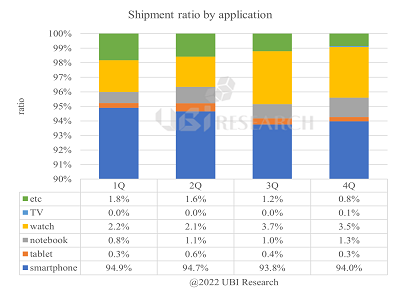
According to a quarterly analysis of Samsung Display smartphones shipments in 2021, 125 million units were shipped in the fourth quarter, showing the highest performance. This is mainly due to high shipments to Apple in the fourth quarter for OLED for iPhone. In 2021, 102 million units of OLED for iPhone were shipped and 45.4 million units were supplied to Apple in the fourth quarter. Therefore, the market share was the highest at 50.1% in the fourth quarter for flexible OLED shipments.
Flexible OLED and rigid OLED shipments were 190 million units and 257 million units respectively in 2021. The annual shipment market share was 41.6% and 56.5% respectively. Foldable OLED shipments were 8.7 million units, a market share of 1.9%.
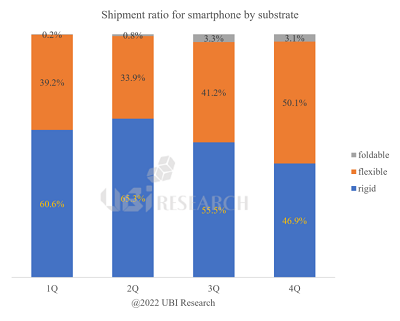
LG Display Achieves Record Sales in 2021, Swinging a Profit after Three Years
/in /by olednet
As LG Display posted the highest sales ever, at the same time it also made a sharp pivot into a profit for the first time in three years. On the 26th, LG Display announced that it had achieved annual sales of 29.878 trillion won and operating profit of 2.23 trillion won in 2021. “This is the result of the large-sized OLED panels in the premium market, the strengthening of the small and medium-sized OLED business base, and the innovation of LCD structures centered on IT products,” LG Display goes on the explain. While the overall TV market experienced negative growth last year, LG Display led the large-sized OLED business. OLED TV panel shipments grew by more than 70% compared to the previous year, which turned to profit in the second half of the year. This helped reach a break-even point.
Following the previous year’s earnings announcement, LG Display stated, “This year, we plan to expand profitability in stages based on shipment growth of more than 20% compared to the previous year and strengthened business capabilities,” and “From the second quarter, ‘OLED.EX’ will be applied to all OLED TV panel series to accelerate the trend toward OLED in the premium TV market.” OLED.EX is a TV panel that increases screen brightness (luminance) by 30% and reduces bezel by 30% by applying ‘deuterium technology’ and ‘personalization algorithm’ to organic light emitting devices. These are the core elements of OLED picture quality. In the case of small and medium-sized OLEDs, the mobile sector plans to improve profitability by expanding new models and high-end products in the second half of the year and expand to the overall mobility industry. The LCD division will continue its strategy of selection and concentration focusing on IT products.
LG Display also expressed confidence in Samsung Display, which has emerged as a new competitor in the OLED market. When asked about LG Display’s competitiveness compared to Samsung Display’s QD-OLED, Large-Scale Marketing Manager Lee Tae-Jong remarked, “Our competitor’s products have not been released yet, so an accurate comparison will be possible only after the actual launch.” He continued, ”LG Display, which has been in business for more than 10 years is far superior in our overall competitiveness in our products and cost, economies of scale, and customers. We will continue to widen the gap in the future.”
Small OLED performance in the second quarter of 2021
/in /by olednetAccording to the market track on small OLED market performance of less than 10 inches published by UBI Research, Revenue and shipments in the second quarter were about $9.5 billion and 161.7 million units, respectively. QoQ(Quarter over Quarter) revenue and shipments decreased by -14.0% and -5.8%, respectively. Compared to the year over year (YoY), Revenue and shipments increased by 70.1% and 56.3%, respectively.
In 3Q, Samsung Display’s 6G LTPO TFT line capacity is expected to be increased to 60K units. LG Display decided to invest $15,000 in the LTPO TFT line for P6 ph3. The expected equipment installation time is the second quarter of 2022. BOE’s B15, which reviewed the investment in the 6G flexible OLED line, was changed to the 8.5G line for IT manufacturing. Revenue and shipments are expected to increase in the second half of 2021 with the mass production of Apple’s iPhone 13.

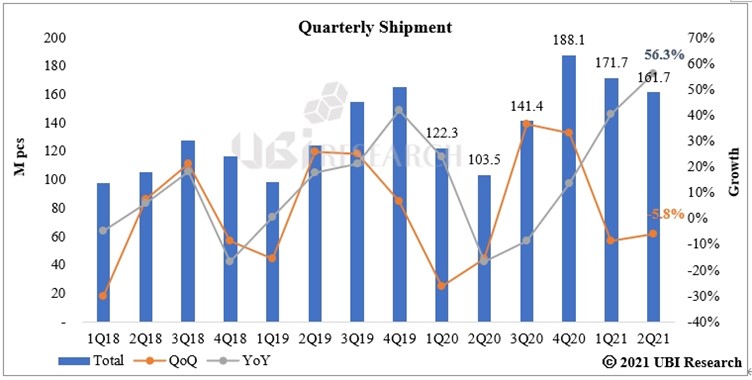
Medium & Large OLED performance in the second quarter of 2021
/in /by olednetUBI Research has published a market track on the market performance of 10-inch and larger OLEDs. Applications include TVs, monitors, laptops, and tablet PCs.
According to UBI Research’s Medium & Large OLED market track, the total revenue in the second quarter were about $1.5 billion, which is a 6.5% (QoQ) increase from the previous quarter and 129.6% in the same quarter of the previous year (YoY). In the second quarter, shipments totaled 5.1 million units, an increase of -3.6% (QoQ) and 40.4% (YoY). Samsung Display’s notebook OLED shipments in the second quarter were about 900K units. LG Display shipped 1.8 million TV panels in the second quarter of 2021.
Although there were concerns about a decrease in the utilization rate of the rigid OLED line due to the decrease in OLED for smartphones sold to Samsung Electronics, the A2 line is gradually being converted to production of OLED for laptops due to the increase in rigid OLED demand. In the first half of the year, two 12K lines were put into OLED production for notebooks, and in the second half, it is planned to increase to three or four lines.
Apple’s iPad, which will be mass-produced by Samsung Display from the end of the year, will use LTPO TFT and hybrid OLED (rigid substrate + TFE).


Forecast of OLED Light Emitting Materials Market in 2021: $15.2 billion
/in /by olednetCiting the recently published ‘2021 OLED emitting material report’, UBI Research (www.ubiresearch.com), a company specializing in OLED market research, forecasted that the OLED emitting material market size in 2021 will be $1.52 billion, a 17% increase from $1.3 billion in 2020.

By country, Korean panel makers’ material purchase rate is expected to account for 74.3% of the total market, and China is expected to account for 25.7%. By company, Samsung Display is expected to take the 1st place with 45.9% of the total, LG Display to take second place with 28.5%, and BOE to take third place with 13.7%.

By evaporation method, it is expected that the emitting materials for RGB OLED used for small OLEDs account for 81.4% of the total market, and the emitting materials for WRGB OLED of LG Display account for 18.3%. Samsung Display’s QD-OLED emitting material, which will be released in the second half of this year, is expected to account for less than 1% of the total material market as shipments of QD-OLED panels are not expected to be large.
Meanwhile, the ‘2021 OLED Emitting Material Report’ published this time includes not only the OLED emitting material market forecast, but also the development trend of low-power driving technology, the development trend of blue phosphorescent materials, and the material supply chain of Chinese panel makers. It is expected to be helpful for the companies related to emitting materials understand related technologies and forecast future technology directions and markets.
Cover window market forecast for foldable phones
/in /by olednetThe biggest difference between flexible OLED and foldable OLED will be the cover window material. In terms of price competitiveness, various Colorless Poly Imide (CPI) are superior to suppliers, but in the end, the cover window market is expected to depend on which material Samsung Electronics and Apple choose.
Samsung Display plans to supply only foldable OLEDs using UTG (Ultra Thin Glass) to Samsung Electronics and other China this year, and is expected to adopt UTG as the main cover window material in the future.
BOE and CSOT currently focus on transparent PI, but they are securing technology by continuously collaborating with UTG-related glass processing companies. For this reason, according to the UBI Research component and materials market track, UTG is expected to occupy 80% of the market for foldable cover windows in the future, and transparent PI is low in price and easy to apply to products larger than 10 inches As a result, it is expected to be applied to low-end models, tablets, and notebook models.
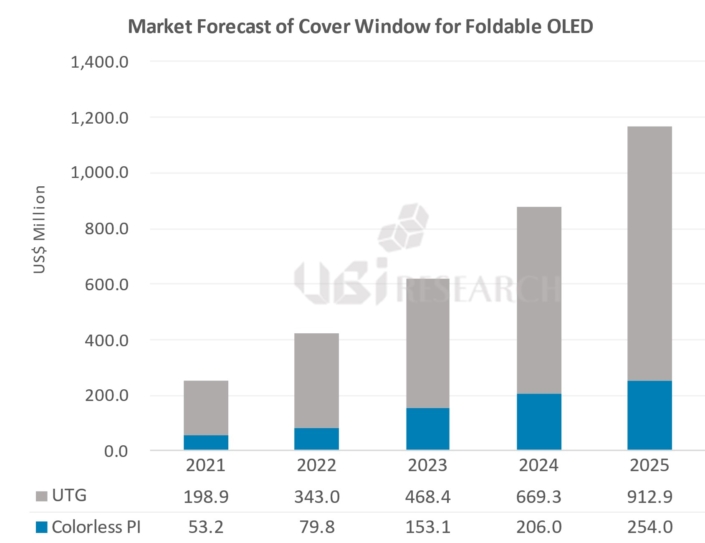
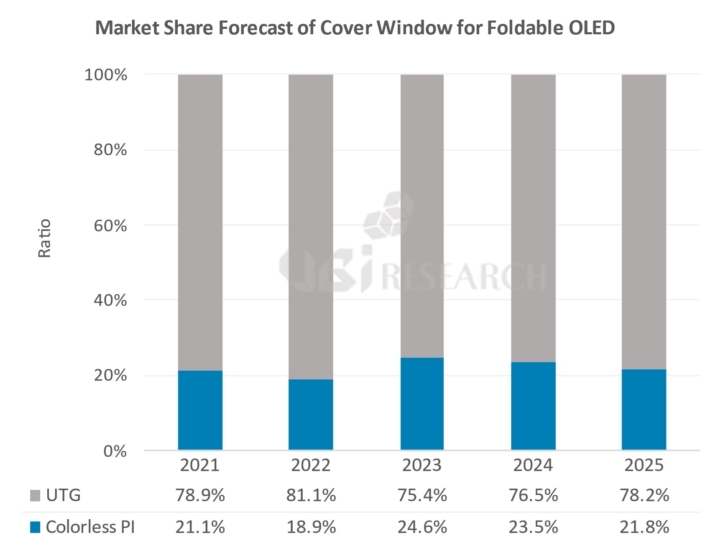
In 2020, small OLED shipments increased by 3.4%↑, sales decreased by 2.8%↓
/in /by olednetCorona 19 and Huawei’s US sanctions negatively affected the OLED market for smartphones, but it was a plus with Apple’s strong sales of iphone 12.
Samsung Display completed the Y-OCTA renovation of the Apple line in 2020, and the LTPO TFT secured a 30K scale. By the first half of 2021, the company plans to convert the LTPS line from Apple’s line to the LTPO TFT line.
The foldable phones released by Samsung Electronics in 2020 are the Galaxy Z Flip released in February and the Galaxy Z Fold 2 released in September, both in-folding and using UTG (ultra thin glass). Galaxy Z Fold 2 is a product to which LTPO TFT technology is applied.
BOE failed several times without exceeding the approval process in Apple’s iPhone12 quality test, but received final approval for panel supply at the end of December 2020. BOE’s new line, B12, is an Apple module line that starts bringing in equipment from December 2020, and is aiming for mass production in November 2021.
According to the annual small OLED display report published by UBI Research, small OLED shipments in 2020 increased by 3.4% compared to 2019, but sales decreased by 2.8%. The increase in shipments is due to the increase in OLED for watches, and the decrease in sales is due to the decrease in OLEDs for smartphones.
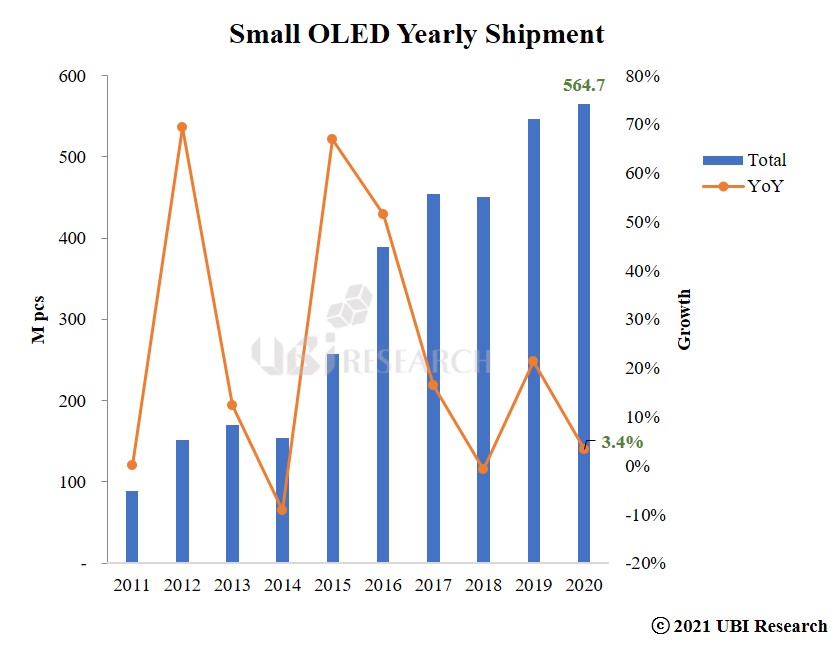
In 2020, the total sales of OLED for smartphones was 26.7 billion dollars, of which Samsung Display accounted for 78.8% with 21 billion dollars. LG Display has sales of $2.8 billion and a market share of 10.5%. Samsung Display accounted for 91.7% with 2.35 million dollars in 2019. Smartphone sales in 2020 decreased by 6.68 million units compared to 2019.
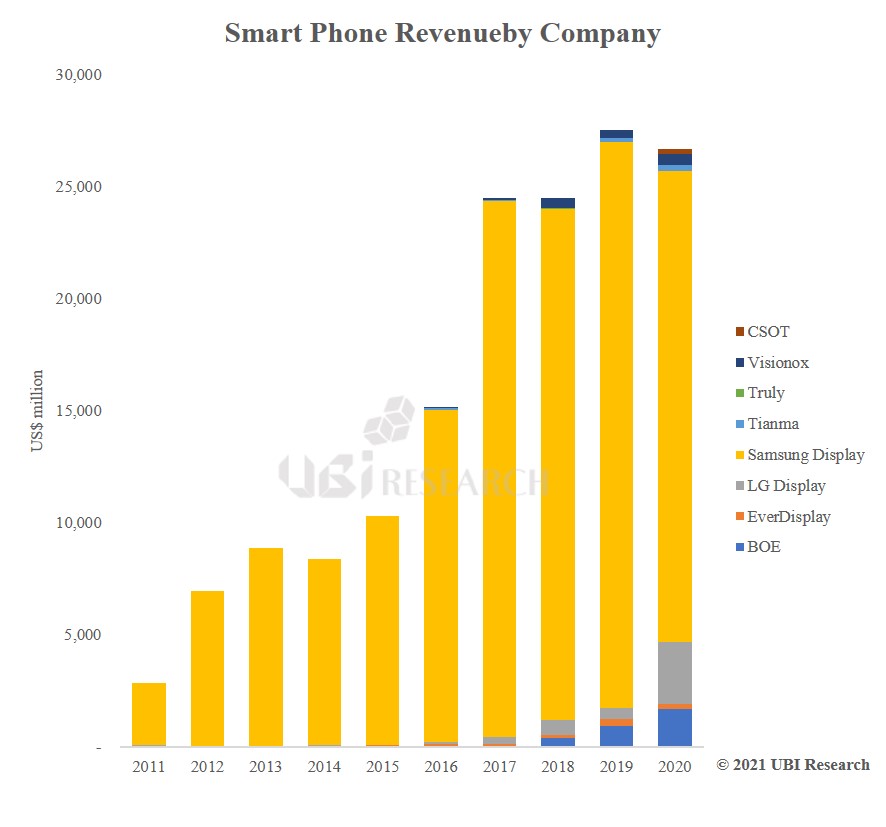
Middle and Large OLED sales growth of 40.2% in 2020
/in /by olednetAlthough Samsung Display’s rigid OLED line is expected to decrease due to a decrease in Huawei’s volume due to the US production, demand for rigid OLEDs is expected to increase as demand for laptops, monitors and tablet PCs is increasing. To respond to this, investment in rigid OLED lines in A4 is also being reviewed. This year’s notebook OLED panel is expected to come out with more than 10 different model product lines, and Apple’s OLED production for iPad is scheduled to start from 2022, so demand for middle and large-sized OLED panels is expected to increase.
In addition, LG Display, a leader in P-OLED supplying in the automotive field, is planning to supply plastic OLEDs for automobiles to German car makers by producing premium OLED panels, and Samsung Display is also supplying OLED panels for vehicles.
According to the 2021 middle and large OLED annual report published by UBI Research, the total sales of middle and large-sized OLEDs in 2020 was $3.882.7 million, and last year was $2.63 billion, an increase of 40.2% from the previous year. By application, the notebook and automobile markets have increased remarkably, and the notebook, monitor, and automotive product markets are expected to grow in 2021.
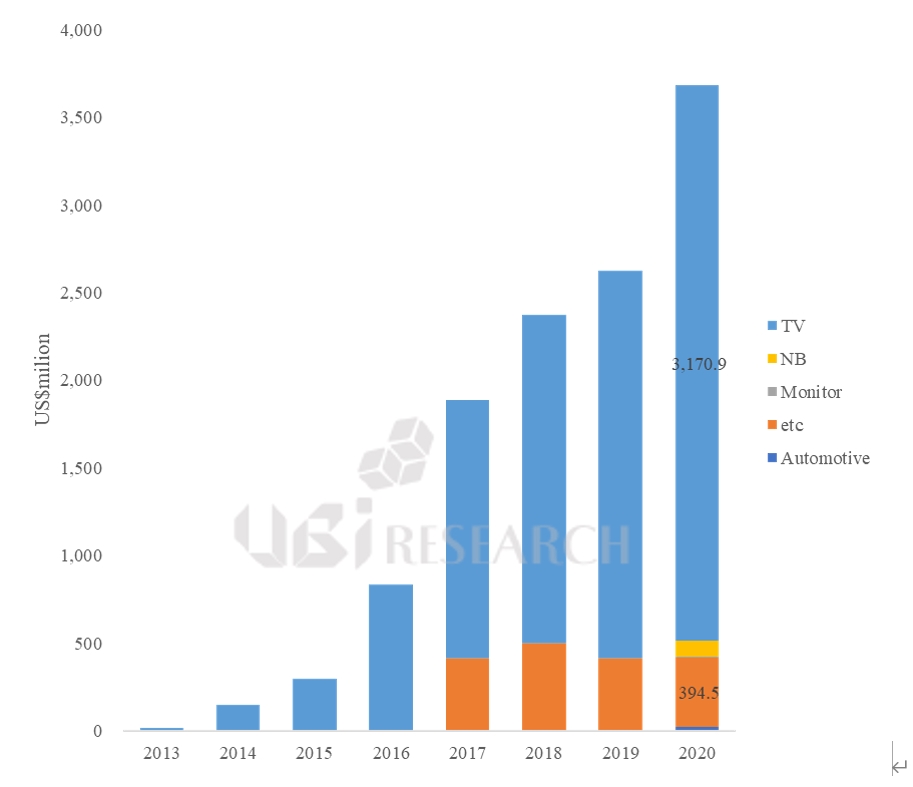
Samsung Display’s QD-OLED mass production is expected to be around December 2021, and 65-inch panels are highly likely to be used by Sony. Samsung Electronics is expected to receive only 32-inch QD-OLEDs for monitors, not purchasing 65 inches.
LG Display’s 2020 TV OLED panel shipments were counted to 4.4 million units, and if the Guangzhou plant operates at 90K from the third quarter, the production capacity will reach 8.5 million units in 2021.
Samsung Electronics’ foldable smartphone to be released in 2021, with touch pen and UTG thickness different?
/in Component /by olednetAccording to the ‘2020 OLED Components and Materials Report’ recently published by UBI Research, Samsung Electronics’ next-generation foldable smartphones to be released in 2021 are expected to be equipped with a pen function.
It is expected that the pen function will be added to Samsung Electronics’ Galaxy Z Fold2, which was released in September, but the flexibility issue of the digitizer, which is an essential material to support the pen function, and ultra thin glass (UTG), the cover window material. The pen function was not added in the end due to its thin thickness.
In order to add a pen function, Samsung Display seems to be considering applying an active electrostatic solution (AES) method that does not require a digitizer and changing the thickness of UTG.
First, the’Galaxy Note’ series uses an electro-magnetic resonance (EMR) method with a digitizer at the bottom of the OLED panel. The EMR method has good touch sensitivity and does not require a battery to be embedded in the pen, but it is not applicable to foldable devices due to the flexibility issue of the metal digitizer.
Unless the companies developing the EMR method provide a special solution, the AES method is highly likely to be applied to the pen for the next ball double device. In this case, the sensor pitch of Y-OCTA is formed more densely or the Touch IC is more complex. Can be designed.
The AES method is also being developed by LG Display and BOE to apply to foldable devices.
In addition, the thickness of UTG is also expected to change. The 30 um thick UTG, which is currently commercially available, has good flexibility, but due to its film-like characteristics, when pressure is applied with a touch pen, traces remain and may affect touch sensitivity. To solve this problem, Samsung Display is developing UTG with a thickness of more than 60 um in cooperation with glass processing companies.
As the thickness of the UTG decreases as the thickness increases, it is expected that the UTG currently under development will be applied with a concept in which the folded part is processed thin and filled with a material having the same refractive index as glass. In addition, in the future, there is a possibility that an additional coating process will be added after the reinforcement process without a protective film such as PET on UTG.
In UBI Research’s ‘2020 OLED Parts and Materials Report’, Samsung Display’s expected change in foldable OLED was written as a roadmap and the trends of related materials were analyzed. According to the report, Samsung Electronics’ application of pens for foldable devices is expected in 2021, and UTG materials are expected to lead the market at 78% by 2025 in the future cover window market for foldable devices.
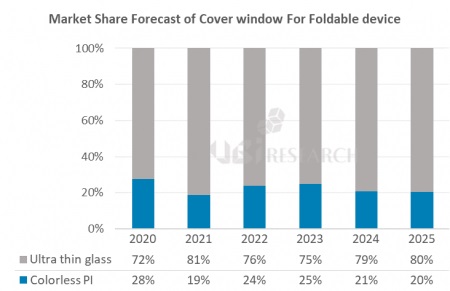
What is the difference between the touch types of each model of iPhone 12?
/in /by olednetAll of Apple’s iPhone 12 models, OLED panels will be used and consisted of four models. There are three sizes, 5.4 inches, 6.1 inches, and 6.7 inches, respectively, and 6.1 inches are divided into two models.
Samsung Display and LG Display have begun preparing to mass-produce, with recent orders from Apple. Samsung Display plans to supply OLED panels of all sizes, LG Display plans to supply 6.1-inch OLED panels, and there are differences in touch type by size.
First, on-cell touch which a touch electrode is formed on a thin film encapsulation (TFE) is applied to 5.4 inch and 6.7 inch models. Each panel maker is called Y-OCTA (YOUM on-cell touch AMOLED), ToE (touch on encapsulation), FMLOC (flexible multi-layer on-cell touch), and unlike add-on touch, a touch electrode is formed directly on the upper layer without base films. Due to this, the on-cell touch has a higher process difficulty than the add-on touch, but it is advantageous to fabricate a thin OLED panel thickness, and the process cost is also reduced.
Add-on method is applied to 6.1 inches. A touch electrode is formed on the base film, and is attached on the TFE by adhesive. It has the advantage that the process is simpler than on-cell touch.

<Flexible OLED touch type, Source: AMOLED Manufacturing Process Report>
Recently, rumors that BOE is supplying 5.4 inch and 6.1 inch OLED panels to Apple have turned around, but 5.4 inch is on-cell touch type and it is still difficult to supply for iPhone 12 due to technical difficulty. BOE is developing a 6.1-inch OLED panel and has not received calls yet.

<iPhone 12’s touch types and panel suppliers>
78.6 tons of OLED emitting material demand increased by 5.6% in 2020
/in Market /by olednetAccording to the 2020 OLED emitting material report published by UBI Research, the demand for emitting materials in 2020 is 78.6 tons, which is 4.2 tons higher than last year’s 74.4 tons. The material used for OLEDs for smartphones and mobile devices is 62.9 tons, and the OLED emitting material for TVs is expected to be 15.7 tons.
In 2019, the total emitting material market was totaled at $ 1.28 billion, and 43% of the total amount was purchased from Samsung Display. It was found that the amount purchased by LG Display was 19.4% and the BOE was 11.6%. LG Display’s purchase of emitting materials accounted for 60.8% of TV use. The order of purchase of emitting materials for mobile devices is in order of Samsung Display, BOE, and LG Display. This is because BOE has a large amount of OLED production for mobiles after Samsung Display.

The OLED panel for TV only produces LG Display, but Samsung Display is pursuing QD-OLED commercialization using blue light emitting material and QD. In addition, although BOE is a white OLED structure similar to LG Display, it is developing a top-emission structure that transmits light in the opposite direction of TFT, and it is expected that three companies will produce OLED panels for TV within a few years, and the emitting material market is expected to increase as well.
The market for emitting materials in 2020 is expected to increase by 7% from 2019 to $ 1.37 billion. Among the emitting materials, green and red hosts are expected to be $ 19.2 billion and $ 19 billion, respectively, and green dopants and P + are expected to be $ 1.37 billion and $ 1.35 billion, respectively.
Apple’s last LCD phone, iPhone SE
/in /by olednetThe iPhone SE, the last product of the LCD smartphone that Apple has opened to the smartphone market, has been released.
Apple’s 2019 model iPhone 11 had three models, the base model iPhone 11 used a 6.06inch LCD, and the advanced specifications iPhone 11 Pro and Pro Max used 5.85 inch and 6.46inch flexible OLED, respectively.
Samsung Display supplies both 5.85inch and 6.46inch flexible OLEDs, and LG Display has supplied only 6.46inch flexible OLEDs from the fourth quarter of 2019.
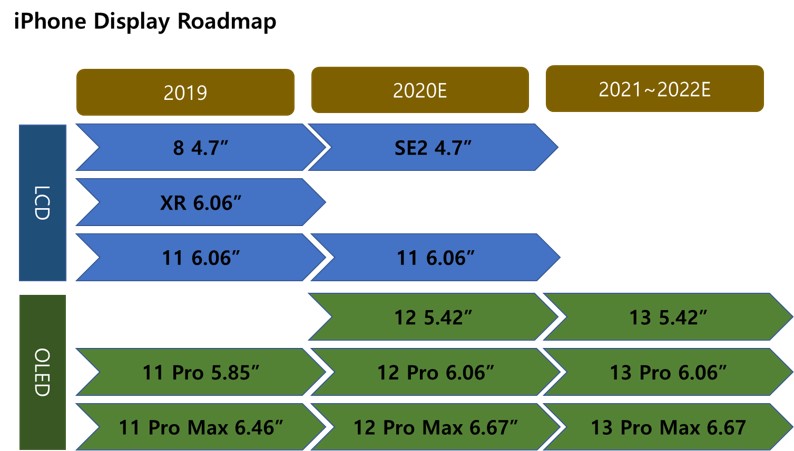
This year, Apple releases a four-model iPhone. There are three types of iPhone, SE2 which started selling this month, and 3 iPhone 12 which starts selling in September. Strictly speaking, since there are 2 models of the iPhone 12 Pro, 4 types of iPhones using OLED will be released in the second half of this year.
Apple’s current LCD phones are the iPhone 11 and the newly released SE2. Of the iPhone models released by Apple this year, only the LCD will use the SE2, and the SE2 is expected to be Apple’s last LCD smartphone.
Apple already mentioned that in 2019, all future iPhone displays will be replaced by OLEDs. Therefore, in fact, this is the reason that the SE2 released this time is expected to be the last LCD phone.
Most of the latest smartphones are more than 6 inches, but the iPhone SE2 released this time is a small 4.7-inch model using IPS LCD.

The reason Apple used a small display is believed to be a strategic product to target the mid-priced market of around $ 500. It’s currently $ 549.99 on eBay, but it’s on Amazon for $ 399.
Apple’s expected iPhone strategy is two tracks. First of all, in order to maintain the second largest market share in shipments, it is necessary to match shipments with products with a wide market of $ 500. And the operating profit creation is to fit the expensive iPhone 12 series using flexible OLED.
However, shipments of LCD phones are expected to gradually disappear after 2021, depending on the sales of 5.42 inches, the basic model of iPhone 12, which will be released in the second half of this year.
Huawei’s OLED TV launch, LG Electronics, and Sony’s 48-inch OLED TV Launch Will Further Increase the Influence of OLED TV to Oppo?
/in Set, Set, Set, Set /by olednetHuawei launch its first OLED TV and LG Electronics and Sony will launch a new lineup, a 48-inch OLED TV. As a result, the OLED TV camp and lineup are expected to become more diverse.
First, Huawei will launch its first OLED TV X65 soon. X65 is used a 24-megapixel camera to control the TV with a ‘gesture tracking’ function that recognizes the user’s face, motion, and posture, and is equipped with 14 under-screen speakers to automatically To correct the sound. The X65 used LG Display’s OLED will be released on April 8.
China’s OLED TV camp has increased to five camps from Skyworth, Konka, Changhong, and Xiaomi to Huawei. In addition, Huawei’s OLED TV launch, which is leading the Chinese smartphone market, can have a great influence on the premium TV market in the future.
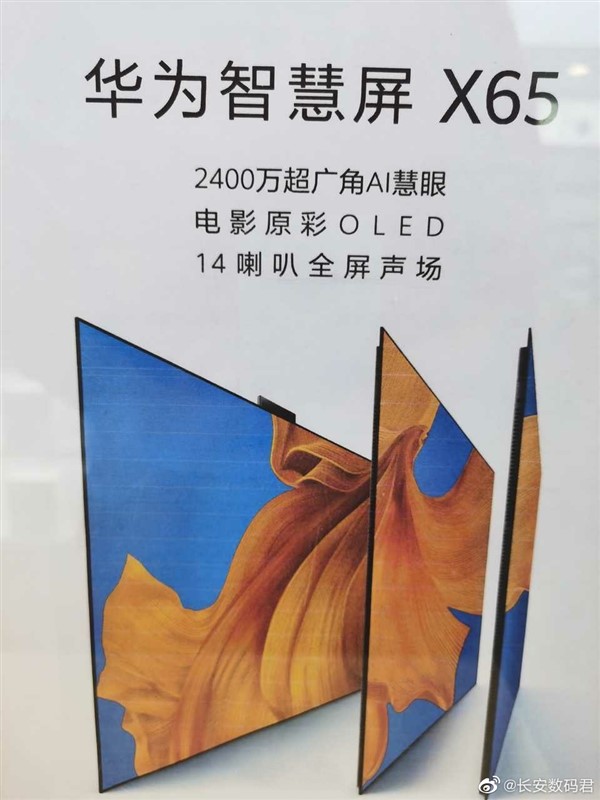
Meanwhile, LG Electronics and Sony, which are leading the OLED TV market, will launch a new 48-inch OLED TV to make the lineup more diverse. Currently, OLED TVs have only 55-inch, 65-inch, and 77-inch lineups, and are evaluated to have a relatively short lineup compared to LCD TVs. LG Electronics and Sony are planning to target the Japanese or European market with high preference for small TVs through the launch of this 48-inch OLED TV.
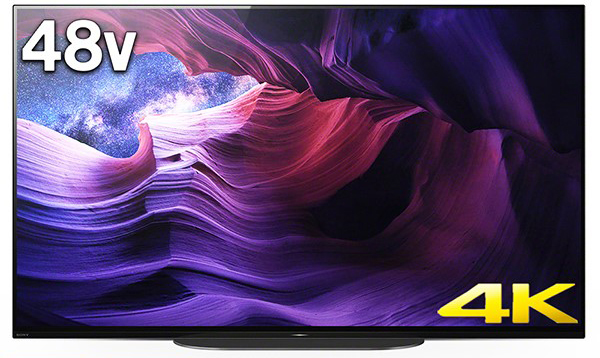
LG Electronics and Sony’s 48-inch OLED TVs are scheduled to be released in May and July, respectively.
It is noteworthy whether OLED TV will exert great influence once again in the premium TV market in 2020, such as Huawei joining the OLED TV camp and LG Electronics and Sony launching the first 48-inch OLED TV.
Samsung Display, LG Display, and OLED sales depend on the operation of the Vietnamese module factory
/in /by olednetSamsung Display and LG Display, whose business trip to Vietnam was blocked by the Corona virus, are trying to prevent delays in OLED production by launching charter.
Samsung Display, which produces OLED for mobile devices, operates a line of OLED modules for smartphones in Bac Ninh, Vietnam, and Samsung Electronics also has smartphone manufacturing plants in Bac Ninh and Tai Nguyen. Samsung Display installed the foldable OLED module line 30K in December 2019. In this module factory, Samsung Display is producing foldable OLED modules for Galaxy Z flips, which Samsung Electronics has begun selling this year. LG Display invested a total of KRW 1 trillion in Haiphong, Vietnam in May 2016 to produce the OLED module, built a module factory and started operation in September of that year.
The Vietnamese government is blocking entry from Korea to prevent the spread of coronavirus. This has made it difficult for Korean companies with factories in Vietnam to travel to Vietnam. However, Samsung Display and LG Display are preparing a charter for the normal operation of their OLED module factory and are on a business trip to Vietnam.
If Samsung Display is unable to manage the Vietnamese module factory, Samsung Electronics will disrupt the production of the Galaxy Z Flip, which is the biggest game this year, and may cause huge losses and may be affected by the leading position in the foldable smartphone market. LG Display is also in an urgent situation. From the fourth quarter of last year, LG Display began to supply pOLED to Apple following Samsung Display, and pOLED shipments to Apple are increasing this year. As LG Display supplied pOLED to Apple, sales increased significantly last year. This year, LG Display’s Apple supply is expected to reach 15 million units.
Therefore, these two companies are desperate to manage the module factory in Vietnam to maintain the OLED business.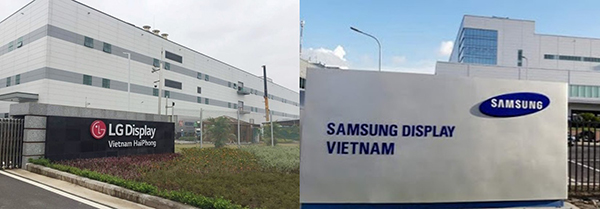
The impact of the corona virus on the OLED market in 2020
/in /by olednetDark clouds are approaching Korean industry by the corona virus that has been blown since the beginning of the year. Wuhan, the birthplace of the corona virus, is badly affecting the Chinese display industry because it is a key place where Chinese display makers are building large production bases.
Wuhan and other plant set-ups are experiencing difficulties due to the lack of manpower needed to build the line. At the same time, the utilization rate of the entire supply chain in China is falling sharply, as the labor force of parts and materials manufacturers in China is delayed to return to the factory. In the smartphone industry, the center of the OLED industry, iPhone production is affected in the first quarter. Foxconn’s factories, which produce iPhones in Zhangzhou and Shenzhen, China, are operating at 50% at end-February. This is because manufacturing workers are returning to the factory late. Companies such as Huawei, Xiaomi, Oppo, and Vivo are also hampering smartphone production due to delays in parts procurement.
Nevertheless, the production of OLED smartphones is not much affected yet. First, Samsung Display’s panel production plant, which accounts for 86.3% (2019) of OLED shipments for smartphones, is located in Korea, while the module plant in Vietnam is not affected by China. In addition, the supply chain has no effect as most of the material production bases that make up OLED panels (including modules) are also in Korea.
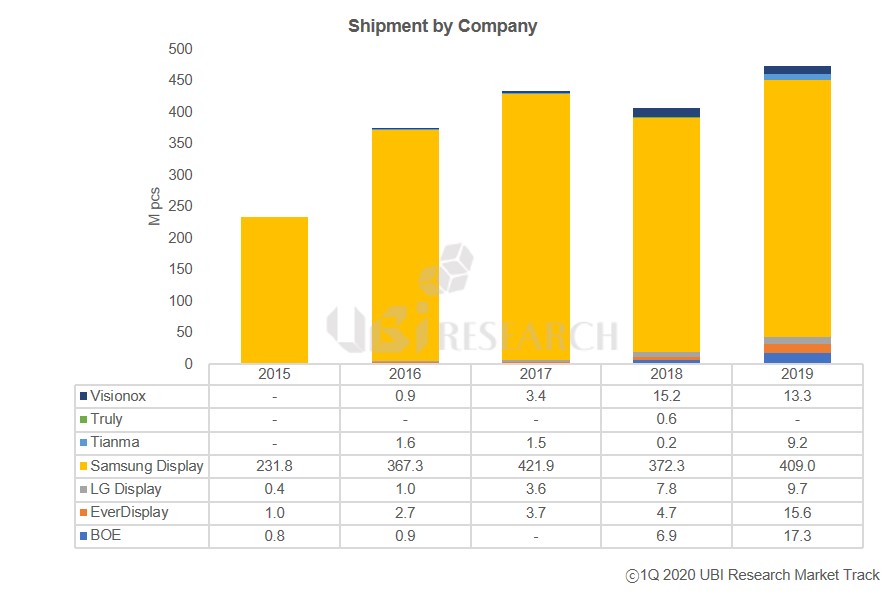
Samsung Display’s OLED production for smartphones in January and February totaled 48 million units, less than 2 million units compared to 50 million units shipped in the same period in 2019. Of these, 14 million and 17 million units were supplied to Chinese smartphone makers in 2019 and 2020, respectively. This year, more than 3 million units are shipped. So far, Samsung Display’s OLED business is not affected by the corona virus.
The total market share of Chinese OLED panel makers in 2019 is 11.7%. By February, the panel utilization rate of Chinese OLED panel makers was maintained at 80%. The impact of factory operation due to lack of manpower is about 20% because most of the display manufacturing industry is driven by automated facilities. Chinese OLED makers import most of the major materials, including light emitting materials, from Korea and Japan, so they are hardly affected by the corona virus.
The parts procurement status of smartphone makers in China affects the market. If Chinese suppliers, including Huawei, fail to procure parts in China, smartphone production will be hampered. However, as Samsung Display’s OLED production for China is progressing smoothly, Chinese smartphone makers have a strategy of maintaining OLED smartphones, which are expensive brands.
In addition, the first quarter is the off-season with the lowest shipment season, so even if it is difficult to operate a smartphone manufacturing plant until March, the impact on the overall market is about 10%. After the second quarter, if the corona virus subsides, demand can resume.
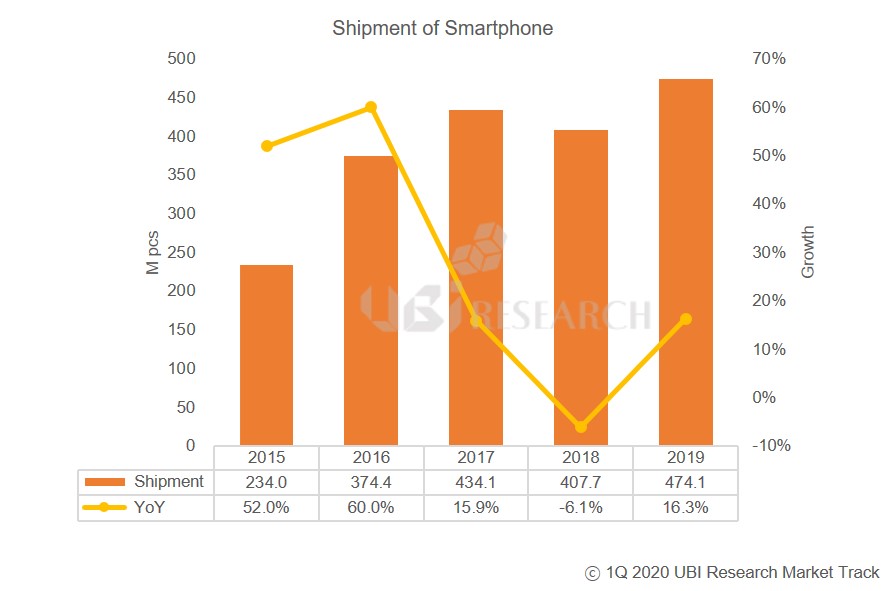
The problem is from March. China’s corona virus has slowed down, but South Korea has been expanding since the last week of February. There is someone has a virus at Samsung’s Gumi smartphone manufacturing plant. In addition, the Vietnamese authorities, concerned about the influx of South Korea’s virus, refused to visit Koreans, which may make it difficult for the headquarters to properly deal with problems with Samsung Display’s module plant management in Vietnam.
Most important of all, the corona virus is spreading all over the world, and economic activity is severely reduced. In China, the entrance of the apartment is blocked, so it is difficult to bring TV. The Chinese TV market is shrinking. Many people are refusing to go out because they are concerned about a corona virus infection, so fewer people visit a store and buy a smartphone. Consumer sentiment is falling significantly.
Assuming that the corona virus crisis will end in March in Korea and China, the impact of the smartphone OLED industry on 2020 is estimated to be about 5%, but if it is prolonged, it may be adversely affected by more than 10%. Assuming that the corona virus crisis will end in March, the impact of the smartphone OLED industry on 2020 is estimated to be around 5%, but if it continues until the first half of the year, it could be adversely affected by 10%.
The OLED business for TV is slightly different. LG Display’s factories that produce exclusive OLED panels for TVs are located in Paju, Korea, and Guangzhou, China. The Paju plant is not disrupted at all. Like OLEDs for smartphones, parts and components are mostly supplied by Korean and Japanese companies, so Paju factory is not affected by China.
The problem is the Guangzhou plant. LG Display has been expected to produce panels since September 2019, but its supply has been delayed due to poor panel lifetime. LG Display has begun production of panels again this year and is undergoing product tests from customers. Recently, however, the corona virus has begun to spread in Korea, making it difficult for Korean engineers to go to Guangzhou. Even if the corona virus disappears in the first quarter in China and the factories operate normally, it may take some time before the panel is supplied from the Guangzhou plant.
According to Ubi Research’s OLED market track, the 2020 forecast is 4.95 million units without considering the corona virus situation, of which 750,000 OLED panels for TV can be produced by LG Display in the first quarter. If the 55-inch production volume is large, up to 800,000 units can be produced. Since the data were prepared in anticipation that panels produced at the GuangZhou plant will be available from the second quarter, LG Display’s panel supply is expected to be 1.4 million units in the second quarter.
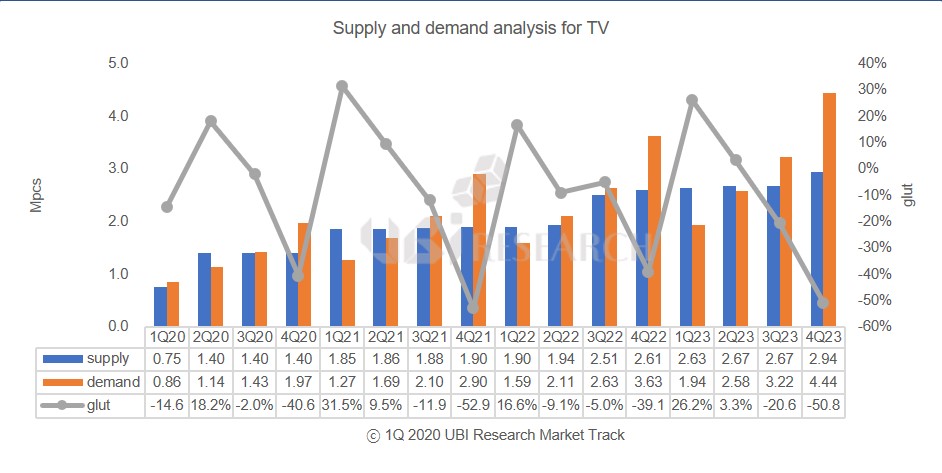
However, it is possible that production will be delayed after May if the customer’s quality certification of panels produced at Guangzhou plant is delayed due to the Korean coronavirus rather than the Chinese coronavirus. In that case, the annual TV panel production could be reduced by about 200,000 units, which is expected to decrease by 4% from the estimated total. However, if the corona virus is prolonged by June, it can cause up to 10% of adverse effects. The market should consider 500,000 fewer than expected.
LG Display named Huawei flexible OLED supplier for new smartphone P40 Pro
/in /by olednetLG Display is the top OLED company with a monopoly market in the production of OLED panels for TVs, but the performance was low in the flexible OLED market for smartphones until the first half of 2019.
LG Display built a flexible OLED line after Samsung Display and focused on panel sales, but failed to supply flexible OLED by pushing BOE to Huawei’s P30 Pro model in 2019. However, in the second half of 2019, it succeeded in supplying panels to Huawei for Mate30 Pro, and began supplying flexible OLED for iPhone to Apple.
Huawei’s P40 Pro shipment target is 12 million units, and LG Display is expected to supply 50%. The variable is a new coronavirus. It could change Huawei’s smartphone launch schedule and volume.
Huawei is highly dependent on domestic demand, and coronaviruses can reduce shipments by more than 10%.
LG Display Announces Q3 2019 Results, Revenue 5,817.2 Billion won, Operating Loss 436.7 Billion won
/in /by olednetLG Display announced on the 23rd that it recorded sales of 5,827.1 billion won and operating loss of 436.7 billion won in the third quarter of 2019 according to K-IFRS.
Revenue increased 9% QoQ (5.35 trillion won) due to the full-fledged sales of plastic OLED business and the expansion of mobile panel sales.
On the other hand, 3Q operating loss fell last quarter due to a sharp drop in LCD TV panel prices that exceeded market expectations, reduced utilization of related fabs, and increased depreciation expenses associated with the operation of new plastic OLED plants. The operating loss recorded 436.7 billion won.
Net loss was 442.2 billion won and EBITDA was 611.8 billion won (EBITDA margin of 10.5%).
Revenue breakdown in the third quarter of 2019 recorded 32%, a 9% QoQ decline for TV panels due to a decline in shipments due to adjustments in LCD TV fab utilization. Mobile panels recorded 28%, up 9% p QoQ, due to full-scale production of plastic OLED panels. Notebook and tablet panels accounted for 21 percent and monitor panels 18 percent.
Dong-hee Seo, Executive Vice President of LG Display CFO, said, “LG Display is innovating its business structure to reinforce its fundamental competitiveness and have a differentiated competitive edge.” In addition, the company plans to find ways to secure competitiveness from a more fundamental and long-term perspective, while at the same time strengthening its IT, commercial (auto) and auto (business) business capabilities that can differentiate in the existing LCD sector. Large OLEDs will accelerate the market trend utilizing the inherent value of products and continue to stabilize the business of plastic OLEDs for smartphones. ”
In addition, “We will communicate with the market by establishing a long-term vision centering on technologies and product lines that can quickly complete the ongoing LCD structure improvement activities and provide differentiated value.”
[Press Release] OLED production capacity will increase to double in 2023.
/in Equipment /by olednetUBI Research has published [2019 OLED Equipment Report] that forecasts the OLED equipment market. According to the report, the total substrate area of display companies in 2019 will be 34.9 million square meters, which will be 68.5 million square meters in 2023 and double after four years.
OLED substrate area growth is attributable to investments made by OLED lines for TVs driven by Samsung Display and LG Display. Currently, OLED manufacturing lines for TVs are 8G lines optimized for 55-inch panel production. However, the demand for premium TVs is shifting from 55-inch OLED TVs to 65-inch TVs. By 2021, the 65-inch OLED TV market will account for more than 40%. In response to these market conditions, LG Display is preparing to invest 10.5G lines in the most efficient production of 65-inch panels. In 2023, the substrate area of a large OLED line is expected to occupy 42% of the total substrate area.

<OLED production capacity by generation>
The substrate area of the 6G line is expected to grow to 13 million square meters this year and to 19.3 million square meters in 2023. Most of this is due to investment by Chinese panel makers. In China, the smartphone market accounts for about 40% of the global market, so Chinese smartphone makers have a very high market share based on the domestic market. Huawei has recently become the world’s second-largest shipper based on its domestic market. Chinese panel makers are boldly adding a 6G flexible OLED line to Chinese smartphone makers, with the Chinese government’s huge support.
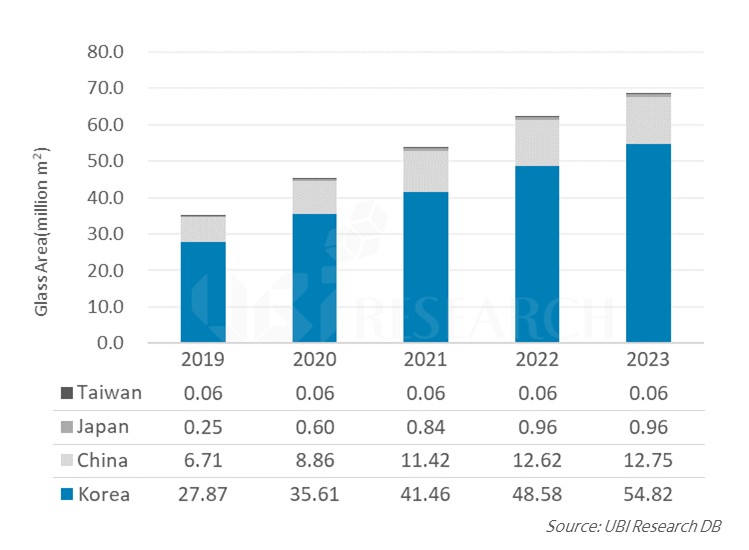
<OLED production capacity by country>
In 2019, Korea’s OLED production capacity (substrate area) will total 27.9 million square meters, accounting for 80% of its total production capacity and expanding to 54.8 million square meters by 2023. The market share will remain at 80% and lead the OLED industry.
Chinese panel makers are expected to stay at around 20% as they are investing only in OLED production lines for mobile device.
The OLED manufacturing equipment market (excluding logistics equipment) is estimated at $ 28.4 billion for four years from 2019 to 2022 due to investment by Korean and Chinese panel makers. Among them, the sixth-generation equipment market is expected to account for 61% of the total equipment market, at $ 17.2 billion.
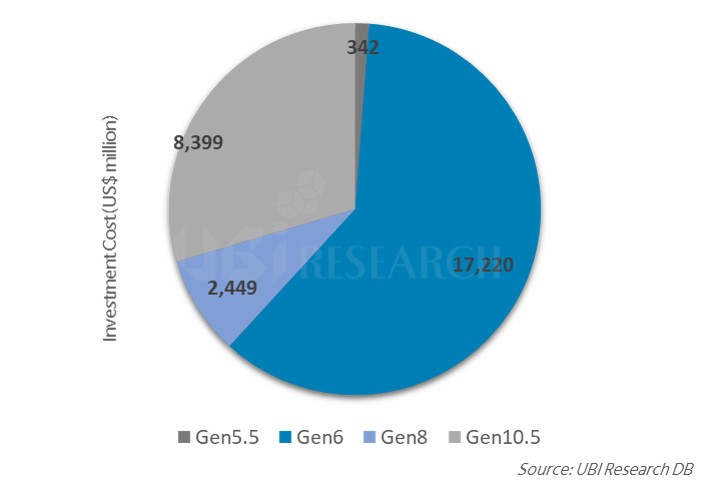
<Equipment Market Forecast by Generation (2019 ~ 2022)>
[Press Release] AMOLED components and materials market grew to $ 24.15 billion in 2023
/in Component /by olednetAlthough Samsung Electronics and Apple’s OLED smartphone market are stalled, Chinese smartphone makers are gradually increasing their use of OLEDs based on the huge smartphone market in China. As a result, BOE and Chinese panel makers have aggressively established a Gen6n flexible OLED plant, which is driving the OLED industry.
As a result of UBI Research’s panel makers’ operation rate analysis due to OLED plant expansion and supply and demand, the market for various component materials (excluding light emitting materials) that make up OLEDs is expected to reach $13.9 billion in 2019 and expand to $ 24.15 billion in 2023.
Recently, as the production of foldable OLED has started, various kinds of films that are not applied to LCD are emerging as core materials.
In the [2019 OLED Components and Materials Report] published by UBI Research, we examined the foldable OLED structure of Samsung Display, LG Display, and BOE, and analyzed the thickness and characteristics of the films that make up the module.
In the OLED components and materials market, components for TV OLEDs will grow rapidly to reach $ 19.1 billion in 2023 and lead the OLED industry.
OLED Daily Issue, April 23, 2019
/in Others /by olednet
(Full text of articles: http://news.donga.com/3/all/20190421/95157197/1)
The Chinese companies’ volume offensive raised concerns that the OLED industry, following liquid crystal displays, could face oversupply problems. Analysts say that while South Korean display manufacturers’ performance in the first quarter has deteriorated due to a sharp drop in prices of LCD panels, even OLEDs, which are seen as new growth engines, could be on the verge of oversupply in the near future.
According to a recent report released by Hana Financial Management Research Institute on Monday, the production capacity of OLED plants currently being built by Chinese companies such as BOE, CSOT and TCL is twice that of South Korea.

(Full text of articles: https://www.hankyung.com/economy/article/2019042211521)
LG Group is speeding up efforts to reorganize its business portfolio for future growth. LG Display’s decision to withdraw from its organic light-emitting diode (OLED) business for general lighting is part of its objection. The “choice and focus” strategy has become a keyword that penetrates LG Group Chairman Kwang-mo Koo “New LG,” who headed the group last year.
According to LG Group and others on the 22nd, LG Display has given up its OLED business for lighting that it has been pushing as a new growth engine. It has been about a year and six months since it started mass-producing products from new OLED production lines.
It is heard that LG Display has decided to withdraw from markets by gradually reducing mass production of OLEDs for lighting that are produced at 5th generation OLED lines (P5) in Gumi, North Gyeongsang Province. Instead, it has decided to focus on OLED markets for vehicles that have huge growth potential and can produce synergy with the group’s automotive electric field (electric and electronic devices) business. LG’s acquisition of ZKW, which is a global automotive headlamp manufacturer, also affected LG’s ability to provide lighting for vehicles.
LG Display entered the general lighting market by introducing a new brand called ‘Luplex’ at the end of 2017. However, it is rumored that it has decided to give up its business after losing out on price competition from current LED (light emitting diode) lighting companies.
OLED emitting materials market to grow to $ 1.71 billion in 2019
/in /by olednetOLED light emitting materials market is gradually increasing as Chinese companies enter OLED panel market led by Samsung Display and LG Display.
The 2019 OLED emitting material report, published by UBI Research, predicts that the emitting material market in 2019 will reach $ 1.17 billion. 2021 and 2023 are expected to grow to $ 1.87 billion and $ 2.0 billion, respectively.

The size of light emitting materials consumed by Korean companies will account for 70.2% in 2019 ($ 0.82 billion), and its share will increase to 75.6% in 2023.
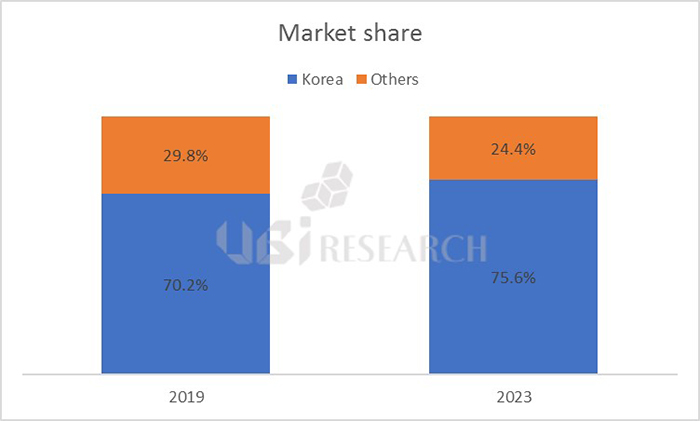
Korea’s emitting material market is growing because the consumption of OLED materials for TVs is soaring. In 2019, 21.1% of light emitting materials for TVs are expected to increase to 49.7% in 2023.
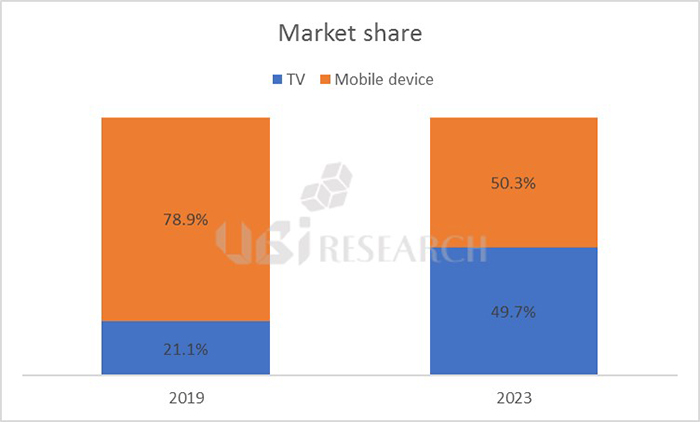
[2019 OLED KOREA] LG Display “8K is not everything. OLED will prove worth it”
/in /by olednet“8K is not everything. OLEDs will provide new value not only in high resolution, but also in rollable typed and transparent displays ”
said Ko Kyoung Young, senior director of global promotion for LG Display’s TV division.
He emphasized this at the 2019 OLED KOREA held, the Novotel Hotel in Gangnam from March 6 to 7, 2019.
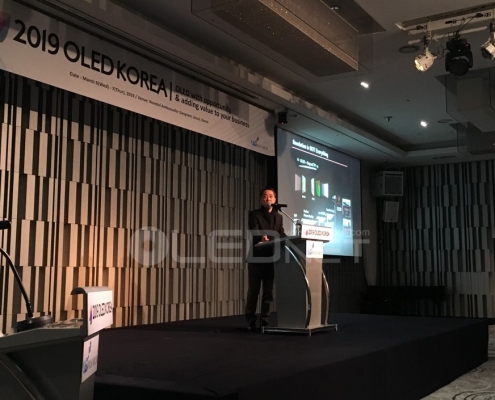
“Currently, 8K TVs are not attractive due to not ready for content and proper pricing” said Goh. However, OLEDs can provide new value, such as rollable and transparent displays, “he said that OLEDs will be the game changers of the future display era.
“The premium TV market which has been downsizing since 2014, started grow again in 2017 due to entering a new market of OLED TVs. In addition, we see OLED TV is leading the market last three years through it has been ranked from top to the 8th in the consumer reports , increase of global growth opportunities”
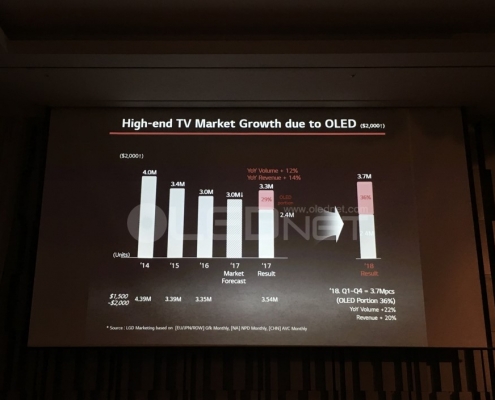
He also mentioned the OLED approach would overcome the scalability limitations that could be the best communication tool available anywhere in the fourth industry market. In addition, it can be applied to gaming monitors and automotive displays that are becoming bigger and bigger. “Global automobile companies such as BMW and Audi are in discussions with understanding display companies to apply OLED to future vehicles.” Director Ko said, to lead the premium TV market, we will support to boost production for large-scaled OLEDs by 2021, the expansion of the 4K and 8K
OLED TV lineups, and the creation of new platforms such as rollable and transparent displays. Notably he said, “8K OLED TV is planned to be 88, 77 and 65 inches, and 4Ks will be expanded to 77 inches, 65, 55 and 48 inches.”
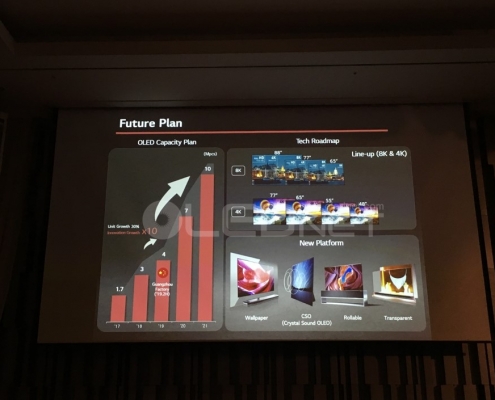
Lastly, Ko announced that will continue to study OLED resolution and brightness lifetime through the development of oxide TFT and new materials along with transparent display and solar technology for the future.
[OLED KOREA 2019] Early Bird Registration D-4 (until January 31)
/in /by olednetThe year 2018 was the inflection point for new application that had never existed in the OLED industry. Newly introduced OLED applications in 2019 include foldable phone, 8K OLED TV, rollable OLED TV, monitors made of inkjet technology, and automotive side view display.
The speaker of OLED KOREA 2019 consists of companies related to these five applications and presents the market and technology direction in 2019.
[Speaker]
Samsung Display Hyein Jeong
LG Display KY(Stephen) Ko
TCL Dr. Jueng-Gil(James) Lee
JOLED Dr. Toshiaki Arai,
Boeing Dr. Julian Chang
eMagin Dr. Amal Ghosh
UBI Research Dr. Choong Hoon YI
Cynora Dr. Andreas Haldi
Merck Dr. Remi Anemian
Sumitomo Chemical Takeshi Yamada
UDC Dr. Mike Hack
Kyulux Dr. Junji Adachi
Kateeva Kyung-Bin Bae
Idemitus Kosan Jisung So
Kolon Dr. Chung-Seock Kang
3M Sun-Yong Park
Nanosys Dr. Nahyoung Kim
ETRI Dr. Hyunkoo Lee
AMAT Dr. Robert Jan Visser
OTI Dr. Michael Helander
CES2019, the Biggest Issue of TV is LG Electronics OLED TV R
/in /by olednetReporter : Daejeong Yoon
The CES, held in early January of each year, is the most important event to understand all of the consumer electronics trends of the year. This year, TV makers from all over the world exhibited a variety of products to attract spectators to the event.
When OLED TV occupied more than 50% of the premium TV market with more than $ 2,000, the LCD TV industry sought to prevent the OLED TV market from expanding by exhibiting 8K LCD TVs to CES. However, the attention and admiration of the spectators were poured into OLED TV R.
The 8K TV market began to open slightly from last year, in preparation for the 8K broadcast starting from the Tokyo Olympics in 2020. LCD TV companies displayed 8K LCD TVs of various sizes to preoccupy the market with the keyword of 8K. LCD TV, however, has not been recognized by viewers as a new TV product since Sharp has already exhibited steadily.
Another reason is OLED TV R displayed by LG Electronics. In the main body with built-in speaker, OLED TV rises up and goes down again. A lot of people came to see OLED TV R to shoot.
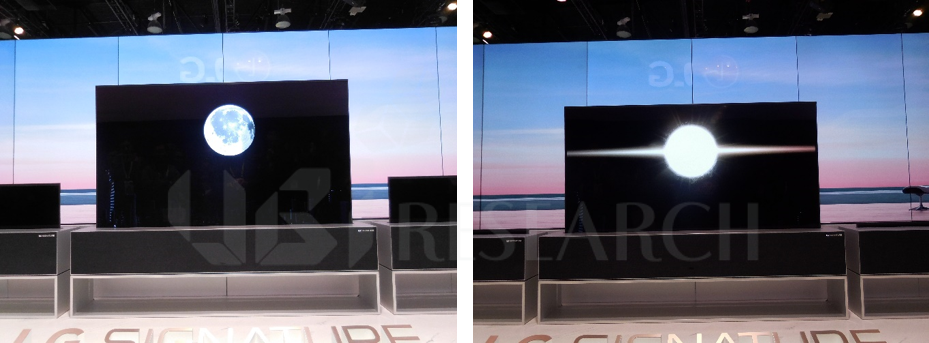
<LG Electronics, OLED TV R>
Last year, micro LED TVs became more prominent. In addition to Samsung Electronics, Sony, TCL and Hisense exhibited micro LED TVs this year. It seems that the gap of micro LED TV technology between Korean companies and Chinese companies is only about one year. In the micro LED TV market based on assembly technology that does not require special manufacturing technology, China, which is the world’s best LED industry and infrastructure, is expected to dominate the market soon.
However, as LG Display has a unique OLED TV manufacturing technology, which has a very complicated panel structure and manufacturing process, the technological gap between Korea and China is expected to be more than five years difference. In this situation, OLED TV R, released by LG Electronics, once again realizes that Korea’s OLED technology is the best in the world.
On the other hand, TV companies’ display of OLED TVs, except for LG Electronics, has stagnated. These companies are not yet receiving 8K OLED panels and rollable OLED panels from LG Display. Even Sony does not have any special features, only OLED TVs that are well known so far.
As a result, the CES TV show was notable only for LG Electronics.
It is judged that LCD TV using mini LED that TCL has released can compete with OLED TV in this exhibition. The contrast ratio is displayed as 1,000,000: 1 similar to OLED TV. Black is a very good product that has a vibrant color and contrast ratio similar to OLED TV. However, a holo-effect was found around the bright screen displayed on the black desktop. It is a phenomenon that the surroundings appear to spread brightly. As it is invisible to non-specialists, it is competitive in price and is a product that can compete well with OLED TVs.
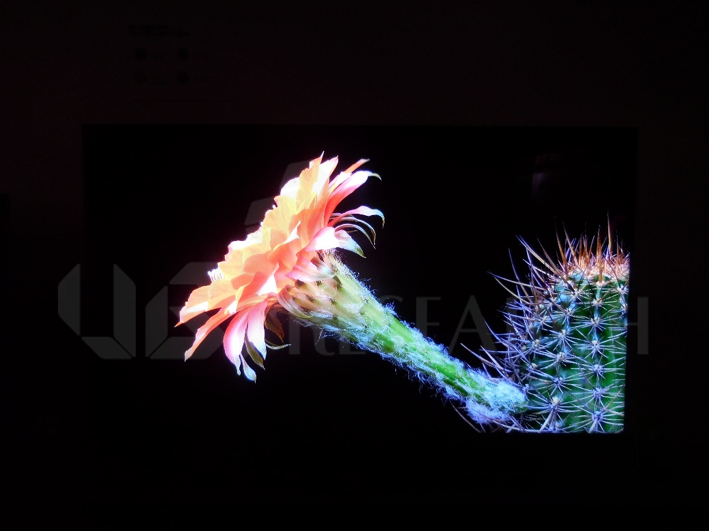
< TCL, 8K QLED TV with mini LED>
LG Display Vice Chairman Han Sang-Bum, “50% of sales of OLED and upbringing business in 2020”
/in /by olednetGrowing into the mainstream of OLED growth by expanding large OLED, differentiated products and supply
■ Small and Medium-sized POLED, strengthening fundamental business capacity and preparing future products such as Foldable
■ Develop commercial and automotive products, new technologies / new markets and develop into first-class business
LG Display is one of the world’s largest electronics exhibitors, and will hold a press conference at the Las Vegas Convention Center (LVCC) in Las Vegas on June 7, the day before the opening of the Consumer Electronics Show (CES) with Han vice chairman, executive vice president Kang In-Byoung, Strategy and Marketing Group Director Song Young-kwon, and other executives.
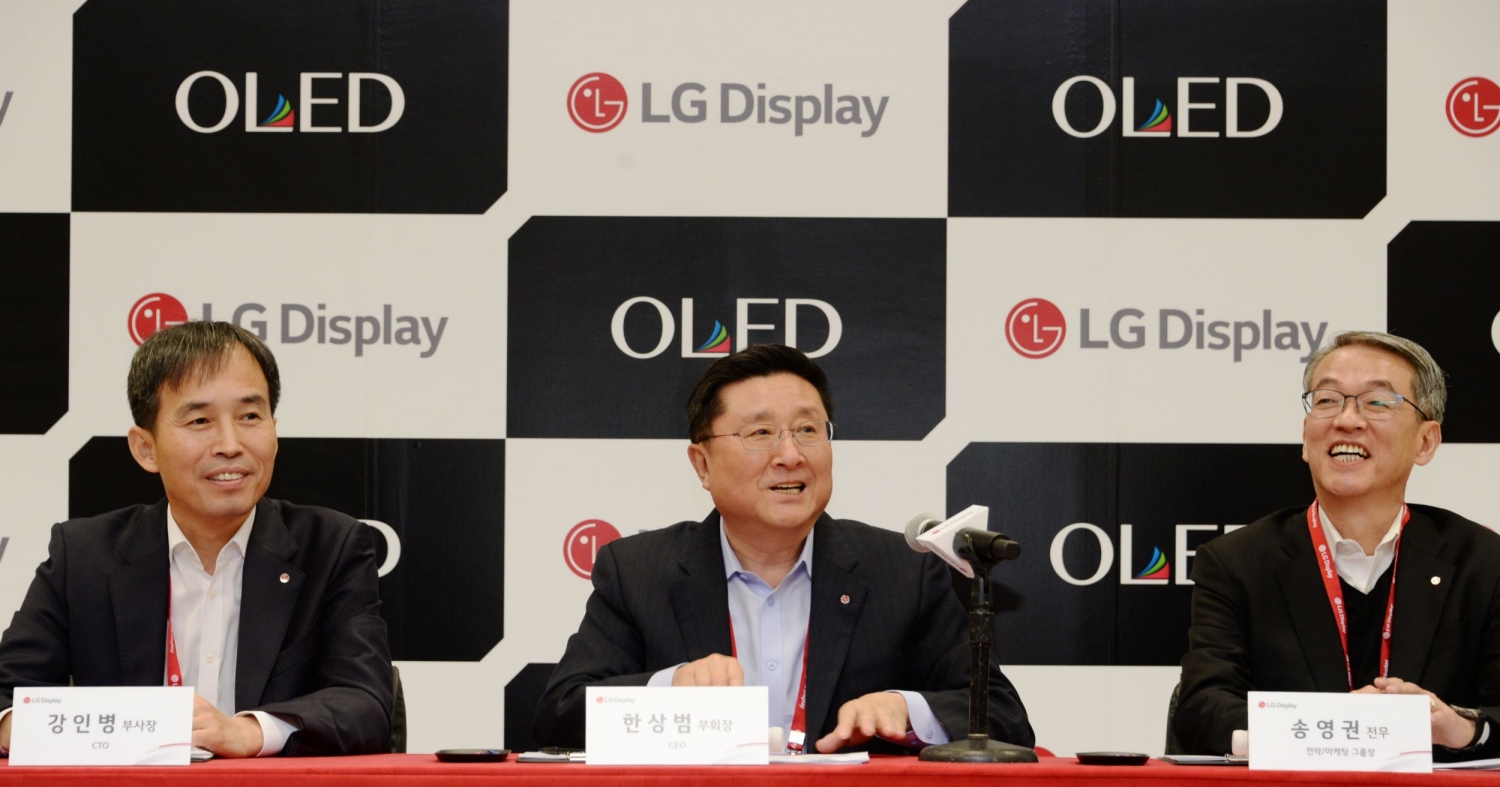
At the meeting, Han Sang-bum said, “Although there were many difficulties due to excessive supply and enormous investment due to intensified global competition last year, large-sized OLED business turned to surplus and stable profit was generated mainly in high value-added products. “This year, LG Display will focus on OLED investments, accelerating OLED growth, and focus on commercial and automotive businesses. By 2020, LGD will account for more than 50% of total OLED and growth businesses. “He said.
To this end, LG Display plans to expand its large-size OLED market, strengthen its fundamental business capabilities in small- and mid-sized P-OLED (plastic OLED) businesses, and develop new markets with differentiated commercial and automotive products.
■ Large OLED, differentiated products and supply expansion
Since LG Display first supplied OLED TV panels in 2013, LG Display has continued to develop its technology. And last year, it sold nearly 3 million units and developed into a strong player in the premium TV market. This year, the company plans to expand its TV product lineup from the existing 4K resolution to 8K, and to further enhance its competitiveness by further enhancing performance such as luminance and response time. In addition, the company will expand its market by expanding differentiated products such as wall paper, CSO (Crystal Sound OLED), rollable and transparent display. LG Display will complete the G8.5 OLED panel factory in Guangzhou, China in the first half of this year, and mass-produce OLED from the third quarter. Through this, the company plans to expand its sales volume from 2.9 million units in 2018 to 4 million units this year, and to achieve more than 10 million units in 2021.
In addition, LGD will expand sales areas for existing customers, strengthen collaboration with strategic customers, and increase sales of premium products such as ultra-large size panel.
■ Small and mid-sized P-OLED, strengthening fundamental business capacity and preparing future products.
LG Display is targeting the small- and mid-sized OLED market through P-OLED.
This year, it is a great challenge to develop core technologies and products for strategic customers in a timely to raise market share of small- and medium-sized panel.
In addition, LGD plans to increase the production capacity of the Gen 6 Gumi factory, which has a capacity of 15,000 sheets per month, and to expand the P-OLED production capacity by early stabilizing the Gen 6 factory in Paju.
In addition, LGD plans to steadily prepare related technologies and infrastructure so that future products such as Foldable can be released on time.
■ Commercial and automotive displays, Fostering first-class business
LG Display nurtures the rapidly growing commercial and automotive businesses to first-class business.
In the commercial market, LGD plans to pursue differentiated products such as 98 and 86 inches, ultra-slim products such as in-touch, bezel of 0.44 mm, transparent and gaming.
For automobiles, LTPS-based high-resolution LCDs and P-OLEDs are expected to focus on 8-inch and larger screens and high-resolution products. In addition, LGD will prepare its production infrastructure to expand its business in a timely manner and further strengthen its cost competitiveness, thereby achieving the first place in the fast growing auto market.
This year LGD plans to complete investment in preparation for the future, which began in 2017. LGD Han Sang-Bum, vice chairman of LG Display, said, “LG Display will be able to lead the global display market once again with OLED.
[IMID 2018] LG Display, showcased 2-stack RGB OLED for automobile OLED with improved life span.
/in /by Daejeong YOONAt IMID 2018 held in BEXCO, Busan on August 29, Kim Kwan-Soo, research fellow of LG Display presented about a new OLED technology for automotive displays.
Kim said that RGB OLEDs applied to mobile devices and WRGB OLEDs applied to TVs do not satisfy customers’ needs in terms of life span. To solve this issue, he introduced 2 stack RGB OLED in which RGB OLED has the same tandem structure as WRGB.
Because 2 stack RGB OLED can be thick due to adding a layer of CCL (charge generation layer) to the multi-layer structure, HTL is made thinner than before and the charge balance of the emitting layer is optimized.
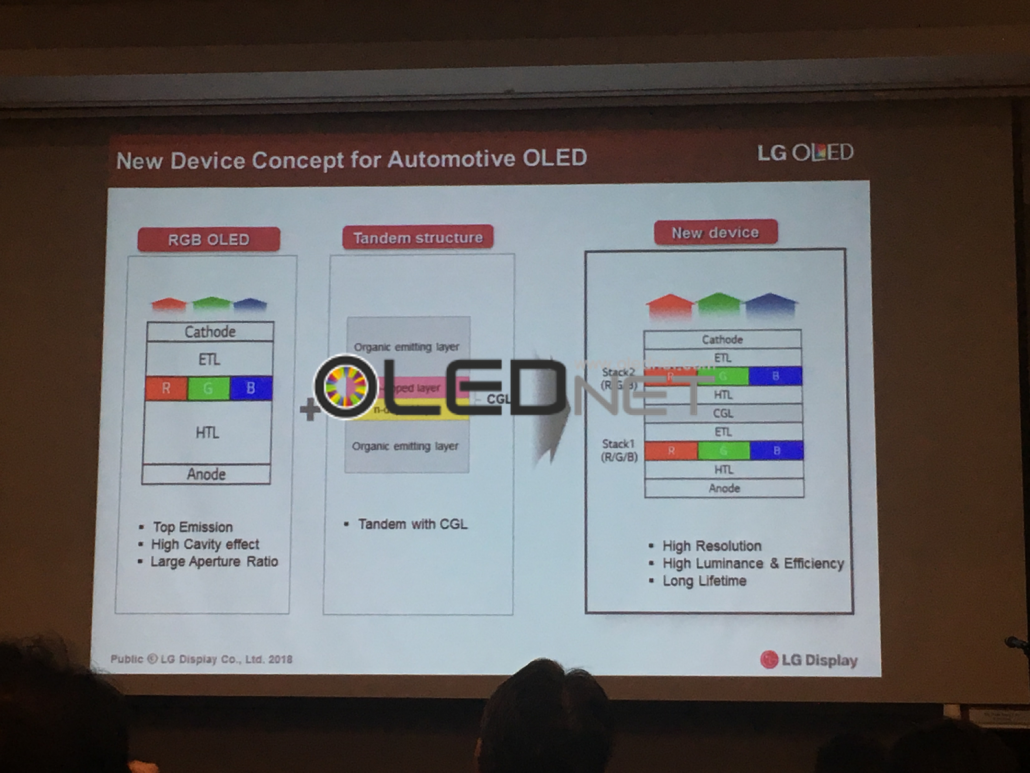
As a result, the 2-stack RGB OLED shows 1.5 ~ 2 times higher emitting efficiency than the 1-stack RGB OLED. Its lifetime is increased by 4 times on T80 basis.
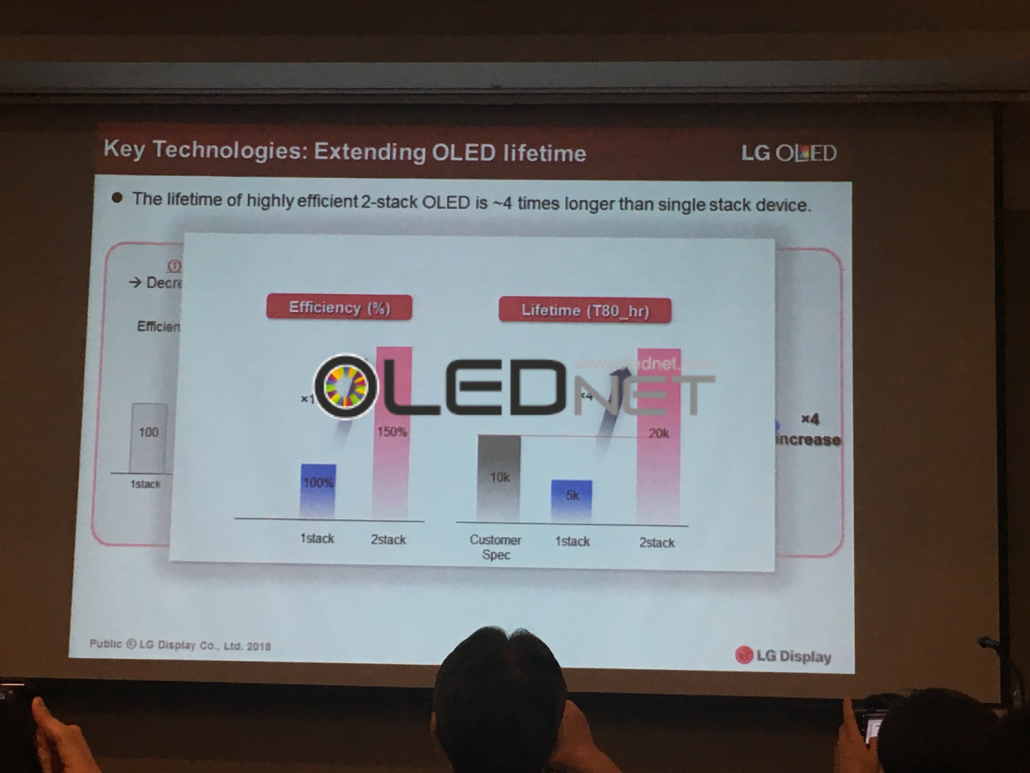
However, the 2-stack structure has a disadvantage in that it has higher power consumption than the general structure. Thus, it is necessary to make efforts to solve this disadvantage.
[IMID 2018] LG Display and Samsung Display exhibited a large number of large, and small & medium sized OLED applications.
/in /by Daejeong YOONLG Display and Samsung Display introduced a number of applications using OLED at IMID 2018 held in BEXCO, Busan, drawing attention from many visitors. In particular, LG Display displayed its strategies mostly for large OLED applications such as 77-inch transparent OLED and 55-inch video wall OLED, while Samsung Display introduced the small and medium sized OLED applications mainly for automotive and virtual reality devices.
First, the panel thickness of the 77 inch transparent flexible OLED introduced by LG Display is 400 μm, the bending radius is 80 mm, and the luminance is 200 nit based on full white.
LG Display explained that it would improve the required transmittance and durability. Also, it commented that the goal is to reduce bezel to 0.5 mm at its display of 4 FHD OLEDs with 3.8 mm bezel.

In addition, LG Display presented a 1200ppi 4.3-inch WRGB OLED for virtual reality devices. One official explained that WRGB OLED, which represents the resolution by etching the color filter, would be advantageous for higher resolution than RGB using the deposition method.
Meanwhile, Samsung Display exhibited a number of automotive OLEDs, including unbreakable OLED for 6.22 inch steering wheel, 1000R curved OLED for passenger monitor, transparent OLED for HUD, S-curved OLED for CIO and rollable OLED. The concerned official expects the OLED to be widely applied to inside automobiles because it has excellent design autonomy, compared to LCD.
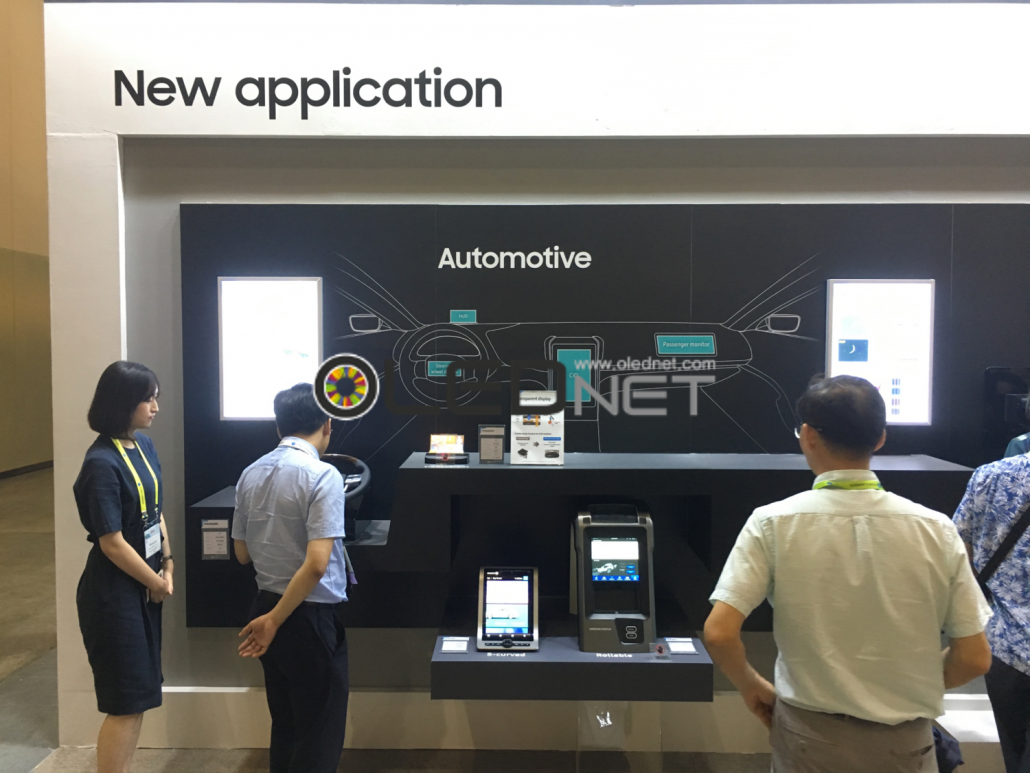
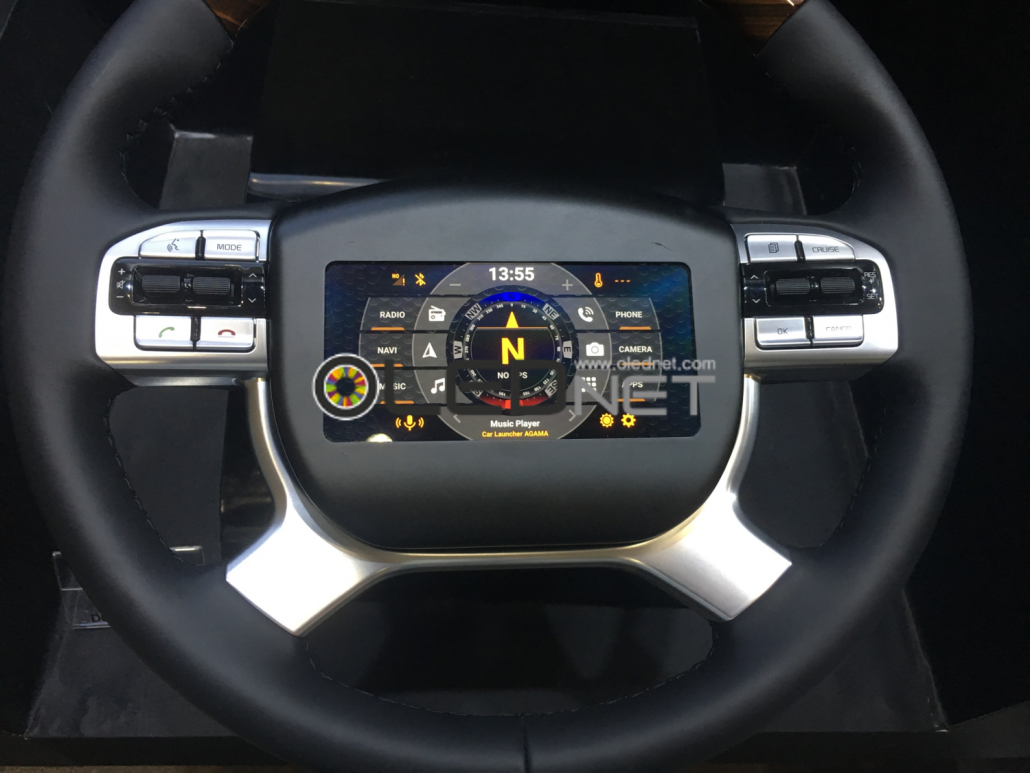
He added “Although there are many things to be improved, such as brightness and reliability, it is continuously improving the required performance through the feedback from European customers”.
Furthermore, Samsung Display showcased light field display and 2,000ppi resolution RGB OLED for virtual reality devices.
LG Display, Showed OLED lighting for unmarried mothers
/in /by Daejeong YOONLG Display delivered 30 OLED lighting units, made by its employee volunteers, and baby products to 30 unmarried mothers.
This volunteer activity was carried out by the talent services of OLED lighting employees. OLED lighting business division donated 30 flexible OLED lighting panels, and the product planning team customized the lightings for breastfeeding for unwed mothers.
On July 27, the employee volunteers assembled light fixtures, which were customized by woodworking parts through social enterprises, and panels as finished products. In addition, various items needed for a baby and cheer letters for the unwed mothers were packed together. The packaged gift sets were delivered to 30 unmarried mothers living at the unmarried mothers’ facilities through the Eastern Social Welfare Society on July 30.
OLED lighting reduces light flickering and blue light, which affect eye health. And its mild light protects you from eye fatigue. It is also regarded as an eco-friendly product because it generates less heat and has no harmful substances. Since it is the organization that best knows the characteristics of OLED lighting, it suggested the service of delivering the OLED lighting for breastfeeding, made by its members, suitable for the baby-care environment.
Kim Yong-Jin, manager of the OLED lighting sales team who participated in the volunteer service, said “I feel it was worthwhile to deliver the OLED lighting directly to the necessary neighbors although I have dealt with it for business. When I see the neighbors who were delighted with little help, I have to think once again that service activity is so much fun.
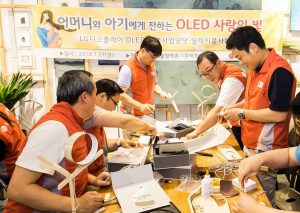
<Source: LG Display>
LG Display “Strategic direction is OLED. Uncompetitive LCD lines are planned to be switched.”
/in Technology, Technology /by OLEDNETIn the 2Q earnings release conference call hosted on the 25th July, Kim Sang-don, LG Display CFO, said, “Looking back at the first half of 2018, the market was in a difficult situation due to the slump in prices, the traditional off-peak season and increased display supply from China. We expected the market conditions to be stabilized in the first half of this year from the bad market condition of the second half of last year, but it has continued to decline more rapidly and steeply. However, with starting the second half of 2018, it has been observing that the price is rising since July owing to upcoming favorable seasonality and customer restocking.”
“Although the market situation has changed favorably in the second half of the year, it is different from the past supply and demand cycle because of the uncertainty of forecasts. Moreover, the oversupply and asymmetric competition in the display market are unavoidable.” LG Display announced that it will maintain its conservative strategy in the second half of the year as the unpredictability is still high.
LG Display’s sales revenue in the second quarter of 2018 was KRW 5,611 billion, decreased by 15% compared to the second quarter of 2017. Operating loss in the second quarter of 2018 recorded KRW 228 billion. This compares with the operating loss of KRW 98 billion in the first quarter of 2018 and the operating profit of KRW 804 billion in the second quarter of 2017. The company suffered a large deficit due to a continued and steep decline in panel prices and lower demand in panels following the previous quarter. Although the shipment was increased by 2% QoQ, the selling price per area (m2) was decreased by 4%.
As a positive indicator, the TV panel price fell sharply, but the overall panel price decline was only 1% due to the competitive position of OLED panels. The market is anticipated to turn into positive situation in the third quarter, compared to the first half of the year, since panel shipments are expected to increase with the orders to restock the inventory.
LG Display, which is currently conducting both LCD and OLED business with small and medium sized panels and large area panels, mentioned clearly about its future strategic direction including the direction for the second half of the year as “concentrating on OLED business and focusing on high value of LCD business” in this conference call.
LG Display announced that it will focus more on differentiated LCD features and technologies in the IT sector such as narrow bezel, IPS borderless, and oxide technology, as well as high-value-added products such as larger-size TV panels and commercial displays, considering that a structural oversupply in panels and fierce competition among display makers are expected to continue down the road.
In addition, LG Display will achieve a turnaround to profit in the OLED TV sector in the third quarter of 2018. By making its final decision to invest in its Gen 10.5 OLED panel production line in Paju, Korea, and by starting mass production in the latter half of 2019 at its Gen 8.5 OLED production line now under construction in Guangzhou, China, LG Display will accelerate the expansion of the global large-size OLED market. Furthermore, additional production facilities for OLED 8.5 generation are known to be considered with the plan that the rationalization of LCDs during the year is also to be implemented although there was no direct mention of the timing and specific lines. For the plastic small and medium-sized OLED panel business, which is experiencing difficult times, compared to large area OLED, for which LG is expanding the production capacity in response to increasing demand, it said that they are preparing for future markets with the necessary strategic technologies with the emphasis of mobile and automotive markets. The E6-1 line, which has been mentioned as a production plant for Apple, is expected to begin mass production in the fourth quarter of this year, revealing the possibility of a possible supply of display to the iPhone OLED model in 2018. In addition, demand for OLED panels is increasing in the automobile market, and it is expected that full-scale business will start in the second half of next year. At the current order backlog, it is confirmed that OLED panels are in the late stage of about 10%. This means that much of the work has already been done. Finally, LG Display is well aware of the lack of funding and funding shortfalls over its competitors in relation to its future preparations. The company plans to reduce its capex by about 3trillion won by 2020, with a substantial portion of depreciation and amortization It is possible through internal working capital management and it plans to borrow the rest. LG Display confirmed that it has not reviewed the rights issue several times in the market, and LG Display has thoroughly prepared a variety of OLED portfolios, revealing its commitment to success by differentiating it from its competitors in the area of latecomers.
In Premium TV market, OLED portion is growing.
/in /by olednetFollowing Bang & Olufsen and SONY, Philips’ OLED TV was launched in Korea on June 11, 2018.
Philips’ OLED TV, applied with LG Display’s OLED panel, is available in two models; 55 – inch and 65 – inch. It features a quad – core CPU, HDR 10, Dolby Vision and DTS surround.

<Philips OLED TV, Source: Philips>
In coming September, Germany’s Loewe plans to launch three (bild5, bild7, bild7 edition) 65-inch OLED TVs using LG Display’s panel, and also Hisense is scheduled to release OLED TV this month.
Especially, when Hisense, which is the leader in the Chinese TV market, releases OLED TVs, it is expected to enhance the awareness about OLED TV in China as well as increase the portion of OLED in the premium TV market.
In April, Kim Sang-don, CFO of LG Display, said in the conference call “The number of existing OLED camps was expanded to 15 from 13, adding two. LG Display will actively respond to increasing market demand by expanding productivity through the reduction of tack time and by converting Chinese fab and, if necessary, domestic LCD fab to OLED fab.”
In the ‘OLED/Display comprehensive seminar’ held by UBI Research, So Hyun-chul, director of Shinhan Financial Investment, said that Sony ranked the first in the premium TV market in 12 years and Sony’s share price rose 445% with its main driving force of OLED TV.
In addition, LG Electronics’ HE division achieved an operating margin of 8.1% last year. In the major set makers, OLED seems to be the Key factor that increases the company’s sales and improves the market share in the premium TV market. As such, OLED portion is anticipated to expand further in the premium TV market.
Meanwhile, UBI Research predicts that OLED TV sales will be increased by about 30% annually and the revenue is projected as about US$ 5.7 billion in 2022 through the ‘2018 OLED Panel Industry Report’, which was published in February.
Market for OLED materials and components is forecast to grow to US$37 billion in 2022.
/in /by olednetIn the 2018 OLED material and component report and Market Track published by UBI Research, the entire market for OLED materials and components market is expected to grow at a CAGR of 29% by 2022, forming a market of US$ 37 billion in 2022.
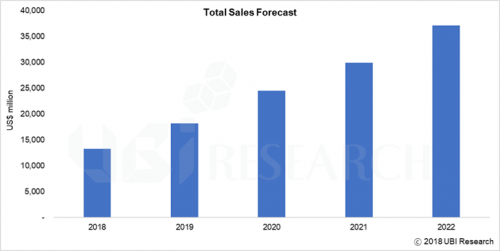
<Market forecast for OLED materials and components>
The overall OLED material and component market forecasted in this report is calculated based on the panel makers’ available capacity and includes all the materials and components for OLED production.
The total OLED material and component market is counted as US$ 9,794 million in 2017 and is expected to grow by 35% to US$ 13,264 million in 2018.
Major growth drivers are mentioned as capacity expansion of Samsung Display and LG Display inclusive of Gen6 flexible OLED mass production lines of Chinese panel makers.
UBI Research commented “Utilization of Samsung Display in the first quarter of 2018 was poor, but it is turning to normal from the second quarter, and LG Display and Chinese panel makers are also aiming to mass-produce this year. In particular, it will have a major impact on the growth of the materials and components market in 2018 whether Samsung Display’s A4, LG Display’s E5, E6 and BOE’s B7 lines will be in full operation.”
In the 2018 OLED material and component report, the market is forecast for 20 kinds of major materials and components used in OLED for mobile devices and large-area OLED, including substrate glass, carrier glass, PI and organic materials for TFT. In addition, the report covers industry trends and key issues related to the core materials, while Market Track forecasts the expected purchase volume and purchase amount by panel makers.
SID2018] Samsung display’s OLED technology, one step closer to full screen
/in /by olednetAt the SID2018 exhibition in Los Angeles, a new concept OLED with no front speakers on the Smartphone was introduced.
Samsung Display’s new “Sound on display” removes the speaker at the top of the smart phone. Instead, it has a piezo electric actuator on the back of the panel that can turn the electrical signal into vibration. This is the mechanism by which the actuator vibrates the OLED panel to produce sound. It is the same method as LG Display’s “Crystal sound OLED”.
When this technology is utilized, the speaker can be removed from the front of the smart phone, resulting in a wider display area. Following the trend that the home button is embedded in the display, OLED will continue to evolve in the direction that the speaker is also embedded in the display.
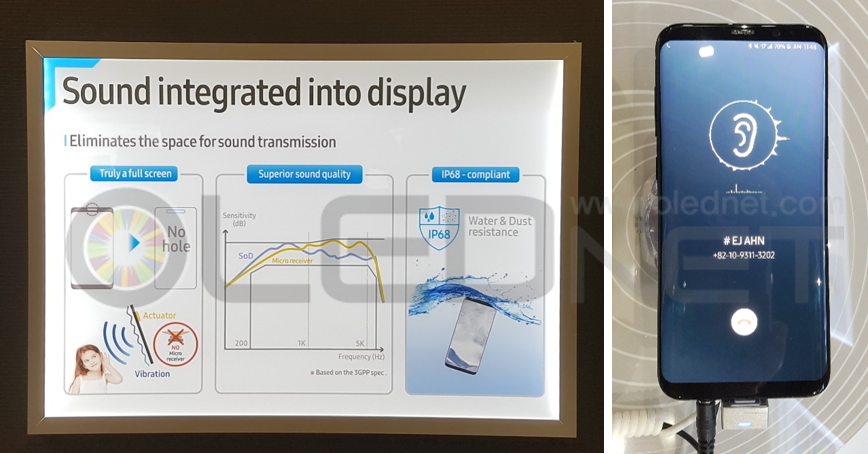
TCL announced “Establishing large-area OLED panel production plant”, is solution processed RGB OLED mass production accelerated?
/in Others, Others /by olednetChina TCL will invest RMB 42.8 billion (US$ 6.71 billion) in Shenzhen to establish a factory for large-area OLED panel production. According to South China Morning Post, TCL recently announced that it will produce 90,000 units on the basis of 70-inch panel in the new production line of Gen 11 (3370 mm x 2940 mm) with the goal of mass production in March 2021 in the data submitted to the Shenzhen Stock Exchange. The main products are to be known as 65-inch and 75-inch OLED panels, and 65-inch, 70-inch and 75-inch display panels with 8K resolution.
TCL will form a partnership with the China Development Fund for the necessary financing and will set up a new production line at TCL’s semiconductor subsidiary with RMB 20.3 billion.
Large-area OLED to be produced by TCL is expected to adopt solution process RGB. At the ‘4th OLED Korea conference’ hosted by UBI Research in March, James Lee, deputy chief engineer of TCL mentioned about the development of next-generation premium TV with the screen size of 70-inch or more and 8K resolution, based on the solution process.
Lee said, “The price difference between OLED TV and premium LCD TV is estimated to be reduced to 1.4 times when the price of large-area OLED panel is lowered by the operation of LG Display’s Gen 10.5 plant in 2020. We are developing solution process technology for large area OLED and it will be applicable to Gen11 factory. ”
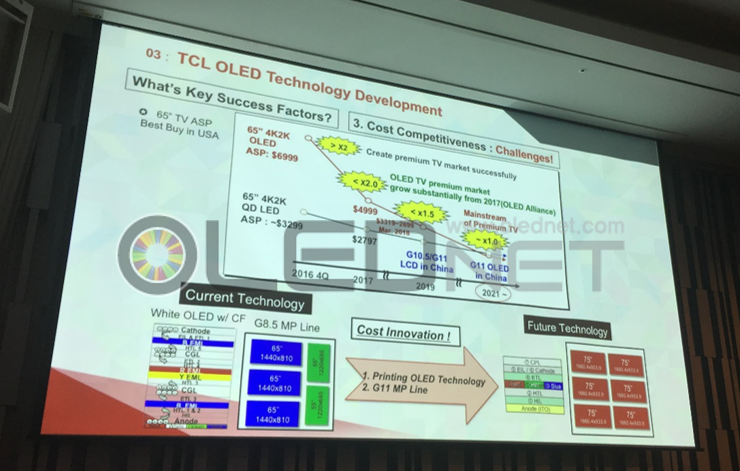
Gen 11 production line is capable of producing six sheets of 75-inch OLED panels, being able to achieve a yield three times higher than Gen 8.5 production line and a cutting efficiency of over 95%. In addition, it is possible to produce large-area OLED panels with a real RGB structure instead of the WRGB structure when solution process is applied. Based on this, TCL emphasized that the construction of the Gen 11 solution process OLED mass production line is essential. Meanwhile, TCL has jointly established JUHUA Printing Display Technology with Tianma, a Chinese company, in 2016 through CSOT, which is a subsidiary of TCL, and is continuously developing the inkjet printing process by a Gen 4.5 R&D pilot plant.
LG Display 88-inch 8K OLED TV was released to the public through CITE held in Shenzhen, China
/in /by olednetCITE, an electronics trade show held in China on April 10, 2018, had a relatively lukewarm atmosphere with significantly fewer visitors than last year. It seems to have been influenced by the lack of special IT issues, compared to last year when it was crowded with the attention of many general visitors.
Especially, there were no new products on the TV appliance side. Most of the exhibitors displayed the same products as those of last year or 2018 CES. On the other hand, LG Display unveiled its 88-inch 8K OLED TV, which had been hiding in its own booth, at the front of the booth. CSOT also showcased OLED displays made with printing technology that had been publicized several times during several conferences. 8K OLED TV is to be the future of the high-end premium TV as it clearly shows the advantages of OLED display such as contrast ratio, sharp image quality and color reproduction through large screen. CSOT’s 31-inch display is meaningful because it exhibited the results of CSOT’s printing OLED technology development. It is preparing for a new investment of about 20K TV line next year. The exhibited product was manufactured by using top emission Ink-jet printing technology to oxide TFT. The peak brightness is 150 nit at 144 ppi.
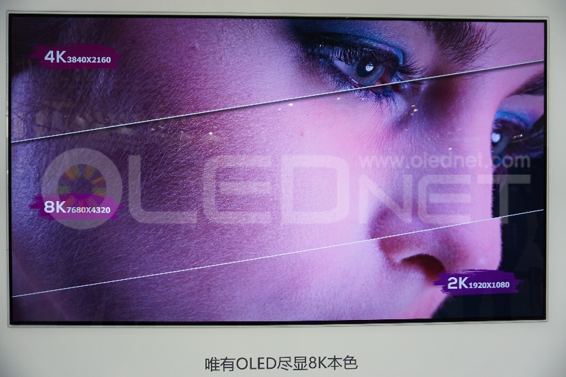
<88 inch 8K OLED TV – LG Display>
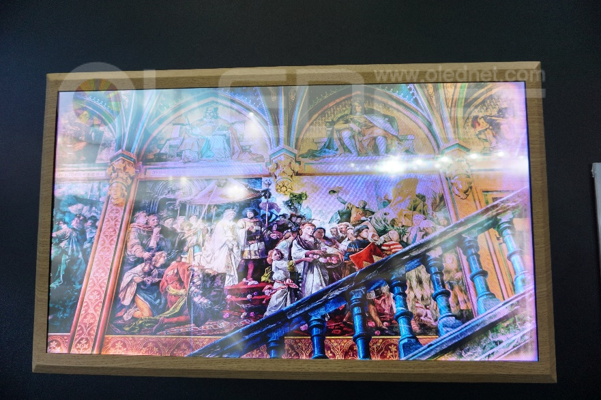
<31inch Ink-jet printed OLED Display – CSOT>
Vivo, which was the first to unveil the smart phone X21 with a built-in fingerprint sensor, displayed only the X21 model at its booth. As a result of the actual registration testings, the fingerprint was recognized several times compared to the existing fingerprint registration, and the test recognition rate was not bad, but the response speed was slightly slower than opening the screen with the home button. In addition, most panel makers exhibited displays similar to the notch design of the iPhone X, which created various issues over the past six months, and set makers such as Vivo and Oppo released similar notch type smart phones. According to one official of some panel maker, the response to the design is not positive, but he said the company made it along with Apple. In his personal opinion, he preferred full screen design. Despite the sluggish performance of iPhone X, it still shows Apple’s strong market influence that the smart phones of the similar designs were released.
BOE, which started the operation of its Chengdu factory in 3Q 2017, exhibited various OLED panels made using plastic substrates. One official of BOE expressed confidence that it is only Samsung Display and BOE that can mass produce flexible OLED panels using plastic substrates across the globe.
LG Display, showing next generation OLED technology at ‘CITE 2018’
/in Exhibition, Exhibition, Exhibition, Exhibition, Exhibition, Exhibition, Exhibition, Exhibition, Exhibition, Exhibition, Exhibition /by olednetLG Display is showing OLEDs applied to various applications in the ‘China Information Technology Expo 2018’ held in Shenzhen, Guangdong, China from April 9 to 11, 2018.
CITE is the largest information/electronic exhibition in Asia hosted by China’s Ministry of Communications and the local government of Shenzhen, held every year recording more than 1,500 exhibitors participating and about 160,000 visitors attending.
Based on the slogan ‘OLED is already in the spotlight’, LG Display is demonstrating not only picture quality, but also the possibilities of OLED products in terms of application range and design.
OLED is widely regarded as the best display in the world in terms of brightness, color accuracy and viewing angle. In particular, large area OLED, has gained popularity in the premium market, which LG Display has developed uniquely and meets various consumer needs with different image quality and new design potential.
LG Display exhibited the world’s first 88-inch 8K OLED, which was unveiled earlier this year, attracting visitors. It is the largest of all existing OLED TV products and delivers four times (7680×4320 resolution) sharper picture quality than UHD (3840×2160 resolution). OLED is a self-luminous display, and is easy to realize high resolution 8K since there is no brightness drop due to the reduction of the aperture ratio. With LG Display’s innovative process/design and compensation technology added, OLEDs are expected to lead the ultra-large/ultra-high-definition market by realizing true 8K.
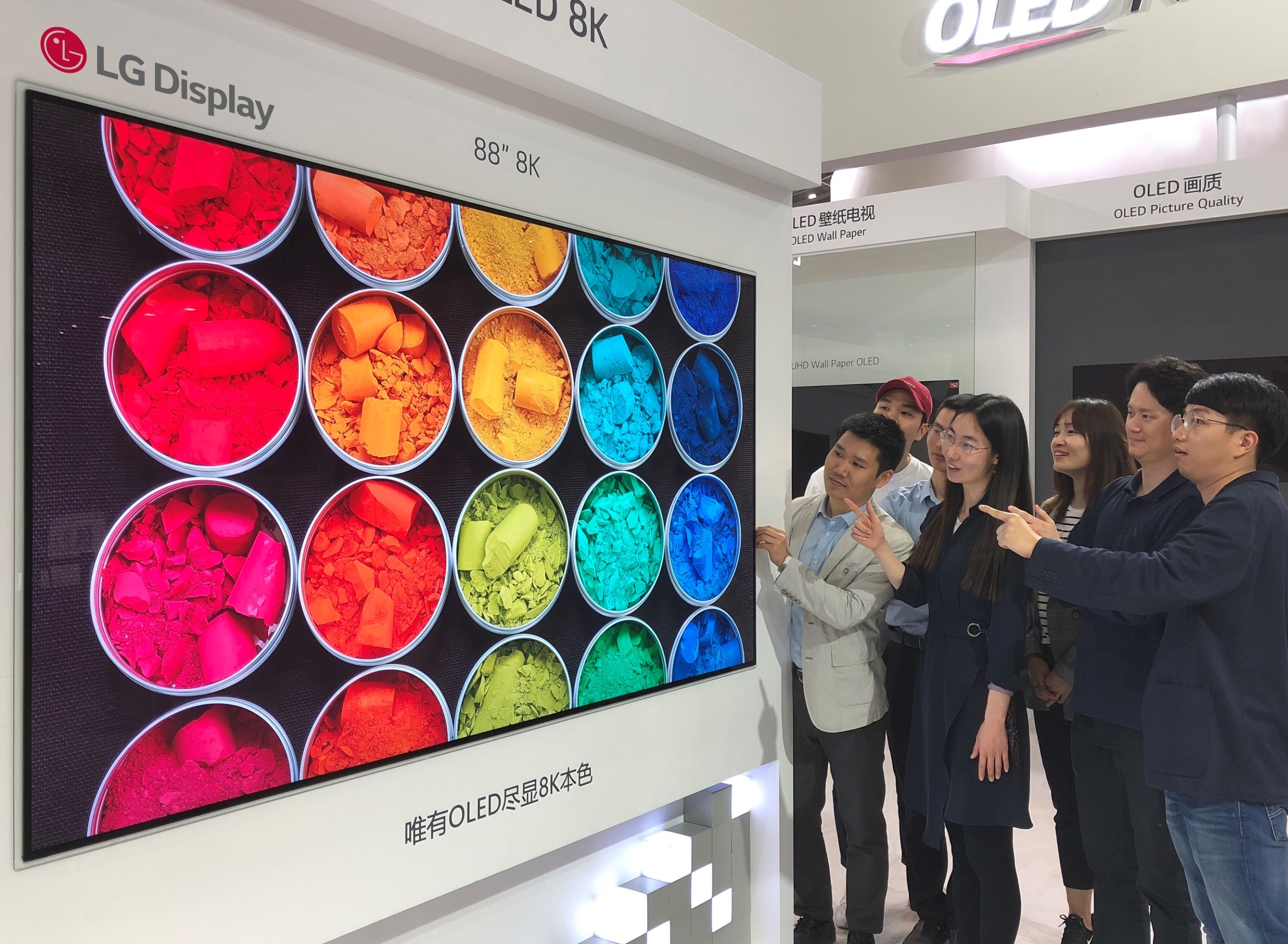
<The first 8K OLED TV in the world, source: LG Display>
LG Display also exhibited the 65-inch CSO (Crystal Sound OLED) with speakers, and won the CITE 2018 Technology Innovation Gold Award for the most innovative products. It is an innovative product that makes the sound system internal to the panel, bringing sound directly from the screen. Instead of listening to the sound coming from separate speakers, it matches the position of the screen and sound, maximizing the sense of presence and immersion.
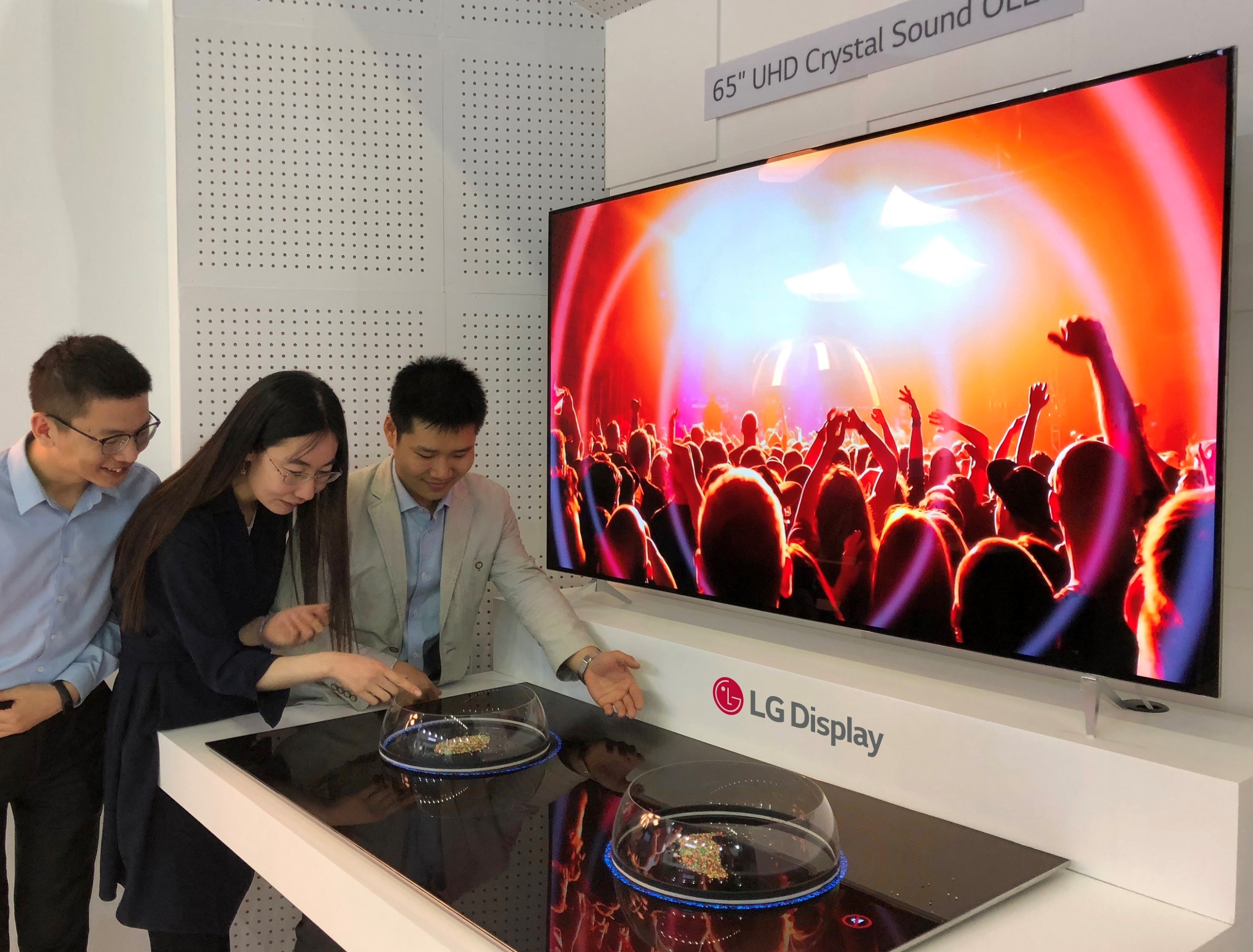
<65 inch CSO (Crystal Sound OLED), source: LG Display>
In addition, it introduces various application possibilities while showcasing a 77-inch UHD wallpapers OLED, which can be closely adhered to the wall to enhance the interior effect of the living room, and a round shaped pillar product consisting of six 77-inch UHD OLEDs.
Meanwhile, LG Display showed OLED lighting in China for the first time in this exhibition. OLED lighting is environmentally friendly because it consumes less power and heat than conventional lightings, and is a premium light source that minimizes eye fatigue by being close to natural light. It is free to implement curved surfaces like OLED displays, and provide consistent light as a unique surface light source. OLED lighting panels are available in various shapes: circular, square, rectangular, and others.
Saying “OLEDs with the potential to expand into a variety of applications will provide differentiated value to consumers,” Yeo Sang-Duk, CMO (chief marketing officer) of LG Display commented “We will continue to lead the OLED market with Chinese customers in the Chinese market where the acceptance of new technologies and new products is the fastest in the world.”
According to the ‘2018 OLED Display Annual Industry Report’ published by UBI Research in February, the OLED market is predicted to grow at an annual average of 22% from US$35.7 billion in 2018 to US$ 78.2 billion in 2022.
Google-LG Display to show OLED for 1443ppi VR device for the first time in the world
/in /by olednetGoogle and LG Display are planned to unveil OLED displays for ultra-high-resolution VR devices with the world’s first 1443 ppi at SID 2018 in Los Angeles in May.
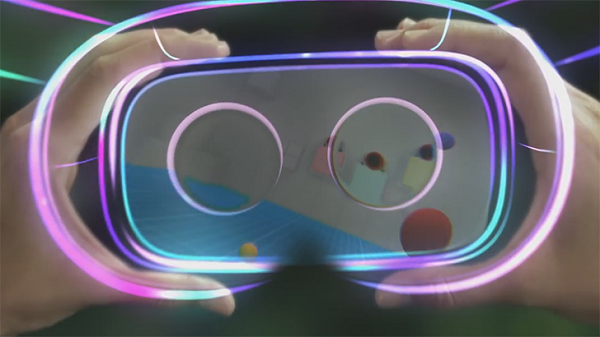
<OLED for VR devices, which Google and LG Display will unveil, Source: Android Police>
According to the Verge, the OLED for VR devices released at SID 2018 has a resolution of 5657 x 3182 (1443 ppi) with 4.3 inches in size.
The resolution is 2.4 times higher than Samsung Electronics’ Odyssey (model no. XQ800ZAA-HC1KR), which is currently known to have the highest resolution of 1400 x 1600 (607ppi), among VR devices supporting HMD. Also, it is about 1.9 times higher than the OLED for VR devices (1824 x 1824, 806 ppi) displayed at iMiD 2017 in August, 2017.
Since the distance between the eyes and the display is very short, a VR device has a ‘side door effect’ phenomenon in which the pixel patterns of the display are shown in a lattice form when the resolution is low. In addition, low resolution increases the fatigue of eyes, and it becomes a factor that deteriorates reality due to inaccurate graphic information (image distortion). Accordingly, the related companies are developing panels for VR devices with high resolution that can compensate them.
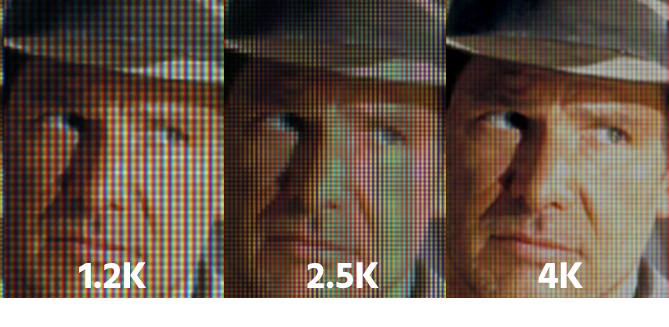
<VR screen comparison according to resolution, Source: speedvr.co.uk>
OLEDs for VR devices to be exhibited by Google and LG Display are the best in the world at the refresh rate (120Hz), too.
Higher refresh rates can display more screen frames within the same time period to minimize the nausea phenomenon and increase immersion by showing more natural images. Accordingly, Oculus VR, HTC, and Korea Information and Communications Technology Association have prescribed the refresh rate of the VR display as 90 Hz or more, and SONY defined as 120 Hz.
According to the ‘Display Market Report for AR and VR’ published by UBI Research in July 2017, the VR devices launched from 2014 to 2016 have a refresh rate of about 65 Hz for LCDs and about 86 Hz for OLEDs. In order to implement a high refresh rate, OLEDs with higher response speeds and lower power consumption than LCDs are more advantageous.
OLED TV continuing to evolve
/in /by olednetAt the ‘4th 2018 OLED Korea Conference’ hosted by UBI research on March 7-8, Dr. Han Chang-Wook, Chief Research Fellow of LG Display, made a presentation for the development process of OLED TVs and emphasized the image quality of OLED, design flexibility and expandability.
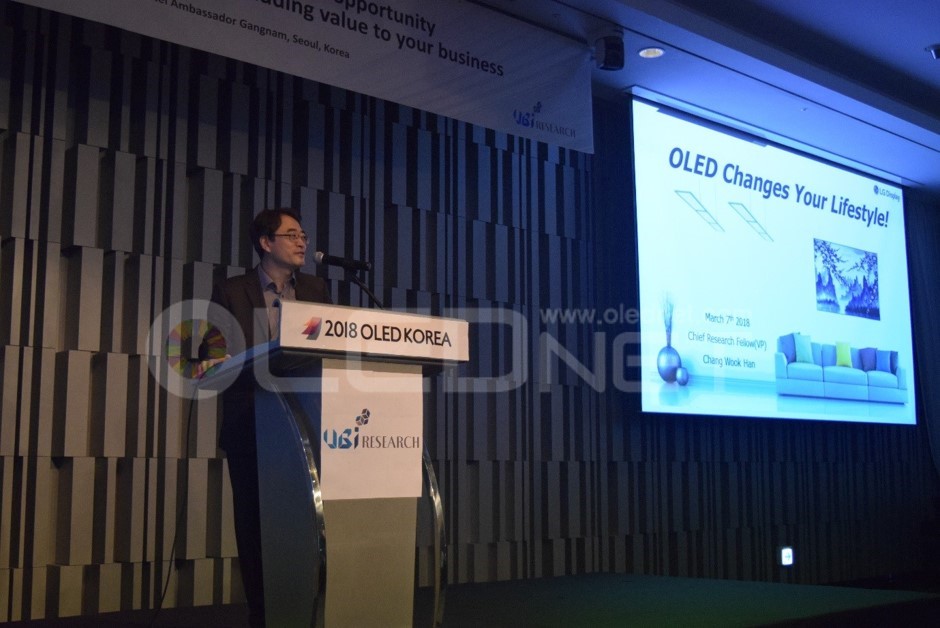
At first, Dr. Han introduced three core technologies including TFT technology, OLED stack technology, and compensation circuit design applied to OLED TVs. He said, “We changed the TFT as top gate coplanar structure for UHD implementation in bottom gate TFT applied to FHD.” He also mentioned “We changed the WRGB OLED pixel structure from 2 stack structure to 3 stack structure to improve the luminance and color reproduction ratio, and designed the compensation circuit so that it does not affect the OLED even on 8K large screen.”
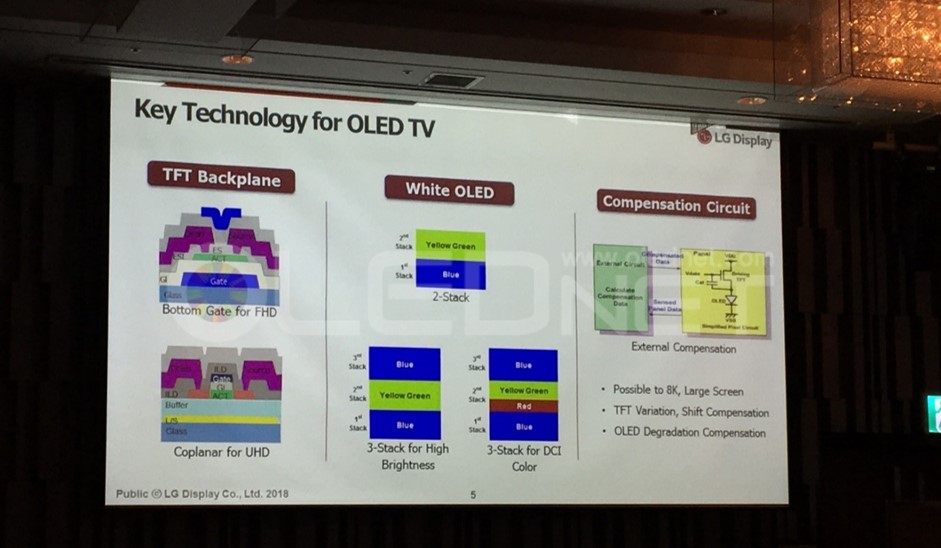
He commented, “Unlike LCDs that control pixels with local dimming, OLEDs have pixel dimming controls, which allows for full black representation and less halo effects”
Explaining that OLED allows greater design flexibility and expandability because of the self-illuminating properties that does not require backlight, he referred to the mirror display and transparent display applicable to indoors, and the world’s first 88 inch 8K OLED TV and 65 inch rollable OLED TV exhibited at CES 2018.

Dr. Han said “We expect large OLED panel production to be tripled, compared to 2016, with the expansion of production lines and yield improvement in 2018. In addition, the company will be able to ship over 6 million large area OLED panels by 2020 through the expansion of its Paju and Guangzhou plants.” He also announced that the company will increase continuously the production for OLED panels, which were 5% of the total display panels in 2016, by 40% by 2020.
AMOLED Display Market track – Investment & MP Line Status, just published
/in /by olednetAccording to the investment trend data from AMOLED Display Market Track published by UBI research, the net area capacity of AMOLED production worldwide is expected to grow at a CAGR of 48% from 2018 to 2020.
As a result of analyzing the glass area based on the overall equipment capacity, the net area capacity of AMOLED mass production was 13 million square meters in 2017, and it is expected to grow more than three times to 40 million square meters in 2020.
The net area capacity of AMOLED mass production area is projected to grow from 4 million square meters in 2017 to 8.4 million square meters in 2020, and that of small and medium-sized AMOLED is to be increased about 3.5 times from 9.1 million square meters in 2017 to 32 million square meters in 2020.
Analysis shows that LG Display’s net area capacity will be increased by 6.9 million square meters from 2018 to 2020, followed by Samsung Display with 5.8 million square meters increase and BOE with 4.4 million square meters increase.
On the other hand, when compared to the net area capacity for small and medium-sized AMOLED, Samsung Display is expected to increase by 5.8 million square meters, with the largest investment, followed by BOE of 4 million square meters’ increase and LG Display of 2.9 million square meters increase.
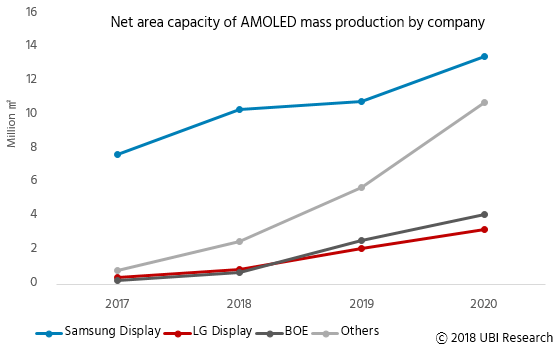
<Net area capacity of AMOLED mass production by company>
According to Lee Choong Hoon, CEO of UBI Research, LG Display’s AMOLED mass production line investment in China will lead LGD to more than double BOE’s AMOLED production capacity in terms of net area capacity in 2020, however, BOE is expected to overtake LG Display at small and medium-sized panel capacity in 2019.
AMOLED Display Market Track consists of investment data, market performance, market forecast, ASP, cost analysis, competitiveness analysis and so on. The investment data in this report contains details of the investment history of the panel companies, current status, and investment prospects for the next three years. Also, the useful data and graphs analyzed in various aspects are provided in excel format.
At the 10th CAR-ELE JAPAN, Many Companies Unveiled Automotive OLED Display and Lighting
/in /by olednetBy Hana Oh (hanaoh@ubiresearch.com)
OLED display and lighting are expected to become increasingly applied to the interior and exterior of automobiles.
At CES 2018, Samsung Electronics introduced the OLED-applied dashboard. LG Electronics unveiled the center fascia with 14-inch OLED, and OLED set makers continue to exhibit their OLED applications for automobiles.
At the 10th CAR-ELE JAPAN held in TOKYO BIG SIGHT(Tokyo International Exhibition Center) on 17th, several companies including Tianma and Truly exhibited automotive OLED displays and lighting.
Tianma exhibited 4.2-inch, 5.46-inch and 5.99-inch OLED panels. The 5.99-inch OLED was a full-screen OLED, and the company official said “The full screen will be applied not only to mobile devices but also to automobiles such as CIDs and navigation systems due to the nature of automotive displays sensitive to visual impacts.” It is said they produced the OLED Panel with high luminance, including 5.46-inch and 4.2-inch OLED with luminance of 650 cd/m2, ensuring good high visibility under sunlight. In addition, they announced that they will manufacture unbreakable flexible type of OLED even though the exhibited OLEDs were all rigid type.
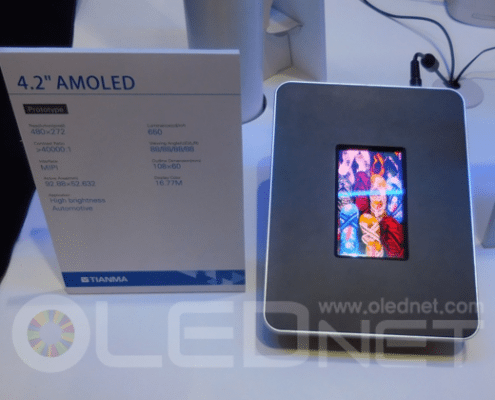
<Tianma’s Automotive OLED Panel>
Truly exhibited 5.5-inch OLED panel. The company’s official mentioned that although they can not disclose detailed specifications, it should be further developed in terms of reliability for the application to the current automotive displays. In addition, they announced that automotive potentials such as autonomous vehicles are so huge that the importance of displays that can provide visual information will become even more important, and therefore they will invest in it.
Lastly, Nippon Electric Glass introduced OLED lighting which was created in collaboration with OLEDWorks. “This was created as interior lights and taillights for vehicles.” and “The OLED lighting substrate uses IEL(internal extraction layer) to improve more efficiency when applied to indoor lights, and better visibility when applied to taillights,” explained the company’s official.”
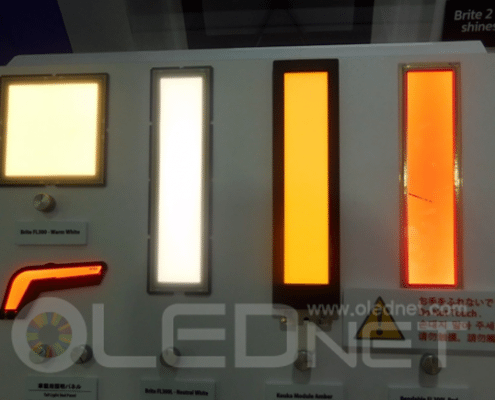
<OLED Lighting exhibited by Nippon Electric Glass>
Meanwhile, in relation to OLED lighting, OLED light source companies such as LG Display and Osram supplied the OLED lights for tail lights to finished car makers such as Mercedes-Benz and BMW. In particular, it is expected to start the OLED lighting market in earnest, for example LG Display’s announcement of full-scale operation of the Gen5 OLED light source production line in December.
LG Display to Showcase Next-Generation OLED Products at CES 2018
/in Exhibition /by olednetLG Display will showcase its distinctive technologies during the ‘Consumer Electronics Show (CES) 2018’ exhibition held in Las Vegas from January 9th to 12th, and aggressively engage in marketing.
In this exhibition, LG Display displays distinctive OLED products in various aspects such as image quality, application range and design for customers to directly experience the value of OLED.
LG Display unveils products that have realized unique and distinctive values of OLED, such as 65 inch UHD rollable display and 55-inch transparent display.
In particular, the 65 inch UHD rollable display proposes the future of display, offering a new look and experience. It is a rollable display with 65 inch ultra-high resolution (UHD, 3,840 x 2,160). When not in use of the display, the screen can be rolled in to be hidden away to increase space utilization, providing a new value that existing displays cannot realize. In addition, it is easy to move and install the screen when it is rolled up and also possible to adjust the screen size and the ratio optimized for the purpose of use- the user can enjoy the desired content anytime and anywhere. LG Display has demonstrated the unlimited potential of OLED to create a new market through introduction of the rollable display.
In addition, LG Display has implemented an 88 inch 8K TV as an OLED display, and Crystal Sound OLED TV also upgraded its audio function from the existing 2.1 channel sound to 3.1 channel sound. LG display will deliver the confidence in OLED to customers, exhibiting products that emphasize the benefits of OLED, including 55 inch transparent displays and 77 inch wallpapers.
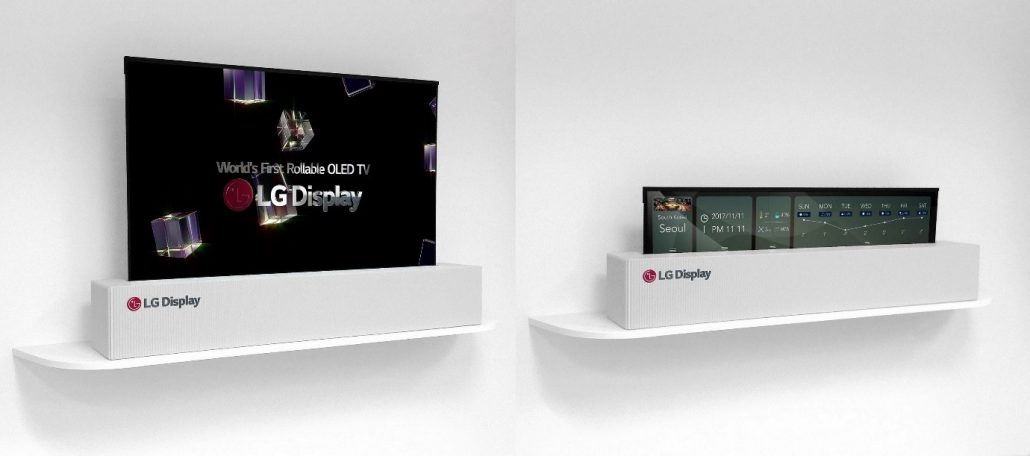
<LG Display’s rollable display, Source: LG Display>
Approval of LG Display Plant in China, cementing the global No.1position in large OLED market
/in /by olednetLG Display has earned approval to invest in Gen 8.5 OLED panel plant in Guangzhou, China. As the government, who has delayed the approval due to the possible technology leakage, finally gives ‘a conditional approval’ for the plan, the construction of large size OLED panel factory will embark on.
The Ministry of Trade, Industry, and Energy (MOTIE) hosted ‘the 17th Industrial Technology protection Committee’ on June 26th, in which government officials and 20 civilian members participated to approve LG Display’s overseas expansion of OLED panel manufacturing technology on the condition of maintaining the localization ratio of equipment and materials to a certain level, preparing local security measures, and investing in next-generation technologies in Korea.
This approval would be a chance for LG Display to further increase the productivity of large size OLED panels and strengthen its market competitiveness. In addition, they can expect sales growth and tariff reduction in Chinese TV market. At the IMID 2018 held in BEXCO in Busan last August, LG Display CTO In-Byeong Kang said, “ Recently OLED TV has overtaken LCD TV market share in North and Central Americas and Europe, but not yet in China. We will increase our market share of OLED TV in China, which is recently being raised as a largest TV market in the world.”

<Market share of global OLED TV market: LG Display>
LG Display plans to strengthen its presence in larger OLEDs by completing both the newly approved Guangzhou Gen OLED line and Paju Gen 10.5 line. According to UBI Research, LG Display’s 55-inch and larger OLED panel shipments are projected to increase from 2.4 million units in 2018 to 10 million units in 2022.
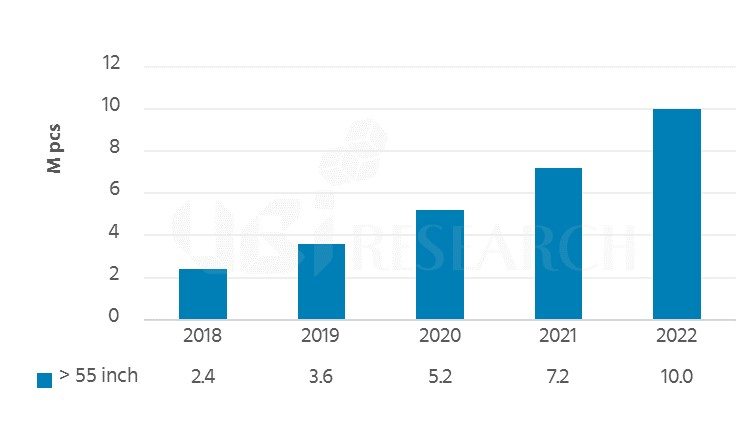
<Expectation of 55-inch and larger OLED panel shipments 55 inch >
OLED lighting, growing their presence
/in Lighting, Lighting /by olednetBy HyunJun JANG (hyunjun@ubiresearch.com)
As the OLED lighting has expanded its applications, the expectation is raised for the beginning of the OLED lighting market. In particular, LG Display has recently completed the OLED lighting production line and started attracting customers. As a result, there is much attention towards the growing OLED lighting market.
LG Display is said to supply its OLED lighting to Baskin Robbins Brown store in Cheongdam Dong and the ‘transparent connection solution’ applied OLED lighting to IOPE store in Myeong Dong. The company explains as the thickness of lighting is as thin as 0.88mm, it enhances aesthetic effect, and does not effect on cosmetics and other displays with less heat generated.
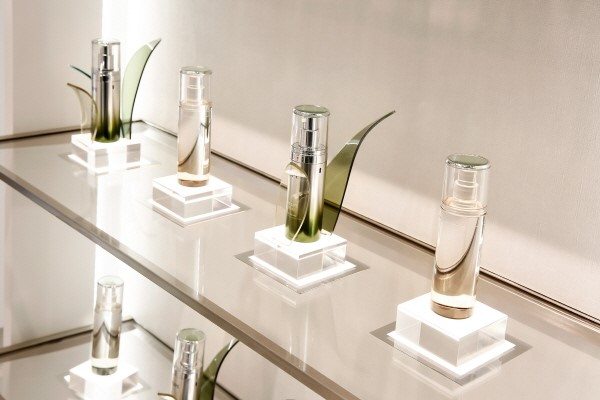
<OLED lighting applied to IOPE store, Source: lgoledlight.com>
Until recently, compared to OLED display for mobile devices and TVs, OLED lighting has shown slow growth. However, OLED lighting is thinner, lighter, and more flexible so that it is now being consideres as a next generation lighting. By tapping on the strengths, it has applied not only to indoor lighting but to cars, exhibitions, and many other industries.
More recently, IKEA announced to release a new lighting product of Vitsand with 7 OLED panels while Mercedez-Benz decided to apply OLED lighting for taillights of both 2018 Benz S class Coupe and Cabriolet.
According to the 2017 OLED Lighting Annual Report published by UBI Research, the global OLED lighting panel market is expected to grow rapidly from 2020, becoming $1.9 billion worth of market by 2021.
OLED TVs which are driving forces of both LG Electronics and Sony′ performance
/in /by olednet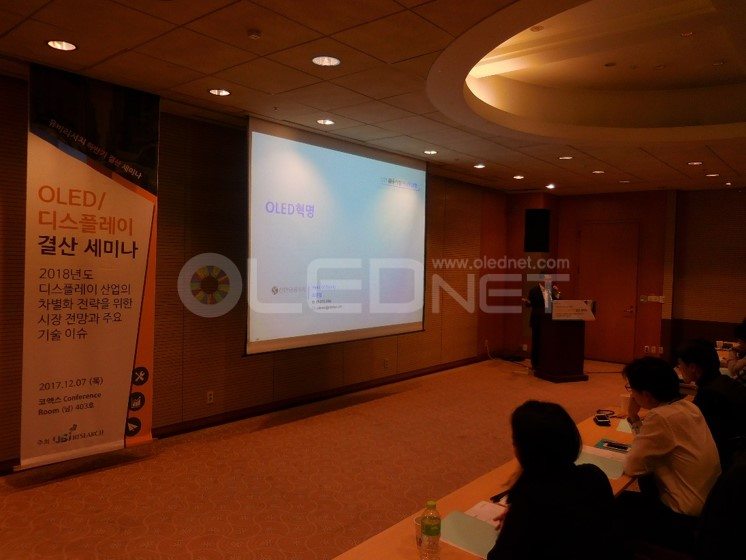
The director, So, Hyun-cheol, mentioned during the ′Closing seminar of OLED/Display′ held at COEX in Seoul on December, 7th about that OLED TV has made 9.9% of operating profits for LG Electronics in Q3, 2017. He forecasted there, Sony and LG Electronics who are producing OLED TV now will lead the premium TV market in the future also, in particular, while explaining about that the demands have highly increased as OLED TV entered into under $3,000.
The director, especially, explained that Sony took No.1 player in the premium TV market in 12 years, moreover, one of the driving forces for stock price rise of them at 445% in 2013 was OLED TV. He evaluated them such followings that “Sony has starting to improve the structure of operating profit by focusing on 55-inch and 65-inch TV, and “They built the TV business structure in stable through launching OLED TV in 2017”.
He also expected that the investment for 10th generation OLED producing line of LG Electronics will be moved sooner than expected. He also forecasted that demands on large-sized OLED TVs will rise due to the Winter Olympic Games in Pyeong-chang and World Cup in Russia next year, especially, its investment of OLED line will be accelerated, because Sony would also want it.
Subsequently, while the director mentioned that the cost savings will be accelerated by improvement of yield of OLED TV panel, he said, “Although, 55-inch LCD panel is difficult to improve the production cost more since it is already reached to enough yield as 232$, but, the price competitiveness in the 55-inch OLED production cost will be intensified more, because, there is still able to reduce it from current 545$ up to 378$ by the yield improvement”.
Lastly, Mr. So, expected that the sales volume of OLED TV panel will reach to 2.9 million units in 2018 by operating E4-2 line of LG Display in full. The panel business will be turned into profit-making, and operating profits of OLED TV business shall meet 17.3% in 2019.
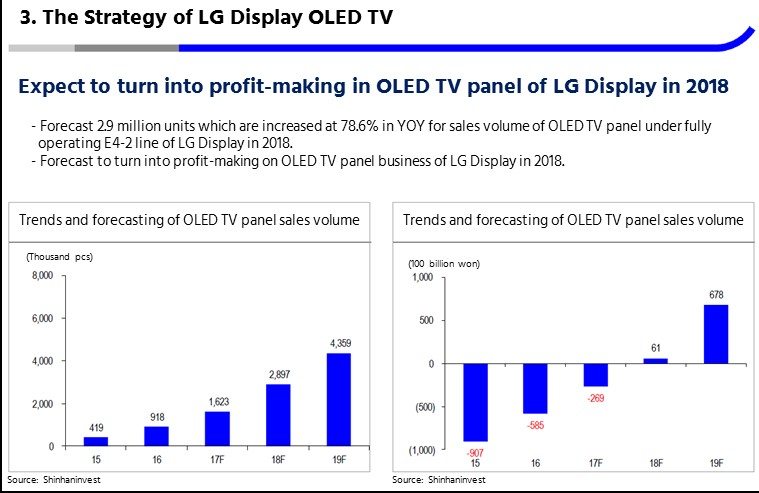
The strategy of LG Display’s OLED TV, Source: Shinhaninvest
IT Industry in China is still hot, OLED is center on that
/in /by olednetNews about when, where, what size of new investments emerge from Samsung display who leads Recent Small and Medium-sized OLED Market and LG display who leads large OLED market should come true are continuously main news in Display industry. In the middle, Maybe, publics who are invovled in industry, are interested in watching when will China’s panel companies who are processing on construction of flexible OLED line supported by government between Korea narrows the technology gaps.
The Hi-Tech Fair, which celebrates its 19th anniversary this year, is a representative event showing how much China is interested in the IT industry.
Hi-Tech Fair held in Shenzhen, China from November 16th to 19th exhibits almost all fields relevant to IT industry. Communication with Display is a key point to increase importance of IT industry and these two field is developing by complex connecting with another field.
Exhibition include total 9 hall and the newest technology such as Smart cities, robots, aviation, telecommunications, home appliances, games, and other technologies that connect with IT can be seen in that area. Among them, one that stick out in 1 Hall is Visionox which is large panel company in China, many people are gather together to watch China’s Display Panel technology.
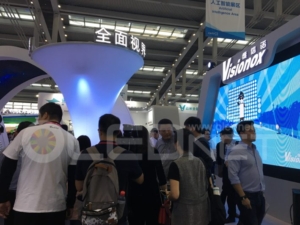
Current smart phone display’s trends are a bezel-less design that maximizes the screen by minimizing the bezel and a curved design represented by the Galaxy Edge series. In this exhibition, Visionox showed a the bezel-less design smartphone which applied rigid OLED and a curved design smartphone which applied flexible OLED having 8R bending radius.
According to officials, disclosed curved display is going to apply to smartphone which will launched in market earlier in 2018. So, this process is currently making decision about supplying with china’s smartphone company. In addition, a variety of flexible displays being developed for future foldable and rollable applications have been on display.
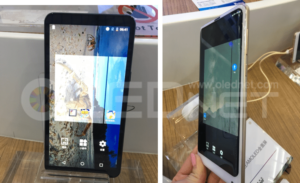
On the other side in Hall, Royole, who manufactures and sells VR devices for China’s leading OLED applications, exhibited flexible sensors with VR device “Noon” Also, they did not exhibit their technology, they disclose a very thin flexible display of 0.01mm through wathcing a video and keep delivering message about continous Display technology development. Also, we can see the various forms and functions of display panel is applied to electrical instruments such as car, robot in many booths. Among them, OLED is expected to continue to grow in significance of IT industry in the future due to its wide range of applications and its technical strengths such as design excellence, thin panel and high resolution.
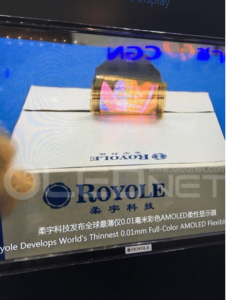
LG Display wins OLED TV Premium Market
/in /by olednet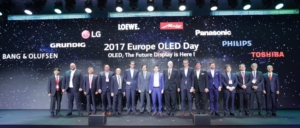
LG Display’s OLED TV panel sales in October more than doubled thanks to surging sales of major global TV customers such as LG Electronics, Sony and Philips.
LG Display’s OLED TV panel sales exceeded 200,000 units for the first time in October, followed by sales plan of exceeding 210,000 units in November.
With the help of Sony’s OLED TV which released LG Display’s OLED TV for the first time this year, it has achieved an overwhelming market share of 74% both in units and sales in the 55” and 65” TV market and OLED TV Set.
(September NPD North American aggregate basis)
In North America, Sony’s sales volume in September increased by 2.1 times compared to the previous month, and in Europe, Philips in its third quarter increased by 5.9 times compared to the previous quarter, and sales of LG Electronics, family of OLED TV, together with North America and Europe, experienced an increase of OLED TV sales in September with a surge of 1.5 times compared to the previous month.
(September NPD North America, GFK Europe / CIS 14 countries)
Particularly last end of July, it had only been 3 months since LG Display announced the move to invest in OLED to lead the future display market when TV sales are rapidly growing, with OLED becoming the trend of the Premium TV market.
This trend is due to the surge in consumer demand after 13 global TV companies introduced OLED TVs in front of the premium TV lineup at the IFA exhibition last September, and the demand for LG Display have increased not only for until the end of the year but even until next year.
Accordingly, LG Display’s OLED TV sales are expected to leap over 1.7 million units this year, exceeding market expectations of 1.5 million units, and 2.7 million units are expected to be sold next year.
LG Display plans to raise utilization of the E4-2 line to the maximum in Paju, which started operation in this second half of the year.
LG Display Vice Chairman Han Sang-Bum states, “OLEDs are rapidly emerging as a premium TV market and are growing steadily in accordance to our production capacity.”
Meanwhile, LG Display has actively promoted the trend of OLEDs in the display market and has recently opened ‘OLED Day’ events in China and Europe. In addition, OLED Experience Center has been installed in 8 major cities in China to show OLED potential and future technologies to consumers.
OLED TV with different characteristics and advantages by set makers
/in /by olednetLG Electronics announced on last 11th that LG OLED TV is speeding up the popularization with the monthly sales volume of 10,000 units and above for the first time in Korea. In addition, Sony, which joins the OLED TV camp in 2017, is enjoying great popularity and continues to expand its market share in the premium TV market. As such, OLED TV is leading the premium TV market by improving cost competitiveness through cost reduction as well as excellent image quality.
OLED TVs are currently being mass-produced by LG Electronics, Sony, Toshiba and Panasonic. Although all set makers that produce OLED TVs use OLED of LG Display, they are producing OLED TVs with different characteristics and advantages.
First, LG Electronics mentioned OLED’s vivid image quality and wall paper design as advantages of OLED W7 which is a signature TV. LG Electronics mentioned that OLED, which is a self-luminous element, can express near-infinite contrast ratio and rich color close to nature, and supports Dolby vision HDR and HDR10 to experience vivid image quality. Also, introduced that a 4.6mm of thin panel provided the experience of seeing the theater screen and all parts except the panel were housed in a space called innovation stage and completed the perfect wall paper design.
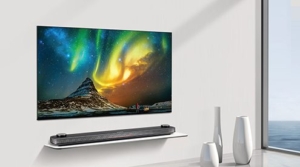
<OLED TV W7 of LG Electronics, Source: LG Electronics>
Sony emphasizes sound, image quality and simple design as the advantage of 4K BRAVIA OLED TV A1E series. It mentioned that the TV screen, which attracted great attention in last year’s CES 2017, can provide an enhanced immersive feeling by applying the ‘Acoustic Surface’ that the TV screen vibrates and makes sound by itself. In addition, the ‘X1 extreme processor’ HDR chip has been applied to improve the picture quality of OLED TV, and the cable is housed in the stand on the backside so that the simple design is realized.
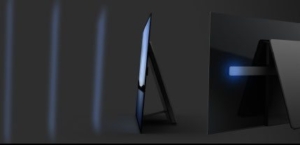
<Acoustic Surface of Sony 4K BRAVIA OLED TV A1E, Source: Sony>
Toshiba then mentioned a high color gamut of 100% DCI-P3 and a high brightness of over 800 nits as the advantages of the REGZA X910. It said that it increased the color reproduction rate to express natural colors and improved the brightness to express the bright and dark parts in richer gradations and strengthened HDR restoration function to realize sharp and realistic high-definition video.
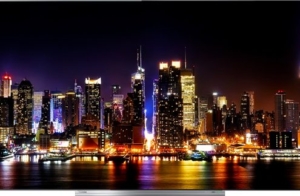
<REGZA X910 of Toshiba, Source: Toshiba>
Lastly, Panasonic stated that it implemented full black and rich color expressions. Especially, it emphasized that it applied ‘Hexa chroma drive plus’ which is Panasonic’s high-definition technology to express high contrast and colors hidden in dark areas that were difficult to implement in LCD TV and reproduced the emotion that the video producer intended.

<Comparison of ‘Hexa chroma drive plus’ technology application of Panasonic, Source: Panasonic>
As such, OLED TV set makers are introducing different OLED TVs that emphasize their characteristics and advantages. In addition to the above four makers, LOEWE of Germany and B & O of Denmark are expected to continue to launch OLED TVs, including mass production of OLED TVs or preparations for mass production. Based on the unique technology of set makers, it is worth noting that OLED TVs with what kind of characteristics and advantages will be produced.
Cynora, TADF will contribute to high-resolution implementation of OLED devices and panel cost reduction
/in Market, Market, Market, Market, Market, Market, Market, Market, Market, Market, Market, Market, Market, Market, Market, Market, Market, Market, Market /by olednetAt the Global Materials Tech Fair 2017 held on September 22 in COEX, CEO Ko Chang-hoon of EM Index, Cynora’s Korean partner, announced the development of the thermally activated delayed fluorescence, blue TADF, which is currently under development at Cynora.
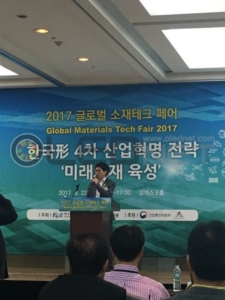
<CEO Ko Chang-hoon of EM Index>
Generally, the blue light emitting material is insufficient in life and efficiency compared to red and green. For this reason, OLED panels for mobile devices are manufactured relatively large in blue pixel size compared to other pixels, in the OLED panel for TV, blue light emitting layers are laminated twice. The blue TADF is the material that is being developed to overcome the limitations of this blue light emitting material.
CEO Ko Chang-hoon mentioned “Applying blue TADF increases lifetime and efficiency, so it does not need to increase pixel size and it is advantageous for high resolution implementation” and emphasized “In mobile devices, it will be advantageous to reduce power consumption as well as realize high resolution and in case of TV, it will be advantageous to reduce the panel cost because only one layer of blue light emitting layer needs to be formed.”
He referred to the recent investments of € 25 million from Samsung Venture Investment and LG Display and explained that it was a proof that blue TADF is attracting a lot of attention.
It is also close to the efficiency, lifetime and color purity of the blue TADF required by major OLED panel makers and is expected to meet these requirements by the end of 2017.
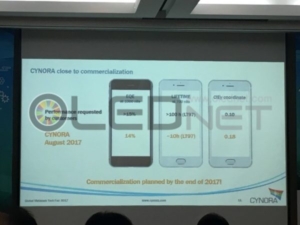
<Cynora’s blue TADF development progress>
Finally, the company announced the development roadmap for the green TADF by the end of 2018 and the red TADF by the end of 2019, and concluded by emphasizing that TADF would contribute to high-resolution implementation of OLED products and panel cost reduction.
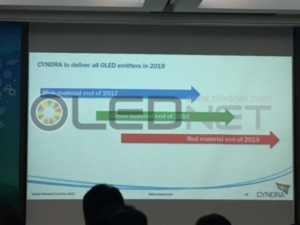
<Cynora’s TADF product development roadmap>
UBI research publishes 2017 OLED lighting report : LG Display, ready to mass-produce OLED light panel, expecting OLED lighting market to grow fast
/in Lighting /by olednetLG Display starts mass production of 5G OLED panel for lighting from the end of September
■ OLED lighting panel market is projected to grow from US$ 1.9billion in 2021 to US$ 5.8billion by 2025
LG Display will start mass production of 5G OLED light panels from the end of September, therefore attention is focused on whether the OLED lighting market is growing rapidly. According to LG Display, monthly production capacity is 15K, and it is to be increased to 90K later.
According to the ‘2017 OLED Lighting Annual Report’ published by UBI Research on August 8, the global OLED lighting panel market is expected to grow to about US$ 1.9 billion by 2021. Furthermore, it is projected to have a CAGR of 85% for the period 2017-2025, and form a market of US$ 5.8 billion in 2025.
Because OLED lighting is thin, light and flexible, it does not limit the installation space and has excellent design autonomy. In addition, OLED lighting is used for automotive, exhibition, and medical as well as general indoor lighting because it can create a comfortable atmosphere with little heat and flicker.
However, the market for OLED lighting has been slower than that of OLED display, which is widely applied to mobile devices and TVs. Osram focuses primarily on automotive OLED lighting, and Philips sold its OLED lighting division to OLEDWorks. Also, Japanese panel makers such as Sumitomo Chemical and Konica Minolta have developed OLED lighting for industrial and medical applications. Nevertheless, it seems to take time for OLED lighting to become eventually a large market.
With LG Display’s mass production of Gen5 OLED line, the price of OLED light panel is estimated to drop below US $ 10 (100 x 100 mm). The significant price competiveness might enable OLED panels to be applied to various areas such as automobile and display lighting as well as indoor lighting. Owing to this expectation, attention is focused on whether the OLED lighting market, showing signs of slow growth, can be materialized.
UBI Research predicted that LG Display would account for about 70% of the world’s lighting OLED panel market in 2017, and will continue to lead the OLED lighting panel market with a 50% market share in 2020.
Meanwhile, ‘2017 OLED Lighting Annual Report’ describes trends of next-generation lighting market, promising applications, cost analysis upon the investment of LG Display and forecast of OLED lighting market. Since it analyses particularly OLED lighting market, materials market, and equipment market forecasts for OLED lighting from various perspectives, it is expected to help the related companies identify the OLED lighting market.
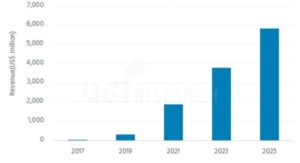
<Sales forecast for total OLED lighting panels>
LG DISPLAY, Will lead global TV market with OLED
/in Set /by olednetLG Display invited about 200 people of Chinese set makers, distributors and related experts and had ‘OLED Partner’s Day’ to share the status of premium TV market and OLED TV business development at Renaissance Capital Hotel in Beijing, China on September 12.
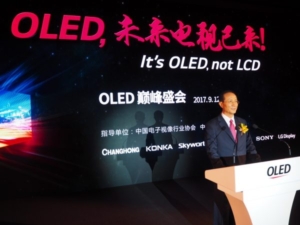
<Source : LG Display>
In the expert forum on the day, key executives from distribution and set makers such as LG Electronics, Sony, Philips, Skyworth, Suning and related organizations such as electronic committee and awards association participated and agreed that OLED will lead the TV market in the future. Forum participants, Liu Tangz(刘棠枝), CEO of Skyworth, said “The Chinese TV industry is currently in a state of saturation, but OLED TV, which can offer new value, will be a breakthrough in the display industry,” and commented “OLED TV will help increase brand awareness and market share.”
Yeo Sang-Deog, LG Display CMO, said, “OLED TV has already become the market trend” and emphasized “We will lead the market with OLED TV, a true future display that can deliver value beyond TV.”
Since LG Display began mass production of OLED TV panels in 2013, it has expanded its customer base to 13 major companies in Europe, Japan and China, starting with LG Electronics. World TV set makers such as LG Electronics, Skyworth, Concha, Philips and Panasonic have set OLED TV products on the front at the IFA (International Consumer Electronics Show) 2017 in Berlin in early September.
OLED TV’s market competitiveness is getting higher as major set makers in the world recognized the value of OLED TV, which has various advantages such as image quality, thickness, design, viewing angle and power consumption and aggressively launch products.
Yeo Sang-Deog CMO emphasized the confidence in quality, he added, “In addition to securing stable yields, we will increase the output to 1.7 ~ 1.8 million units in 2017 and 2.5 million units in 2018.” and explained that they finished all the preparations that OLED TV can influence in terms of production.
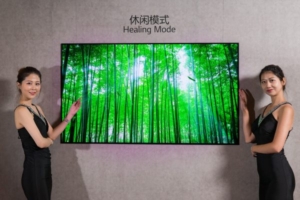
<Source : LG Display>
OLED TV has been rated as one of the best products by the world’s leading professional rating agencies such as ‘Consumer Report’, a nonprofit consumer organization in the US.
OLED TV can be used for interior decoration that displays pictures and photos even when not watching TV, and easy to apply on various AI platforms so that there is no limit to the range of applications. LG Display expects OLED TVs with infinite scalability to change the lifestyle of consumers.
“OLED is a true future display that can deliver new value to the TV market,” said Yeo Sang-Deog CMO and “LG Display plans to carry out a variety of promotional activities to enable more consumers to know and experience the value of OLED.”
LG Display plans to build an OLED landmark in Guangzhou Tower while operating an OLED experience center in the core city of China.
Meanwhile, Vincent Teoh, editor-in-chief and image quality expert at HDTV Test, explained that the TV picture quality test conducted recently proved the overwhelming superiority of OLED TV in all aspects such as contrast and color accuracy, famous Chinese photographer Tungmeong (童梦) shared the experience of use from the user perspective that OLED is the best display to realize the natural color.
On the he other side of the event hall, there prepared the experience zone that can compare structure and image quality of OLED, gallery that can be observed high-end products such as CSO and wallpapers TV and products released by customers allowing attendees to directly experience the benefits of OLED TV.
[iMiD 2017] LG Display, Spur Development of 77 inch transparent flexible OLED
/in Technology /by olednetLG Display’s Kwon Se-Yeol senior researcher introduced the 77-inch transparent flexible OLED which had been introduced in June at IMID 2017 held in BEXCO, Busan on Aug. 30, and announced the applied technologies to realize this.
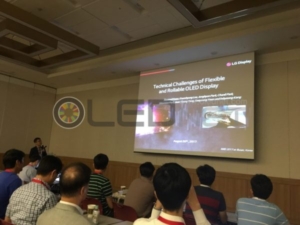
Kwon Se-Yeol senior researcher mentioned, “OLED is self-luminous, so it can be manufactured with a thin thickness because it does not need a back light unit. The thinner the thickness, the more flexible the OLED can be so that it is easy to implement flexible displays with OLEDs.” and forecasted. “It can be used in various fields such as signage and smart desk.”
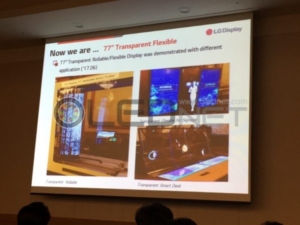
The 77-inch transparent flexible OLED which is released this time is a top emission type for improved luminance. The transparent thin film encapsulation layer is applied, different from the conventional OLED TV or large flexible OLED, and two polyimide substrates are used.
Kwon Se-Yeol senior researcher said “We applied a transparent thin-film encapsulation layer instead of the existing metal encapsulation layer for the top emission method ” and explained “A white OLED light emitting layer and a color filter layer were formed on two polyimide substrates and cemented together. A barrier film and a multi-barrier were applied to the top and bottom of the polyimide substrates to prevent moisture and oxygen penetration.”
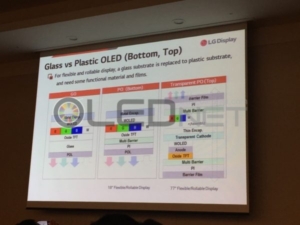
The Kwon Se-Yeol senior researcher then states that “flexural rigidity of the panel is mainly affected by the thickness of the polarizer and the encapsulant layer, so it is necessary to reduce the thickness in order to improve the flexibility”, and emphasized “By reducing the thickness of the encapsulant layer from 100 μm to 20 μm, we can reduce the strain on the OLED module from 0.36% to 0.21%, along with improved flexibility”.
In addition, he mentioned that surface reflection due to polyimide birefringence phenomenon, laser wavelength selection according to polyimide properties in LLO (laser lift off) process, and use of flexible OLED module are all covered, and technical development is continuing.
Meanwhile, LG Display has developed the world’s first 77-inch transparent flexible OLED with UHD (3840 × 2160) resolution, transmittance of 40%, and radius of curvature of 80R as part of the national project.
[iMiD 2017] You Dream, We OLED
/in /by olednet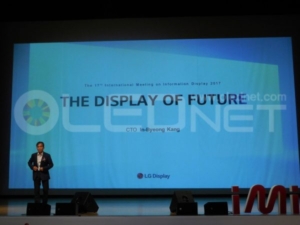
LG Display is expanding in earnest in OLED market.
In the keynote session of IMID 2017 held in Busan on 29th, LG Display’s CTO Kang In-byeong pointed out the future plan of LG Display as “OLED is a strong candidate to lead the future display industry”.
Kang In-byeong, CTO, said that by 2020, large-area OLED will increase its production capacity by 7 times to 2020, thereby reducing the cost cap with LCD and leading the market on the basis of technology such as wall paper, sound integration, rollable and transparent flexible. LG Display recently invested in Gen8.5 in China and is expected to invest in Gen10.5 OLED mass production line at Paju P10 plant.
On the other hand, for small and medium-sized OLEDs, they have announced that they will use a fast follower strategy based on plastic OLED. LG Display is in mass production of plastic OLED panel to be applied for LG Display’s next smartphone, V30, next smartphone, and is ready for the mass production in the E5 line of Gumi. In addition, they plan to invest 10trn won additionally to Gen6 line, which is expected to increase 13 times the current capacity by 2020.
Based on this aggressive OLED investment, LG Display plans to raise its portion of OLED sales up to 40% in 2020 from current 5% in large-area OLEDs and small- and medium-sized OLEDs.
Currently, large-area OLEDs continue to increase capacity and yield and LG Display is likely to expand sales in the future, as it is dominating the premium TV market as it is expanding the camps of Sony, Philips and Panasonic as well as LG Electronics. The success of mass production in small- and mid-sized OLEDs will determine whether or not LG Display plans to achieve its plan.
iMiD 2017 Industrial Forum, a networking event to predict the next generation OLED market
/in /by olednet■ “Finding a new OLED market” – Discussing OLED replacement in view of OLED application development
■ Discussing new technologies of future display (LCD, QD-LCD, OLED)

The potential of future OLED development is inexhaustible as OLED can be applicable to all industries including VR / AR, automotive, aerospace, and lighting not content with smart phone and TVs. There has been growing public interest in OLED in many different industries. To meet the market demand, Ubi Research, a market research company co-hosts ‘iMiD2017 Industrial Forum’ with Korea Display Society (KIDS) in BEXCO, Busan on 30th of August.
The forum will proceed with a panel discussion among key specialists and presentation, which will enable people from many different industries to exchange information not only on the display market but also current OLED market status, technology and explore a new market potential generated in the future.
In the first session ‘look for a new OLED market’, OLED replacement will be presented in view of OLED application development. The key players include Dr. Teruo Tohma, WooSeok Jeong, principal research fellow at the Electronics and Telecommunications Research Institute (ETRI), Julian K chang, Managing director of Boeing Corporation, Professor TAKUYA KOMODA at Yamagata University, senior researcher, Michi Hisaishi, ALPINE Michihisa Onishi.
The second session, ‘Discussion of New Technologies in Future Display’ will provide insight into the latest products and technology trend of TV manufacturers competing with one another to dominate the next generation display market. Nam-Suk Oh, CEO of Samsung Electronics will present an updated LCD TV using Quantum dots technology under the title of “Quantum Dot and Advance of LCD-TV”.
In the OLED TV camp, under the title of “OLED, Now and Future”, Joon-Young Yang at LG Display will review the current status of OLED TV led by the current market trends, and also address OLED future implemented in a wide range of ‘flexible and rollable’ designs.
Weir Cao, senior researcher at TCL, will present both the technology status of the Colloidal Quantum Dots and TCL products applied to LCD in the market, under the topic of “TCL Display Technology with QDs”. The premium TV strategies are expectedly revealed. Lee Choong-hoon, CEO of Ubi research co-host of this forum, offered a time to summarize the premium TV market on the topic of ‘OLED TV market outlook by premium TV market expansion’ by analyzing the presentations of the companies that presented earlier.
For more information on the 17th iMiD2017 Industrial Forum, please visit iMiD2017 official website (http://imid.or.kr/2017/indi_forum.asp).
Stretchable OLED commercialization is on the rise
/in /by olednetSamsung Electronics and LG Electronics have steadily been releasing smartphones and smart watches using flexible OLED since 2013, and electronics companies in China have begun to put out one of them. In particular, Apple, the leader in the smartphone industry, is also seeing the launch of iPhone with flexible OLED, and the flexible OLED market is expected to grow further.
The shape of the flexible OLED was expected to be changed to foldable and rollable beyond the bendable. Recently, however, the display industry has surpassed this trend and has been focusing on the development of stretchable OLEDs.
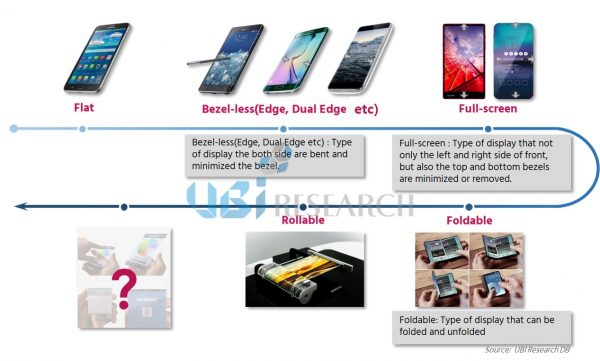
<Development Roadmap of OLED, Source: Ubi Research>
A stretchable OLED is a type of a flexible OLED that is finally evolves, which means OLED having elasticity as like rubber band.
Samsung Display unveiled this stretchable OLED at SID 2017. Samsung Display’s stretchable OLED is 9.1 inch and implementable both convex and concave shapes. At the time, Samsung Display announced that it realized the world’s first technology to maintain the existing image quality while increasing the screen size to 12 mm in concave mode.
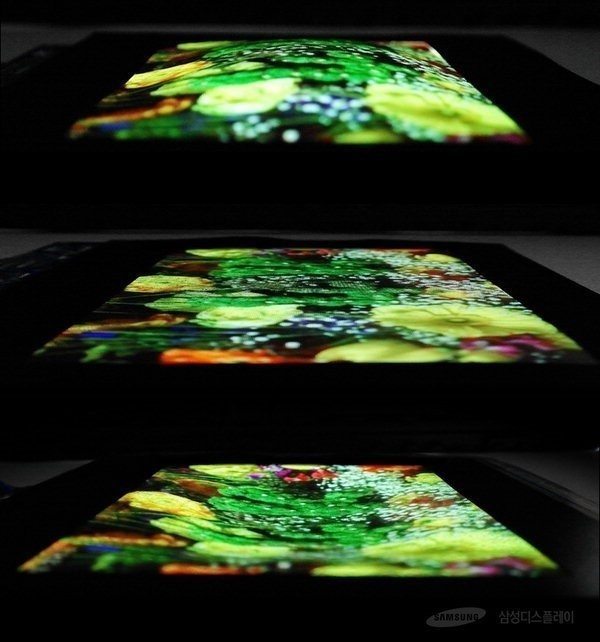
<9.1 inch stretchable OLED displayed by Samsung Display, Source: Samsung Display>
LG Display will also develop the stretchable OLED. LG Display announced on June 6 that it will develop backplane and photoluminescence materials, devices, and process source technologies with elasticity of more than 20% for a total of four years through a consortium with Korea University.
In addition, LG Display has developed flexible plastic substrate materials, flexible wiring materials and transparent electrode materials, stretchable organic light emitting materials, and flexible encapsulates, they will also acquire essential process technologies including thin film transistors (TFTs) and process architectures that enable low-temperature processing.
At present, stretchable related technology is not yet applied to production, or elongation is only about 5%, and the number of repeated stretching is limited. In addition, most of the source technology is in overseas, it is expected that Samsung Display and LG Display will be able to secure technological gap with latecomers.
Stretchable OLED is free of form restrictions and expected to produce applications in new areas when applied to a variety of applications such as smart phones, tablets clothes and human skin when they are commercialized.
영문 풋터
UBI RESEARCH / CEO:Choong Hoon Yi / Business License Registration Number 220-87-44660
ADDRESS: A-1901, Samho Moolsan Bldg, 83, Nonhyeon-ro, Seocho-gu, Seoul, Republic of Korea (Zip) 06775 TEL:+82-2-577-4390 / E-MAIL:marketing@ubiresearch.com

